- • Prof. Dr. hab. Maciej Sawicki - Task 2.16 - Visit from HZDR (Dresden)
In the framework of the task 2.16 of the work package "Enhancing of human potential through exchange of know-how and twinning activities with partnering organization", Ms. Mao Wangr from HZDR (Dresden) visited the Institute in the period of September 3rd – 11th, 2016.
 Ultraclean semiconductors are by definition unable to superconduct because at low temperatures there are too few carriers available to condense into the superconducting state. In principle, one could introduce enough charge carriers into a semiconductor, say by chemical doping. However, the necessary doping is so high that it often damages the semiconductor itself. The method of choice in this case is to use ion implantation to introduce the necessary high concentration of dopants within a thin top layer. However, heavy ion implantation severely damages the local lattice structure of the crystal. The challenge is to therefore reconstruct the crystal structure by annealing, without causing the dopants to diffuse away, float to the surface, or cluster. It is achieved by using a specialized technique called flash-lamp annealing (FLA) which employs short but intense light pulses.
Ultraclean semiconductors are by definition unable to superconduct because at low temperatures there are too few carriers available to condense into the superconducting state. In principle, one could introduce enough charge carriers into a semiconductor, say by chemical doping. However, the necessary doping is so high that it often damages the semiconductor itself. The method of choice in this case is to use ion implantation to introduce the necessary high concentration of dopants within a thin top layer. However, heavy ion implantation severely damages the local lattice structure of the crystal. The challenge is to therefore reconstruct the crystal structure by annealing, without causing the dopants to diffuse away, float to the surface, or cluster. It is achieved by using a specialized technique called flash-lamp annealing (FLA) which employs short but intense light pulses.
Ms Mao brought from HZDR a range of Ga and Al implanted Ge crystals annealed by FLA at different pulse duration and fluency. After electrically contacting the samples using pure indium and gold wires she placed them in sample carriers (standard 8-pin integrated circuit sockets) which were plugged into a matching sockets already preinstalled in the sample puck of the Triton 400 dilution refrigeration unit purchased by IPAN from EAgLE’s equipment budget and placed at the Laboratory of Cryogenic and Spintronic Research. Importantly, all the necessary wiring was also soldered using pure indium to avoid heat generation at very low temperatures due to type II superconducting nature of other common soldering compounds, like Sn-Pb one.
The measurements were performed in two modes: as a function of temperature at zero external field, and at constant temperature (20, 100, 200 and 300 mK) as a function of the magnetic field. To avoid Joule heating due to generation of the eddy currents the magnetic field sweeps had to be very slow, approaching 5 hours per 1 T at the lower T = 20 mK. The observed strong minimum of the resistivity at H = 0 deepening with lowering temperature confirm the existence of the superconductivity in heavily Ga-doped Ge, however some small hysteresis observed at weak fields calls for more elaborated studies and further refinements of the experimental routine. The gathered results will constitute the base for join HZDR-IFPAN publication.
- • Prof. Dr. hab. Wojciech Paszkowicz - Task 2.1 - Visit from Elettra Sincrotrone, Trieste, Italy
In the framework of the task 2.1 of the work package "Enhancing of human potential through exchange of know-how and twinning activities with partnering organization", Dr. Jasper Plaisier from Elettra Sincrotrone, Trieste, Italy visited the Institute in the period of August 28th – September 3rd, 2016.
The visit of Dr. Plaisier enabled dissemination of information on the equipment of MCX diffraction beamline at ELETTRA and its instrumentation. His lecture entitled "MCX: A multipurpose powder diffraction station at ELETTRA", given on 30th August, 2016 at IFPAN presented a basic information about the principles of work and instrumentation of MCX, various experimental opportunities and settings. The lecture provided illustrative examples of application of various settings. During the visit, Dr. Plaisier exploited the opportunity of acquainting the staff of the SL1.3 laboratory with the X-ray diffraction equipment, in particular with the high-resolution X’Pert diffractometer. Moreover, discussion with the scientific staff of other Institute of Physics laboratories equipped for studies of magnetism, biological physics, atomic layer deposition, X-ray photoelectron spectroscopy and Raman and luminescence studies took place. During these discussions, the applicability of synchrotron X-ray diffraction was the main issue.
- • Dr. Marcin Klepka - Task 2.1 - Visit from Elettra Sincrotrone, Trieste, Italy
In the framework of the task 2.1 of the work package "Enhancing of human potential through exchange of know-how and twinning activities with partnering organization", Dr. Giuliana Aquilanti from Elettra Sincrotrone, Trieste, Italy visited the Institute in the period of August 28th – September 2nd, 2016.
Dr. Giuliana Aquilanti is the head of XAFS beamline at Elettra facility. The present visit was a continuation of the collaboration in the field of X-ray absorption spectroscopy aiming at experiment and data analysis on silver complexes with coumarin derivatives. The visit was devoted to two subjects: (i) working on final version of a manuscript, (ii) working on data analysis of the recently measured complexes.
 The manuscript is devoted to structural analysis of the Cu(II) complexes of 7-hydroxycoumarin derivatives in DMSO and DMF solutions. The measurements were performedat the XAFS beamline, which is under Dr. Aquilanti supervision, during one of the previous visits at Elettra. After final suggestion from Dr. Aguilanti the paper was successfully submitted to the Journal of Inorganic Biochemistry.
The manuscript is devoted to structural analysis of the Cu(II) complexes of 7-hydroxycoumarin derivatives in DMSO and DMF solutions. The measurements were performedat the XAFS beamline, which is under Dr. Aquilanti supervision, during one of the previous visits at Elettra. After final suggestion from Dr. Aguilanti the paper was successfully submitted to the Journal of Inorganic Biochemistry.
The second part of the visit was focused on the data analysis of the Ag complexes of similar systems. The data had been recently measured during in house experiment at the XAFS beamline. The analysis was performed for one sample of the series. We have managed to find the model which corresponds to the structure of the complex. In the figure model of the found structure is presented.
Below, on the left the best EXAFS fit is presented. On the right the XANES spectrum of the analyzed complex is compared with the result of the FEFF9.6 calculation for selected model. The agreement is reasonable, however since XANES is sensitive to the spatial arrangements of the atoms, the model still needs additional adjustments.
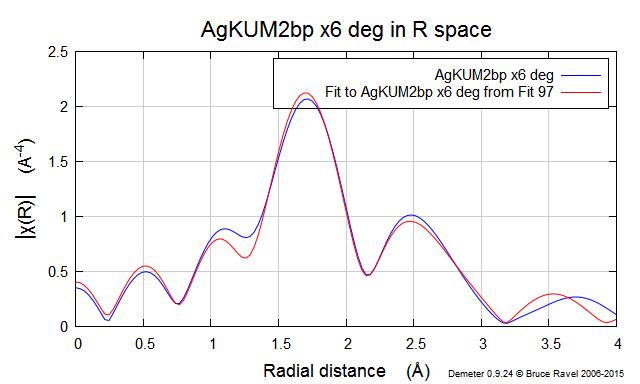
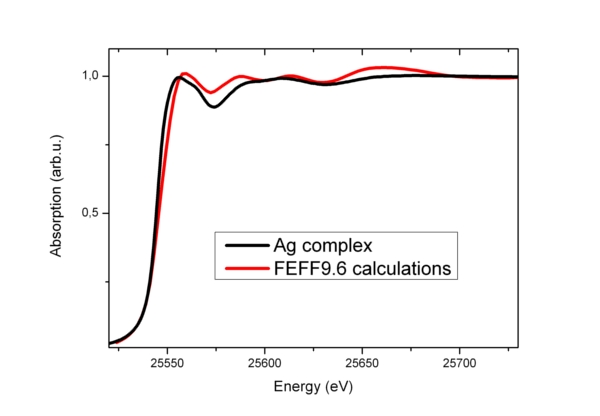
- • Dr. hab. Sławomir Kret - Task 2.3 - Visit from University of Warwick, Coventry, UK
In the framework of the task 2.3 of the work package "Enhancing of human potential through exchange of know-how and twinning activities with partnering organization", Dr. Jeremy Sloan from University of Warwick, Coventry, UK visited the Institute in the period of August 16th – 25th, 2016.
During his visit Dr. Jeremy Sloan continued started in his previous visit in March 2015 investigation of carbon nanotubes filled with chains of atoms forming one dimensional crystals of Sb2Te3. This particular one dimensional crystals can change the crystalline structure under heat or electron beam. TEM specimens were prepared in our preparation lab starting from original quartz ampule. The nanotubes were applied to the copper grids coated with a thin carbon film. The nanotubes were investigated on JEOL 2000EX (200 kV) microscope which is a perfect tool for acquiring diffraction patterns from single bundles of nanotubes. Diffraction patterns were registered on photographic plates which have the property of logarithmic scalability of intensity, thus allowing to obtain good signal-to-noise ratio. Scanned plates will be analysed to check for presence of features characteristic for both carbon nanotube and filling. Conclusions will help to determine what is the crystal structure of Sb2Te3 filling inside the carbon nanotube and to determine its degree of amorphization or recrystallization.
- • Prof. Dr. hab. Lech T. Baczewski - Task 2.16 - Visit from HZDR (Dresden)
In the framework of the task 2.16 of the work package "Enhancing of human potential through exchange of know-how and twinning activities with partnering organization", Dr. Rantej Bali from HZDR (Dresden) visited the Institute in the period of July 27th – August 1st, 2016.
The Ion Beam Center in HZDR provides experimental facilities with all kinds of ion beams, i. e. highly accelerated charged particles, in a broad energy range for the compositional analysis of materials and the modification of materials properties either by doping or by radiation damage and its personnel has a long lasting experience in such techniques. The research aiming towards potential applications in nanoelectronics, optoelectronics, spintronics, and photovoltaics are of particular interest. Dr Bali explained in details the specific experimental procedures related to Ar and Ne ions irradiation using duoplasmotron ion source which is used at IFPAN’s MBE system in one of the chambers.
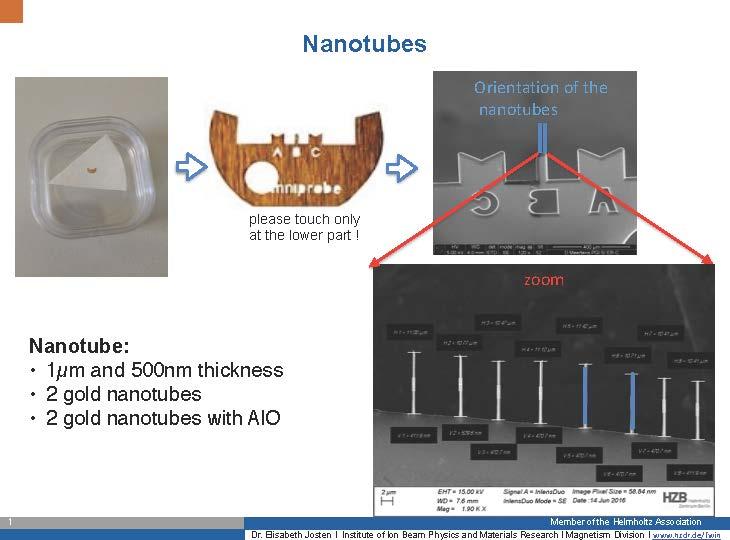 During the visit of Dr. Bali the new nanowire structures were prepared. On the Omniprobe holder (see the figure) several nanotubes prepared from Au and Au/AlO were transferred from the sample by use of a FIB technique and micromanipulator. The length of the nanotube was 10 microns and diameters were either 1 micron, 500 nm or 300 nm. Next in the MBE deposition chamber Co layer was overgrown around the nanotubes. The new method of the Omniprobe holder mounting on a molyblock was developed. As a result the core/shell Au/Co and Au/AlO/Co nanotube structures were obtained which constitute a very interesting model structure for magnetic anisotropy studies. Another step is the FMR and BLS measurements of such nanotubes structures where the individual nanotube is transferred from the Omniprobe holder into the measurement cavity using a special micromanipulator of very high precision. AlO layer on the Au nanotube was deposited in order to limit the heat transfer into a metallic nanotube by the laser beam during the BLS experiment.
During the visit of Dr. Bali the new nanowire structures were prepared. On the Omniprobe holder (see the figure) several nanotubes prepared from Au and Au/AlO were transferred from the sample by use of a FIB technique and micromanipulator. The length of the nanotube was 10 microns and diameters were either 1 micron, 500 nm or 300 nm. Next in the MBE deposition chamber Co layer was overgrown around the nanotubes. The new method of the Omniprobe holder mounting on a molyblock was developed. As a result the core/shell Au/Co and Au/AlO/Co nanotube structures were obtained which constitute a very interesting model structure for magnetic anisotropy studies. Another step is the FMR and BLS measurements of such nanotubes structures where the individual nanotube is transferred from the Omniprobe holder into the measurement cavity using a special micromanipulator of very high precision. AlO layer on the Au nanotube was deposited in order to limit the heat transfer into a metallic nanotube by the laser beam during the BLS experiment.
Another issue discussed during Dr. Bali visit was the ion beam irradiation experiment on Fe/Pt multilayers grown at IFPAN which is scheduled to be performed at HZDR in the nearest future. Common publication will be prepared. In the context of this experiment methods of beam-time application forms preparation were also discussed to increase the success rate for ion beam irradiation time.In summary, an extended knowledge about ion irradiation method and related effects in metallic thin films has been gained. Also (i) practical aspects and problems related to Ar and Ne ion irradiation using duoplasmotron source were discussed; (ii) perspectives of common projects and scientific collaboration were set; (iii) areas of common applications for beam-time at large facilities, what largely increases the success rate, were established. Finally, studies of the core/shell magnetic nanowires and nanotubes were performed and their potential applications were discussed.
- • Dr. Ryszard Sobierajski - Task 2.1 - Visit from Elettra Sincrotrone, Trieste, Italy
In the framework of the task 2.1 of the work package "Enhancing of human potential through exchange of know-how and twinning activities with partnering organization", Dr. Fabio Brigidi from Elettra Sincrotrone, Trieste, Italy visited the Institute in the period of July 11th – 15th, 2016.
During his stay Dr. Brigidi continued presentation his software - GIMPy (acronym for Grazing Incidence Material analyses with Python) designed for the simulation of Grazing Incidence X-ray Fluorescence (GIXRF) profiles. GIXRF returns information about the depth distribution of the elements in an unknown sample, by exploiting the modulations of the electric field amplitude propagating inside the sample that occurs with the variation of the angle of incidence of the incoming X-ray beam. The software package was recently upgraded for the special case of Pt/Co/Pt magnetic trilayers modified with laser irradiations and characterized by means of XRR and GI XRF techniques at Elettra synchrotron in Trieste. Simulations were performed for data obtained with reference samples and are a base for further data analysis.
- • Dr. Ryszard Sobierajski - Task 2.14 - Visit from Eu-XFEL, Hamburg, Germany
In the framework of the task 2.14 of the work package "Enhancing of human potential through exchange of know-how and twinning activities with partnering organization", Mr. Wojciech Gawelda from Eu-XFEL, Hamburg, Germany visited the Institute in the period of July 11th – 14th, 2016.
The visit was devoted to the work on the grant proposal for the Ministry of Science and Higher Education within the call for “Activities related to the use of the strategic research infrastructure placed abroad”. The tentative title of the grant is “Enhancing the scientific value of the Polish research at Eu-XFEL“. It regards the support for the studies leading to the submission of research proposals for the Eu-XFEL of high scientific value. Attachments describing (1) the Eu-XFEL facility, including experimental stations and methods, (2) scientific cases of research at Eu-XFEL by Polish groups, (3) previous studies at Eu-XFEL of Polish scientist were prepared. It was further discussed with the editors of the grant proposal. The proposal is supposed to be submitted in October 2016. It will constitute a base for funding the future research project at Eu-XFEL.
- • Dr. Maciej Zgirski - Task 2.9 - Visit from Aalto University, Espoo, Finland
In the framework of the task 2.9 of the work package "Enhancing of human potential through exchange of know-how and twinning activities with partnering organization", Dr. Alexander Savin from Aalto University, Espoo, Finland visited the Institute in the period of July 6th – 17th, 2016.
During the visit a few temperature relaxation measurements of the Aluminum superconducting wire were performed. The aim of the experiment in the Triton dilution refrigerator was to to perform the proof-of-concept benchmarking of the new nanoscale thermometer allowing to measure effective temperature with unprecedented temporal resolution (down to a single nanosecond). The results will be subject of the upcoming publication.
The vast part of the Aleksander Savin visit was devoted to technical developments of a measuring apparatus both in the Triton and Heliox refrigerators. Dr Savin gave a training how to solder Thermocoaxes to different standard SMA and SMP connectors – knowledge which is indispensable to get rid of RF noise and provide ultra-low temperature at the sample stage of a millikelvin refrigerator. A considerable amount of time was spent also on the design of a new sample holder that will provide good low-noise characteristics and versatility to carry out electrical transport investigations in a wide range of studied materials and structures.
A standard RuOx thermometer got embedded in a small RF-filtered holder. It will be calibrated on the mixing plate of the Triton dilution refrigerator down to 10mK prior to installation in the sample puck. It will make it possible to measure temperature at the sample position directly.
The visit of Aleksander Savin coincided with conclusion of the 2nd stage of FNP grant application. It is the grant in which A. Savin’s home institution had been proposed to be a scientific partner. I was invited to the final stage of the competition to discuss my project with panel of experts. Aleksander Savin aided my preparation to interview. The FNP First Team grant “Stochastic thermometry with Josephson junction down to nanosecond resolution” has been awarded.
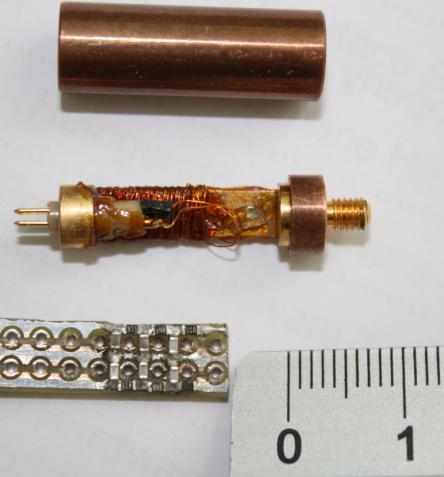
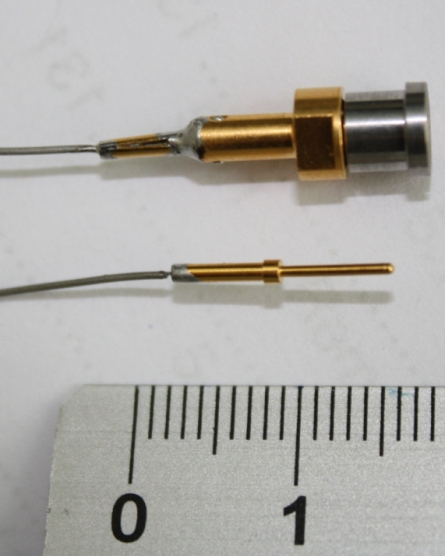
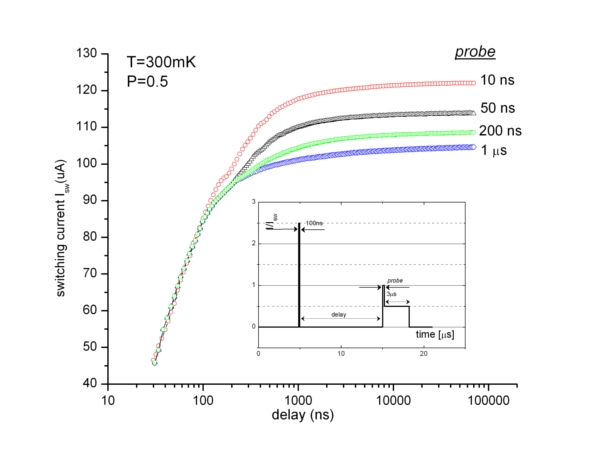
 Fig.1.
Fig.1. Fig.2.
Fig.2. Fig.3
Fig.3
Fig.1. RF-filtered thermometer assembly.
Fig.2. Thermocoax soldered to standard connectors.
Fig.3. Thermal relaxation of a superconducting nanowire revealing nanosecond resolution of the new thermometer.
- • Prof. Dr. hab. Tomasz Dietl - Task 2.8 - Visit from Halbleiter-und-Festkörperphysik, Johannes Kepler Universität, Austria
In the framework of the task 2.8 of the work package "Enhancing of human potential through exchange of know-how and twinning activities with partnering organization", Prof. Alberta Bonanni from Halbleiter-und-Festkörperphysik, Johannes Kepler Universität, Austria visited the Institute in the period of June 22nd – 24th, 2016.
Besides their indisputable significance for optolectronics and high power electronics, gallium nitride (GaN) and related alloys possess also a number of features attractive for spin-orbitronics, enabling, in particular, spin-charge interconversion via spin-orbit coupling associated with inversion asymmetry and leading to a sizable Rashba field and piezoelectric properties.
During her visit Prof. Bonnani met with Profs T. Dietl and M. Sawicki of Laboratory of Cryogenic and Spintronic Research and presented recent results obtained in her group for degenerate n-doped wurtzite GaN:Si films covered with permaloy for which a generation of pure spin current at room temperature and through spin pumping effect was demonstrated.
Additionally, the discussion were curried about a direct electrical control of the magnetization in wurtzite (Ga,Mn)N. During the joint IFPAN-JKU studies it has been established that (Ga,Mn)N sustains an electric field up to at least 5 MV/cm, indicating that Mn doping turns GaN into a worthwhile semi-insulating material. Under these conditions, the magnetoelectric coupling is driven by the inverse piezoelectric effect that stretches the elementary cell along the c-axis and, thus, affects the magnitude of the magnetic anisotropy. The paper on these achievement was substantially advanced during this visit.
- • Dr. Ryszard Sobierajski - Task 2.14 - Visit from Eu-XFEL, Hamburg, Germany
In the framework of the task 2.14 of the work package "Enhancing of human potential through exchange of know-how and twinning activities with partnering organization", Dr. Peter Zalden from Eu-XFEL, Hamburg, Germany visited the Institute in the period of June 5th – 8th, 2016.
During his visit at IF PAN, Dr. Peter Zalden presented a talk “Ultrafast X-ray diffraction resolves transient structures upon crystallization of Phase-Change Memory Materials”. He introduced the working principle of phase-change memory with special attention to the underlying materials' properties. Discussing basic glass formation, he outlined the unique kinetics of phase-change materials and explained how XFELs can be used to study glass formation and crystallization dynamics in unprecedented detail.
Dr. Zalden discussed with Dr. R. Sobierajski results of the resent common experiments of the crystallization dynamics in glasses by means of X-ray diffraction at P08 beamline at PETRA synchrotron facility. The studied sample was Cu3Al amorphous metal. A lot of useful information emerged from the data analysis of the x-ray diffraction images related to the formation of the nanocrystallites in the laser annealed sample. It was found that femtosecond laser pulses induced progressive devitrification of the glassy ribbons.
Finally, new research project at PETRA synchrotron facility regarding the crystallization kinetics of metallic glasses via femtosecond laser heating and its possible continuation at Eu-XFEL facility were discussed with Dr. Sobierajski.
- • Prof. Dr. hab. Wojciech Paszkowicz - Task 2.2 - Visit from The European Synchrotron (ESRF), Grenoble, France
In the framework of the task 2.2 of the work package "Enhancing of human potential through exchange of know-how and twinning activities with partnering organization", Dr. Jurgen Härtwig from European Synchrotron (ESRF), Grenoble, France, visited the Institute in the period of April 2nd – 29th, 2016.
The visit of Dr. Härtwig enabled a continuation of dissemination of information on the equipment of ESRF X-ray Optics Laboratory, in particular about the BM05 beamline and its instrumentation, studies on the use of X-ray optics, on application of diamond crystals in electronics and on methods of X-ray topography.
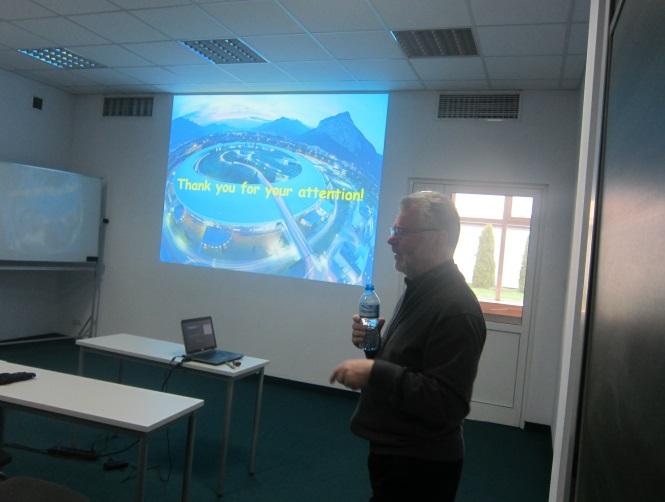 The main contribution was a series of four 90 min lectures under a common title “Introduction into the Dynamical Theory of X-ray Diffraction for Perfect Crystals” (14 IV, 19 IV, 21 IV, 26 IV 2016). This series of four lectures presented a basic information about the principles of the dynamical theory of diffraction, being intended for students and PhD students. In the introduction, the “kinematical (or geometrical) theory of X-ray diffraction” was compared to the “dynamical theory of X-ray diffraction”. The physical meaning of those two kinds of theory was analysed. The theoretical background of the dynamical theory of X-ray diffraction for perfect crystals was presented. Some typical effects explainable only the theory of dynamical X-ray diffraction, such as thee “Pendellösung length”, the “Pendellösung effect”, and the “Borrmann effect”. The dynamical diffraction theory is valid for X-rays, for electrons, neutrons and other waves/ particles. It is of importance for analysis, and modelling of diffraction and diffraction imaging experiments.
The main contribution was a series of four 90 min lectures under a common title “Introduction into the Dynamical Theory of X-ray Diffraction for Perfect Crystals” (14 IV, 19 IV, 21 IV, 26 IV 2016). This series of four lectures presented a basic information about the principles of the dynamical theory of diffraction, being intended for students and PhD students. In the introduction, the “kinematical (or geometrical) theory of X-ray diffraction” was compared to the “dynamical theory of X-ray diffraction”. The physical meaning of those two kinds of theory was analysed. The theoretical background of the dynamical theory of X-ray diffraction for perfect crystals was presented. Some typical effects explainable only the theory of dynamical X-ray diffraction, such as thee “Pendellösung length”, the “Pendellösung effect”, and the “Borrmann effect”. The dynamical diffraction theory is valid for X-rays, for electrons, neutrons and other waves/ particles. It is of importance for analysis, and modelling of diffraction and diffraction imaging experiments.
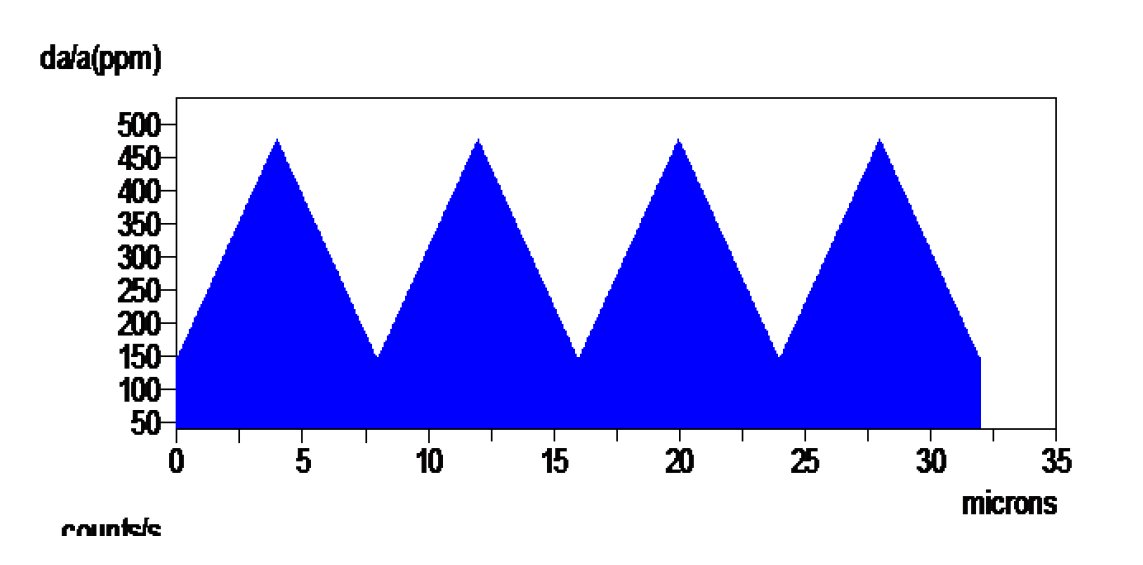 During the stay, X-ray diffraction experiments using high-resolution diffraction (HRD) were performed. They aimed for determination and analysis of the defect structure of thin diamond films deposited by chemical methods on artificial diamond single crystals. The initial observations reassured us that parts of substrate labelled by topography as defected ones, influenced the layer strain. Another subject investigated, for Si samples implanted by boron atoms, by high-resolution diffraction was a determination of strain distribution in a direction vertical to the surface (figure: vertical strain distribution, in 10-6 units) for a boron implanted silicon single crystal as well as its homogeneity along the surface.
During the stay, X-ray diffraction experiments using high-resolution diffraction (HRD) were performed. They aimed for determination and analysis of the defect structure of thin diamond films deposited by chemical methods on artificial diamond single crystals. The initial observations reassured us that parts of substrate labelled by topography as defected ones, influenced the layer strain. Another subject investigated, for Si samples implanted by boron atoms, by high-resolution diffraction was a determination of strain distribution in a direction vertical to the surface (figure: vertical strain distribution, in 10-6 units) for a boron implanted silicon single crystal as well as its homogeneity along the surface.
In conclusion, it was found that to get an improved vertical strain distribution, it is necessary to use a 4-bounce Ge(440) monochromator (Fig.3). A glue-based sample mounting was found to become an important strain source influencing the Si crystal homogeneity (Fig. 4). Moreover, the results of topography on oxide and nitride crystals performed in ESRF during a previous stay were analysed in order to recognize the nature of their defect structure.
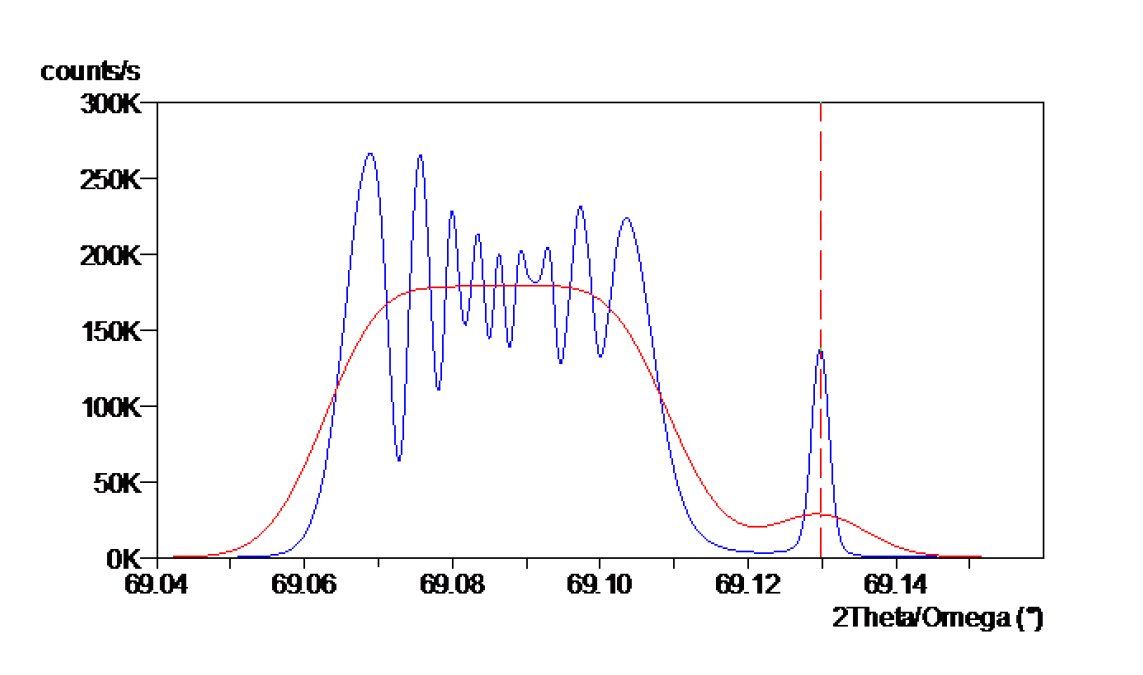
Fig. 3. 2θ/ω scan for 004 reflection for a boron implanted silicon single crystal. Blue curve – measured with four bounce Ge(440) monochromator, red one – with four bounce Ge(220) monochromator.
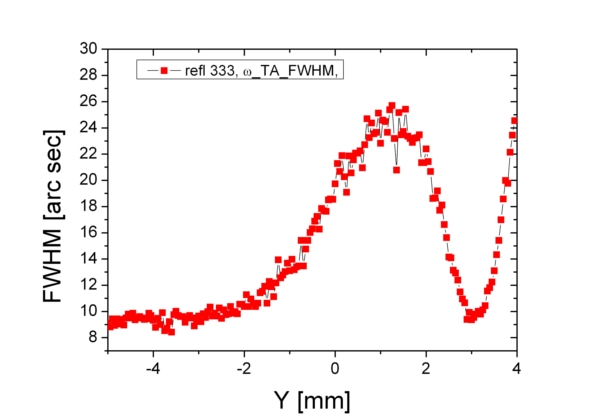
Fig. 4. Variation of FWHM of 333 reflection across the Si sample (the ω scans were measured with analyser in front of detector)
- • Prof. Dr. hab. Maciej Sawicki - Task 2.16 - Visit from HZDR Helmholtz Centrum Dresden Rossendorf Institute of Ion Beam Physics and Material Research
In the framework of the task 2.16 of the work package "Enhancing of human potential through exchange of know-how and twinning activities with partnering organization", Mr. Ye Yuan from HZDR Helmholtz Centrum Dresden Rossendorf Institute of Ion Beam Physics and Material Research, visited the Institute in the period of March 21st – April 22nd, 2016.
The aim of the visit was to update IFPAN scientists with the strip-line technique to detect ferromagnetic resonances below 1 K in III-V semiconductors implanted with Mn and Fe and to prepare a new joint publication.
 Laboratory of Cryogenic and Spintronic Research of the Institute of Physics has been equipped as a part of the EAgLE project with Triton 400 dilution refrigerator allowing to perform measurements at temperatures well below 1 K. This in turn opened a possibility to start a new kind of magnetic research – detection of ferromagnetic resonance using the strip-line technique with a Vector Network Analyzer as a frequency sensitive resonance detection at ultra-low temperatures. The visit of Mr Yuan from HZDR gave us a possibility to use his knowledge and expertise in this field of activity, as well as to test the method on various III-V semiconductors implanted with either Mn or Fe. These materials are the subject of ongoing extensive research effort of both IFPAN and HZDR. The measurements in Triton were performed with Dr. Maciej Zgirski. They collected multiple scans as a function of magnetic field for constant microwave frequency and at constant field as a function of frequency up to 20 GHz. Since the vector magnet of Triton allows for spacious rotations of the magnetic field orientation, the field scans at constant f were performed for multiple field directions. The measurements were performed also as a function of temperature between 20 mK to 10 K. However, no clear indication of a resonance was found. On the advice of Mr Yuan, so called “cold” wide band-pass amplifiers will be installed inside the Triton to boost gain of the detection system.
Laboratory of Cryogenic and Spintronic Research of the Institute of Physics has been equipped as a part of the EAgLE project with Triton 400 dilution refrigerator allowing to perform measurements at temperatures well below 1 K. This in turn opened a possibility to start a new kind of magnetic research – detection of ferromagnetic resonance using the strip-line technique with a Vector Network Analyzer as a frequency sensitive resonance detection at ultra-low temperatures. The visit of Mr Yuan from HZDR gave us a possibility to use his knowledge and expertise in this field of activity, as well as to test the method on various III-V semiconductors implanted with either Mn or Fe. These materials are the subject of ongoing extensive research effort of both IFPAN and HZDR. The measurements in Triton were performed with Dr. Maciej Zgirski. They collected multiple scans as a function of magnetic field for constant microwave frequency and at constant field as a function of frequency up to 20 GHz. Since the vector magnet of Triton allows for spacious rotations of the magnetic field orientation, the field scans at constant f were performed for multiple field directions. The measurements were performed also as a function of temperature between 20 mK to 10 K. However, no clear indication of a resonance was found. On the advice of Mr Yuan, so called “cold” wide band-pass amplifiers will be installed inside the Triton to boost gain of the detection system.
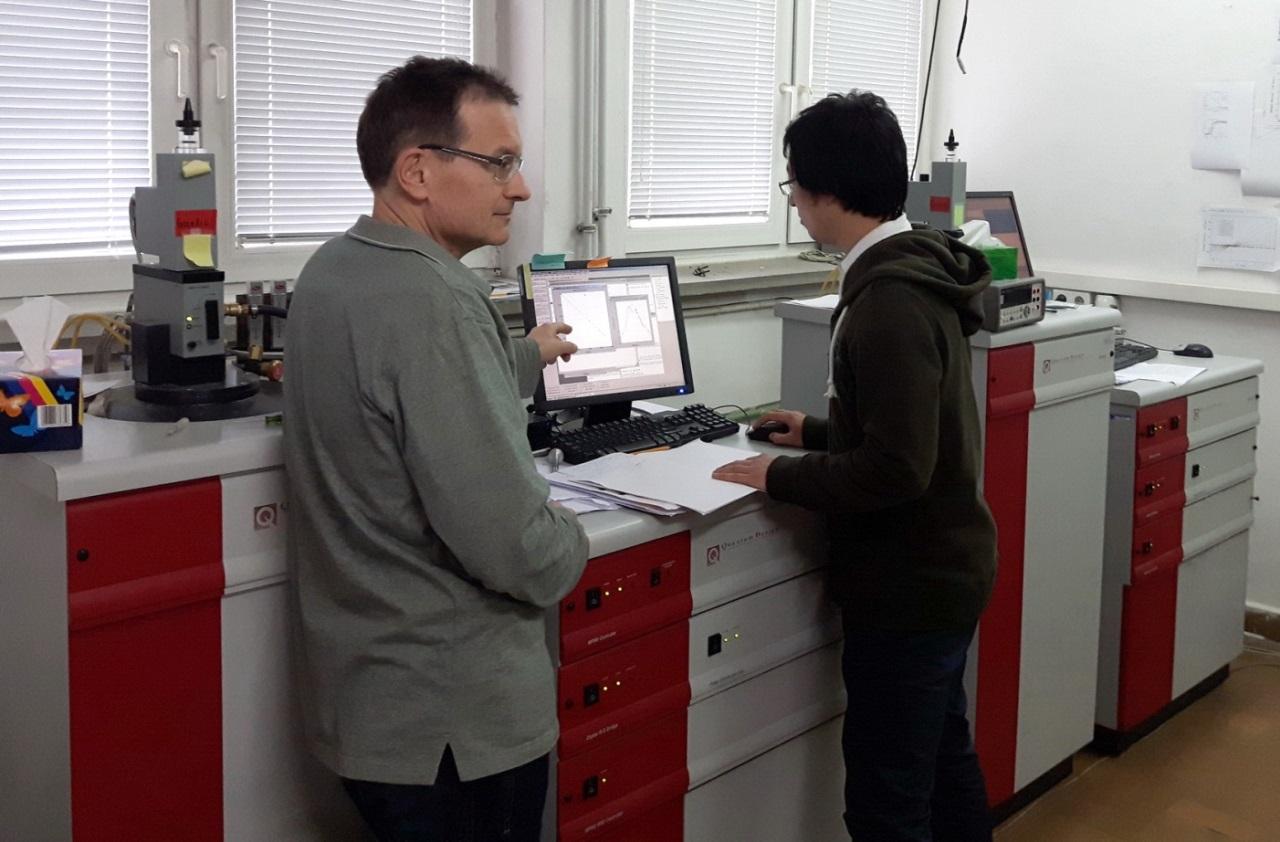 Apart of extremely low temperature FMR experiments Mr. Yuan performed also with Prof. Maciej Sawicki SQUID magnetometry measurements of GaMnAsP samples which were irradiated with He atoms to reduce hall concentration due to radiation damage created compensation centers. These layers exhibit very interesting dependence of the magnetic anisotropy on the fluency of He irradiation. In particular, the native out-of plane magnetic anisotropy of the non-irradiated layer gradually gives way to an in-plane magnetic anisotropy. Mr. Yuan suggested the most appropriate way of investigation of this phenomenon and together with Prof. Sawicki the relevant measurements were undertook. The obtained results proves so interesting that it was agreed that the joint investigation will continue and a basis structure of an additional paper has been drafted and it is expected to get published later this year.
Apart of extremely low temperature FMR experiments Mr. Yuan performed also with Prof. Maciej Sawicki SQUID magnetometry measurements of GaMnAsP samples which were irradiated with He atoms to reduce hall concentration due to radiation damage created compensation centers. These layers exhibit very interesting dependence of the magnetic anisotropy on the fluency of He irradiation. In particular, the native out-of plane magnetic anisotropy of the non-irradiated layer gradually gives way to an in-plane magnetic anisotropy. Mr. Yuan suggested the most appropriate way of investigation of this phenomenon and together with Prof. Sawicki the relevant measurements were undertook. The obtained results proves so interesting that it was agreed that the joint investigation will continue and a basis structure of an additional paper has been drafted and it is expected to get published later this year.
- • Dr. Ryszard Sobierajski - Task 2.14 - Visit from Eu-XFEL, Hamburg, Germany
In the framework of the task 2.14 of the work package "Enhancing of human potential through exchange of know-how and twinning activities with partnering organization", Mr. Wojciech Gawelda from Eu-XFEL, Hamburg, Germany visited the Institute in the period of March 21st – 24th, 2016.
The visit was devoted to the continuation of discussion about possible scientific collaboration. Series of meetings with possible partners – in particular Dr. Jerzy Antonowicz from Faculty of Physics Warsaw University of Technology - have been organized. It evolved into formulation of a common research project that could be realized by means of the Femtosecond X-ray Experiments (FXE), at the European XFEL GmbH in Hamburg. The project is related to the studies of the crystal to amorphous phase transitions in metals. Pump-probe experiment have been proposed. The femtosecond laser would be used to anneal metallic sample to trigger its phase transition while the X-ray diffraction and X-ray scattering techniques would be applied to investigate the dynamics of the sample structure transformation. Because the time scale of the some of the studied processes is in the range of picoseconds, the only available source of femtosecond x-ray pulses could be x-ray free electron laser like Eu-XFEL.
- • Dr. hab. Sławomir Kret - Task 2.3 - Visit from Department of Physics, University of Warwick, Coventry, Great Britain
In the framework of the task 2.3 of the work package "Enhancing of human potential through exchange of know-how and twinning activities with partnering organization", Mr. Richard Beanland from Department of Physics, University of Warwick, Coventry, Great Britain, visited the Institute in the period of March 11th – 20th, 2016.
During his visit R. Beanland together with IFPAN staff and IFPAN PhD Student demonstrated setup of the acquisition and Digital Scanning Diffraction technique on the Titan microscope. This technique was applied to the analysis of the local mosaique blocks misorientation in epitaxial layers of AlGaN on GaN.
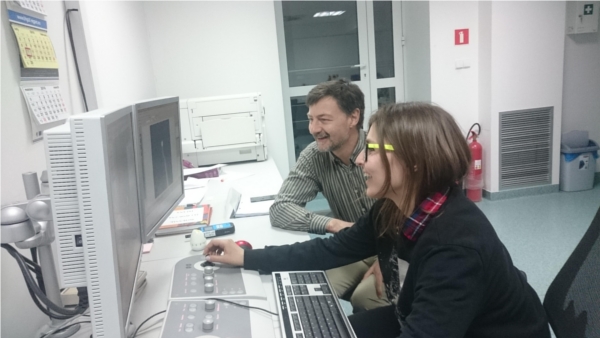
Fig. Richard Beanland and Anna Kaleta working together on Titan Microscope.
Additionally the post-processing software was adopted to correct artefacts in stack of diffraction patterns obtained for many thousands of electron beam positions. Correction of the effect of diffraction shift due to variations of incident angle of electron beam during scanning across the area of interest was performed. The aligned stack of data was prepared for future analysis.
- • Dr. hab. Sławomir Kret - Task 2.3 - Visit from Department of Physics, University of Warwick, Coventry, Great Britain
In the framework of the task 2.3 of the work package "Enhancing of human potential through exchange of know-how and twinning activities with partnering organization", Dr. Jeremy Sloan from Department of Physics, University of Warwick, Coventry, Great Britain, visited the Institute in the period of March 11th – 20th, 2016.
During his visit Dr. Jeremy Sloan participated in investigation of carbon nanotubes filled with chains of atoms which are forming one dimensional crystals of GeTe and Sb2Te3. First part of the investigation was conducted with the use of Titan Cubed 80-300 which operates at the accelerating voltage of 300 kV. The STEM method was used as the main technique for imaging nanotubes on Titan instrument. It was expected that in this mode the degeneration of nanotubes would not be as rapid as in the conventional HRTEM imaging. Unfortunately the nanotubes were still damaging very quickly and not many high quality STEM images were acquired.
The second part of the investigation involved using JEOL 2000EX (200 kV) microscope for acquiring diffraction patterns from single bundles of nanotubes filled with chains of GeTe and Sb2Te3. For the reference the diffraction patterns from a sample with unfilled nanotubes were acquired.
The results obtained from the diffraction experiment are much more promising. Below one can see two diffraction patterns: first one corresponds to the bundle of unfilled nanotubes and the second one to the nanotubes with GeTe crystal chains inside. On each of the patterns there are some characteristic details. Sharp rings correspond to the comprehensive scattering from bundle of carbon nanotubes. Bright equatorial line which crosses the middle of both diffraction patterns corresponds to the texture of parallel cylinders on the walls of approximately parallel nanotubes (the equatorial line is perpendicular to the direction of the bundle). On the second image there is an additional effect - the crystals inside of the nanotubes give rise to four characteristic, small streaks appearing around the central spot (they are marked with black arrows). The distances between the symmetric pairs of streaks depend on the type of the filling: GeTe or Sb2Te3.
Next thing to do is to check if the obtained dffraction patterns are compatible with high resolution TEM images of the same samples. Acquisition of HRTEM images will be conducted with the use of 200 kV JEOL ARM 200F microscope which is located at University of Warwick.
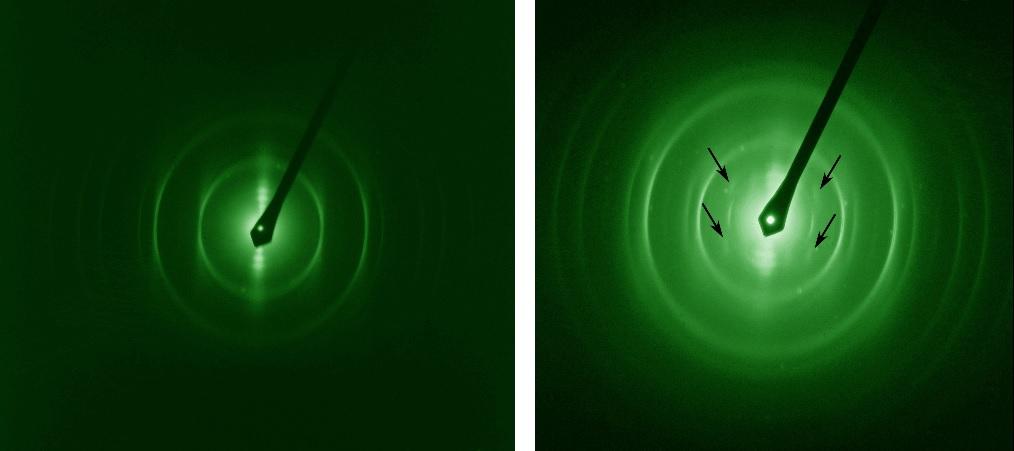
 (a)
(a) (b)
(b)
Fig. 1. Electron diffraction patterns obtained from single bundles of (a) unfilled carbon nanotubes and (b) nanotubes
filled with chains of GeTe atoms.
- • Dr. hab. Sławomir Kret - Task 2.3 - Visit from Department of Physics, University of Warwick, Coventry, Great Britain
In the framework of the task 2.3 of the work package "Enhancing of human potential through exchange of know-how and twinning activities with partnering organization", Dr. Ana Sanchez from Department of Physics, University of Warwick, Coventry, Great Britain, visited the Institute in the period of March 11th – 20th, 2016.
The series of STEM/HAADF/EDS experiments was performed together with A. Sanchez, PhD student A. Kaleta and S. Kret for the homogeneously bismuth-doped nanowires with 10 nm thick GaAsBi shell. Significant progress was achieved in optimization of measurement of Bi element concentration in such complex heterostructures. Geometric factor related to the shape of NWs and their position regarding to the detector was intensively studied. It was found that the self-shadowing of nanowires has big impact on the quantification of the elements in the complex 3D object such as the nanowire. Using the 20 mm2 EDS detector and sub-nanometric electron beam the resolution of bismuth qualitative element distribution maps can be obtained with near 2 nm resolution. Much effort was taken to find the optimal geometry of EDS experiment. It was found that during the experiment the electron beam should be parallel to the shell/core interface of the nanowires. Additionally the investigated shell should be on the side of the detector and in the optimal take-off angle regarding to detector plane. In the case of high temperature growth of NWs the incorporation of Bi into the core was found to be below the sensibility level of EDS detector installed in IFPAN’s Titan microscope. In the case of the GaAsBi shell it was proved that locally the Bi concentration reach 5at% in relation to As. However the distribution of Bi is inhomogeneous at nanomeric scale. Moreover the redistribution of the Bi atoms was observed in the time scale of minutes during the exposition to 300 kV electron beam. The future investigation of Bi element distribution in NWs with near atomic resolution was proposed by A. Sanchez. This kind of experiment will be possible with the use of high sensitive EDS detector installed on JEOL ARM probe-corrected microscope at the University of Warwick. It is expected that using much smaller (thanks to the probe corrector) sub-angstrom electron beam and lower acceleration voltage of 200 kV effects of electron beam induced redistribution of Bi atoms will get reduced allowing to obtain more quantitative results.
- • Prof. Dr. hab. Lech Tomasz Baczewski - Task 2.16 - Visit from HZDR Helmholtz Centrum Dresden Rossendorf Institute of Ion Beam Physics and Material Research
In the framework of the task 2.16 of the work package "Enhancing of human potential through exchange of know-how and twinning activities with partnering organization", Dr. Rantej Bali from HZDR Helmholtz Centrum Dresden Rossendorf Institute of Ion Beam Physics and Material Research, visited the Institute in the period of March 3rd – 14th, 2016.
The Ion Beam Center in HZDR provides experimental facilities with all kinds of ion beams, i. e. highly accelerated charged particles, in a broad energy range for the compositional analysis of materials and the modification of materials properties either by doping or by radiation damage and its personnel has a long lasting experience in such kind of techniques. The research aiming towards potential applications in nanoelectronics, optoelectronics, spintronics, and photovoltaics are of particular interest. Dr Bali explained in details the specific experimental procedures related to Ar and Ne ions irradiation using duoplasmotron ion source which is used in our MBE system in one of the chambers.
Dr Bali is a very experienced scientist in ion irradiation so his advices on the experimental and theoretical aspects have proved very valuable for the scientists of the Group of magnetic heterostructures at IFPAN.
During the visit of Dr Bali some nanowire structures were prepared. On GaAs nanowires of 4-5 microns length and 100 nm diameter grown on GaAs monocrystalline substrate Co nanotubes were deposited in our MBE system in UHV conditions. As a result the core/shall GaAs/Co nanowire structures were obtained which is very interesting model structure for magnetic anisotropy studies. Samples with different thickness of Co shell were grown to determine a surface induced anisotropy influence in the studied system.
Another issue discussed during dr Bali visit was the ion beam irradiation experiment on Fe/Pt multilayers grown at IFPAN and to be performed at HZDR in the nearest future.
The ability of beam-time application forms preparation was also discussed as it is a very important issue increasing the success rate when applying for large facilities experiments for ion beam irradiation.
- • Dr. Ryszard Sobierajski - Task 2.14 - Visit from Eu-XFEL, Hamburg, Germany
In the framework of the task 2.14 of the work package "Enhancing of human potential through exchange of know-how and twinning activities with partnering organization", Mr. Wojciech Gawelda from Eu-XFEL, Hamburg, Germany visited the Institute in the period of February 24th – 26th, 2016.
The visit was devoted to the continuation of discussion about possible scientific collaboration. Series of meetings with possible partners – in particular Dr. hab. Jacinto Sá from the Institute of Physical Chemistry Polish Academy of Sciences - have been organized. It evolved into formulation of a common research project that could be realized by means of the Femtosecond X-ray Experiments (FXE), at the European XFEL GmbH in Hamburg. The project is related to the studies of the dynamics of the photo-sensibility process. Time-resolved experiment have been proposed. Upon absorption of the femtosecond optical laser pulse, free electron would be generated in a photosensibilizer bio-particle and further used for physico-chemical reactions like catalysis, re-dox reactions etc by another bio-particle. X-ray absorption and emission would be used for studies of the charge transport between bio-particles. Because the time scale of the studied processes is in the range of femto- and picoseconds, the only available source of femtosecond x-ray pulses could be the x-ray free electron laser like Eu-XFEL.
- • Prof. Dr. hab. Maciej Sawicki - Task 2.16 - Visit from HZDR Helmholtz Centrum Dresden Rossendorf Institute of Ion Beam Physics and Material Research
In the framework of the task 2.16 of the work package "Enhancing of human potential through exchange of know-how and twinning activities with partnering organization", Ms. Mao Wang and Mr. Xu Chi from HZDR Helmholtz Centrum Dresden Rossendorf Institute of Ion Beam Physics and Material Research, visited the Institute in the period of February 2nd – 9th, 2016.
As one of the most important physical properties of dilute ferromagnetic semiconductors (DFS), the magnetic anisotropy always acts as a comprehensive character and its origin is under continuous discussion. Importantly, from the point of view of applications, different magnetic anisotropies could meet various needs of device fabrication. Due to the physical diversity in various Mn doped III-V DFSs, various magnetic anisotropies are expected, and more, this property could be modulated by changes of Mn or hole concentrations. It turns out that some vital clues to the origin of DFS’s magnetic anisotropy can be obtained from III-Mn-V DFS obtained by ion implantation and pulsed laser annealing, which is a completely different approach from low-temperature molecular beam epitaxy growth. In this way three typical III-Mn-V DFSs: InMnAs, GaMnAs, and GaMnP have been prepared for joint IFPAN-HZDR magnetic and transport investigations.
Both visitors, Ms Mao Wang and Mr Xu Chi presented to the Group of Magnetism of Spintronic Materials results of the current progress in experimental methods of accurate establishing of magnetic anisotropy in these materials. During discussions with prof. Maciej Sawicki various aspect of the applied method were evaluated, and a special analysis was put on temperature evolution of the magnetic anisotropy. Extremely stimulating were details of the electrical transport in (Ga,Mn)P, a material in which electrical transport is challenging due to impurity band character. It was agreed that the joint investigation will continue and a basis structure of the forthcoming two publications was laid.
- • Prof. Dr. hab. Maciej Sawicki - Task 2.16 - Visit from HZDR Helmholtz Centrum Dresden Rossendorf Institute of Ion Beam Physics and Material Research
In the framework of the task 2.16 of the work package "Enhancing of human potential through exchange of know-how and twinning activities with partnering organization", Dr. Shengqiang Zhou from HZDR Helmholtz Centrum Dresden Rossendorf Institute of Ion Beam Physics and Material Research, visited the Institute in the period of February 2nd – 4th, 2016.
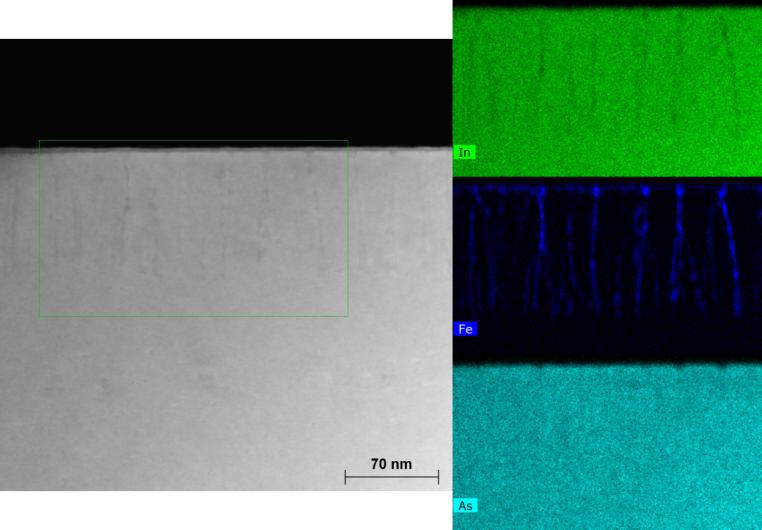 Transition-metal rich semiconductor nanostructures driven by spinodal decomposition are drawing considerable attentions due to wide prospects of functionalization. However, the complexity of the magnetic cations aggregation (e.g. a competition between p-d hybridization driven attractive force between magnetic cations, or a competition between attractive force, entropy terms, and kinetic barriers) acts as the main obstacle precluding growth of nano-clusters with desirable structure.
Transition-metal rich semiconductor nanostructures driven by spinodal decomposition are drawing considerable attentions due to wide prospects of functionalization. However, the complexity of the magnetic cations aggregation (e.g. a competition between p-d hybridization driven attractive force between magnetic cations, or a competition between attractive force, entropy terms, and kinetic barriers) acts as the main obstacle precluding growth of nano-clusters with desirable structure.
During his stay at IFPAN Dr Zhou presented the latest results obtained for Fe-implanted InAs. The most intriguing finding are 1-dimentional structures of Fe-rich InAs immersed in an extremely diluted (In,Fe)As host matrix (see the figure).
Together with Prof. M. Sawicki methods of magnetic characterization of these structures were elaborated. The measurements will be performed both in Dresden and Warsaw.
- • Prof. Dr. hab. Lech Tomasz Baczewski - Task 2.7 - Visit from Institute of Nuclear and Radiological Science, Energy, Technology and Safety of NCSR Demokritos, Athens, Greece
In the framework of the task 2.7 of the work package "Enhancing of human potential through exchange of know-how and twinning activities with partnering organization", Ms. Efthymia Ofelia Tsompopoulou from Institute of Nuclear and Radiological Science, Energy, Technology and Safety of NCSR Demokritos, Athens, Greece, visited the Institute in the period of February 1st – March 20th, 2016.
The Fusion Technology Group of the Institute of Nuclear and Radiological Science, Energy, Technology and Safety of NCSR Demokritos in Athens, Greece, of which Ms. Efthymia Ofelia Tsompopoulou is a member, has large experience in ion and neutron irradiation effects on materials relevant to fusion energy applications. They are also specialists of neutron diffraction and reflectivity. The visit of Ms Tsompopoulou has given the opportunity to discuss various aspects of irradiation effects on magnetic materials and how one can tune magnetic properties using ion irradiation and implantation effects.
She is working on Fe ions irradiation effects on magnetic properties of Fe thin films deposited on Si substrates. During her stay structural and magnetic characterisation of the thin films samples grown by MBE method previously and irradiated by high energy Fe ions at Saclay were performed. Samples were irradiated with different ion doses and radiation defects are to be determined. Different techniques available in IPPAS were used such as: PPMS, MOKE, SEM, Xray diffraction, TEM.
She has given a detailed overview of the method using beam line in a reactor using ion beam of different energies and simulation methods of the penetration depths depending on film thickness and beam energy. Using complementary specialisations of the two labs i.e. ion irradiation and neutron methods from the Greek side and nanotechnology from Polish side the series of thin films samples were grown by MBE method, the best conditions for epitaxial growth of Fe layer on Pt buffer were determined. Thin films with very small surface roughness were grown (measured by AFM and X-ray diffraction). Magnetic properties were measured by PPMS with different directions of the applied field. Samples will be irradiated in Saclay, France in Sept 2015.
Ms Tsompopoulou has also worked in the nanotechnology lab and different aspects of metallic thin films and nanostructures growth by MBE method were studied together with in-situ characterisation techniques available in the system.
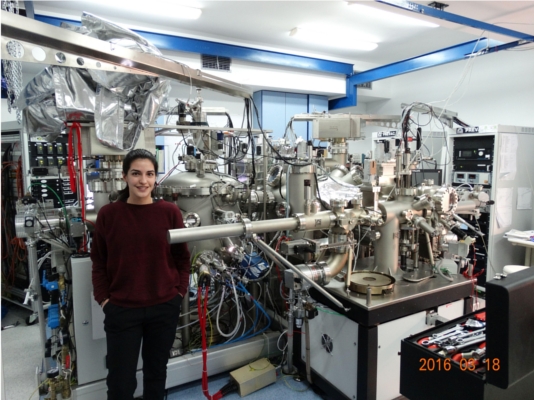
Efi Tsompopoulou in front of our MBE system in the lab.
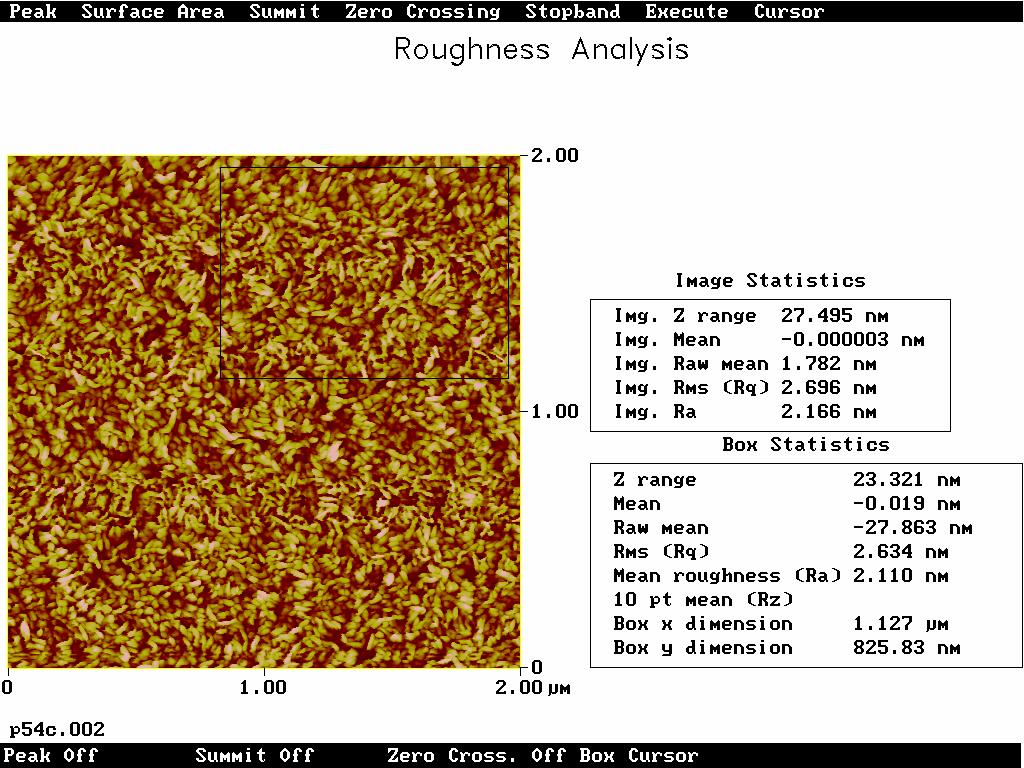
Atomic force Microscope (AFM) scan of 2x2 microns2 showing the surface of one of the produced sample Al2O3/Fe/Cr.
Granular structure of the Cr thin film of 4 nm thickness deposited on Fe can be seen with the mean surface roughness of about 2 nm.
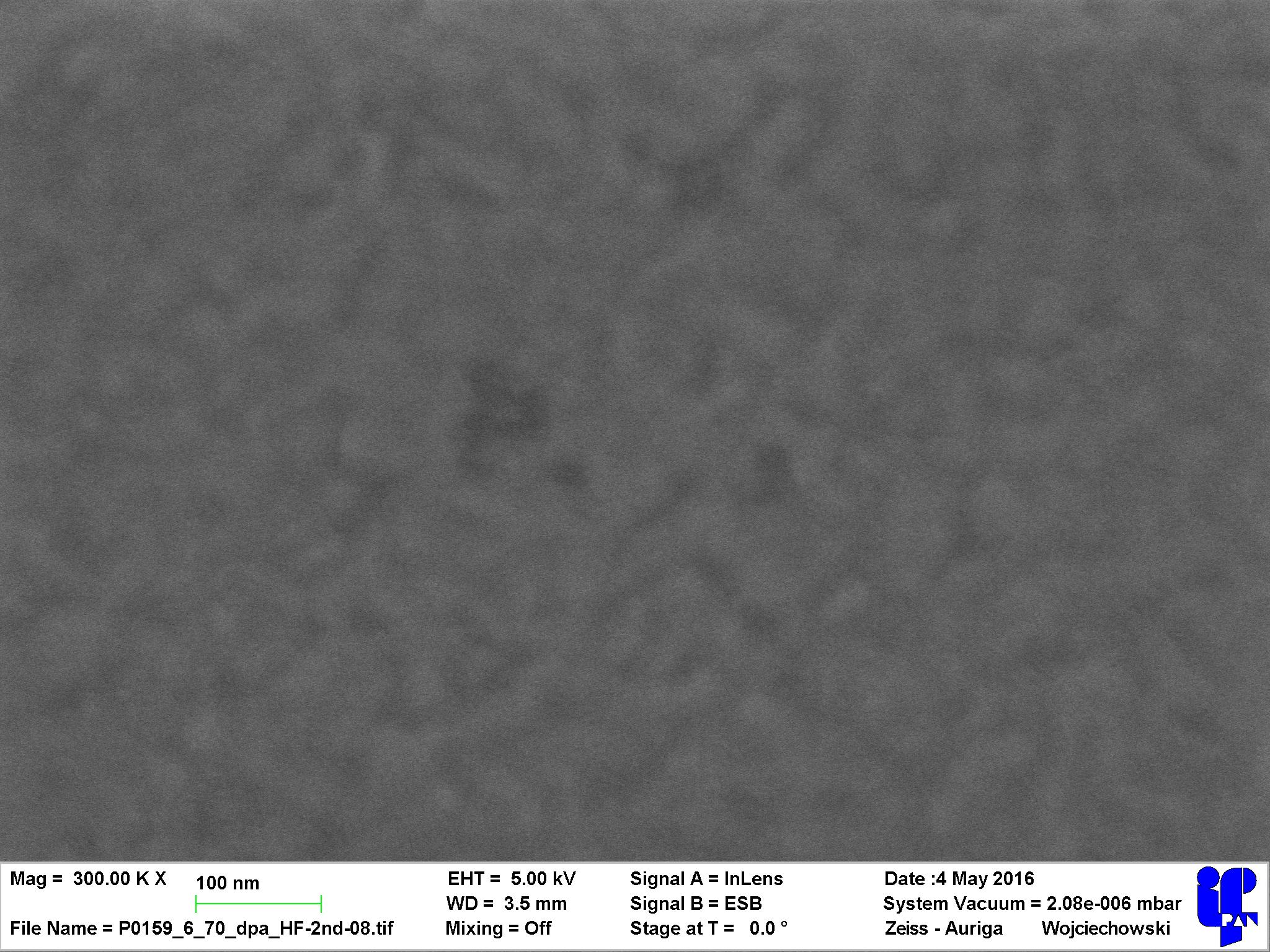
Scanning Electron Microscope SEM picture of the Fe/Cr thin film after irradiation with Fe ions – magnification 300 kx. Length scale of 100 nm is given on the picture.
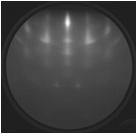
RHEED pattern after deposition of 10 nm of Fe thin film on Al2O3(0001) substrate after annealing at 450 C for 30 minutes.
- • Prof. Dr. hab. Wojciech Paszkowicz - Task 2.2 - Visit from The European Synchrotron (ESRF), Grenoble, France
In the framework of the task 2.2 of the work package "Enhancing of human potential through exchange of know-how and twinning activities with partnering organization", Dr. Damian Paliwoda from European Synchrotron (ESRF), Grenoble, France, visited the Institute in the period of January 15th – 27th, 2016.
During the visit, Dr. Paliwoda gave two lectures. The first lecture was entitled “ID15B – New High Pressure Beamline for Single Crystal and Powder Diffraction”. During the lecture, the construction of the new ID15B was described. It is a beamline dedicated to diffraction experiments using diamond anvil cells. ID15B will use monochromatic diffraction with large area detectors on single crystals and powdered samples at pressures of up to about 200 GPa, at fixed energies at 30 and 50 keV. It will use very high photon fluxes. The second lecture entitled “High Pressure Physics and Chemistry at the European Synchrotron Radiation Facility” demonstrated the opportunities of high pressure diffraction studies at the ID15B beamline in comparison to other ESRF beamlines where high-pressure diffraction is applied for studies of condensed matter. The lecture included illustrative examples of studies performed mostly by the beamline staff for selected elements, molecular crystals, and iron vanadate.
Dr. Paliwoda discussed with the members of the Applied Crystallography Group the preliminary results obtained for a vanadate single crystal. In particular the accuracy of the obtained data and the range of the pressure transitions were considered. The obtained results are treated as an introduction to a more dedicated study planned for the ID15B beamline. During his stay at the Institute Dr. Paliwoda has also visited the High Pressure Spectroscopy Group, where the opportunities of studies of both laboratories were discussed.
- • Prof. Dr. hab. Wojciech Paszkowicz - Task 2.2 - Visit from The European Synchrotron (ESRF), Grenoble, France
In the framework of the task 2.2 of the work package "Enhancing of human potential through exchange of know-how and twinning activities with partnering organization", Dr. Maciej Jankowski from European Synchrotron (ESRF), Grenoble, France, visited the Institute in the period of January 11th – 14th, 2016.
During the visit, on 12th Jan. 2015, Dr. Jankowski gave a lecture entitled “X-ray diffraction as a tool for surfaces characterization”.The construction of the ID03 beamline was presented as a tool for fast characterization of surfaces, interfaces and ultrathin films in different environments.
The ESRF ID03 beamline is equipped with modern 2D detectors. The X-ray diffraction was compared to other diffraction surface sensitive methods, like electron or helium atom diffraction. The advantage of synchrotron X-ray surface diffraction is the capability to penetrate relatively deeply into the solid samples allowing for investigation of various materials, including insulators, at conditions ranging from UHV to high pressure or in a liquid environment. In particular, the lecture demonstrated the opportunities of studies in high pressure or in a liquid environment. Oxidation processes may be investigated, as well.
Dr. Jankowski visited the laboratories of the Applied Crystallography Group, where the thin films are studied using a high resolution laboratory diffraction methods. He has discussed with the members of the Group the preliminary results obtained for transition-metal doped zinc oxide films and the opportunity of using the surface diffraction in future investigation of these samples.
- • Dr. Ryszard Sobierajski - Task 2.1 - Visit from Elettra Synchrotron
In the framework of the task 2.1 of the work package "Enhancing of human potential through exchange of know-how and twinning activities with partnering organization", Dr. Fabio Brigidi from Elettra, Sincrotrone Trieste S.C.p.A, visited the Institute in the period of November 30th – December 4th, 2015.
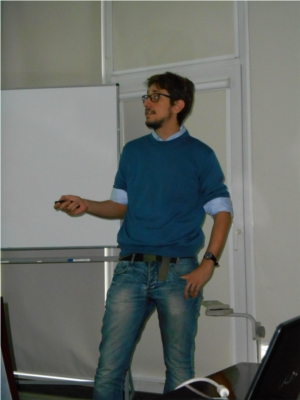
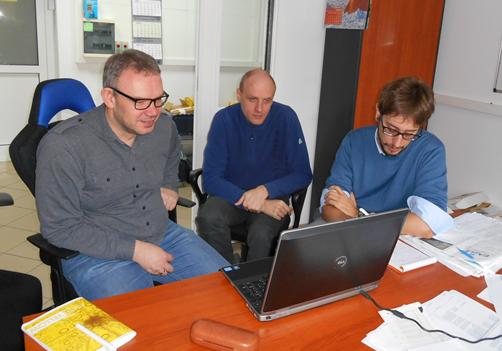 During his stay Dr Brigidi presented on a laboratory seminar a talk: “Modelling of Grazing Incidence X-ray Fluorescence (GIXRF) Analyses“. He discussed the basics of the GIXRF technique and its typical applications. GIXRF returns information about the depth distribution of the elements in an unknown sample, by exploiting the modulations of the electric field amplitude propagating inside the sample that occurs with the variation of the angle of incidence of the incoming X-ray beam.Furthermore he presented the GIXRF data analysis techniques. The modelling strategies implemented in the software GIMPy (acronym for Grazing Incidence Material analyses with Python) designed for the simulation of GIXRF profiles, were described. The potential of the technique was demonstrated via application examples dealing with the analyses of doping profiles and thin layered samples.
During his stay Dr Brigidi presented on a laboratory seminar a talk: “Modelling of Grazing Incidence X-ray Fluorescence (GIXRF) Analyses“. He discussed the basics of the GIXRF technique and its typical applications. GIXRF returns information about the depth distribution of the elements in an unknown sample, by exploiting the modulations of the electric field amplitude propagating inside the sample that occurs with the variation of the angle of incidence of the incoming X-ray beam.Furthermore he presented the GIXRF data analysis techniques. The modelling strategies implemented in the software GIMPy (acronym for Grazing Incidence Material analyses with Python) designed for the simulation of GIXRF profiles, were described. The potential of the technique was demonstrated via application examples dealing with the analyses of doping profiles and thin layered samples.
The visit was also an opportunity for evaluation of the results of previous common experiments. In particular IP PAS researchers get familiar with the GIXRF data analysis software package. Furthermore future collaboration and in particular experiments at the XRF beamline in Elettra were discussed.
- • Dr. Ryszard Sobierajski - Task 2.14 - Visit from European XFEL GmbH
In the framework of the task 2.14 of the work package "Enhancing of human potential through exchange of know-how and twinning activities with partnering organization", Dr. Wojciech Gawełda from European XFEL GmbH, visited the Institute in the period of October 28th – 30th, 2015.
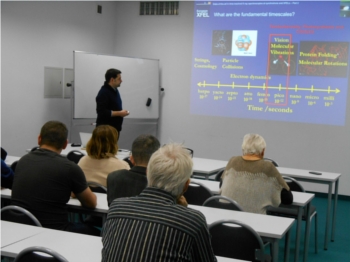 During his stay Dr. Gawełda presented on a laboratory seminar two talks under common title: “State-of-the-art in time-resolved X-ray spectroscopies at synchrotrons and XFELs“. He discussed how time-resolved XAS/XES techniques can be efficiently used at hard X-ray Free Electron Lasers (XFELs). Furthermore he has shown examples of studies on solvated transition metal complexes to illustrate how the femtosecond XAS/XES measurements deliver a complete dynamical description of the interplay between nuclear, electronic and spin degrees of freedom occurring during a chemical reaction. An outlook towards the commissioning and scientific case for the scientific instrument Femtosecond X-ray Experiments (FXE) at the European XFEL was presented as well. The visit was also an opportunity for evaluation of the results of previous common experiments performed during the visit of Dr. hab. Anna Wolska and Dr. Marcin Klepka at Eu-XFEL in August 2015. Furthermore future collaboration on time-resolved X-ray spectroscopy with XFELs was discussed.
During his stay Dr. Gawełda presented on a laboratory seminar two talks under common title: “State-of-the-art in time-resolved X-ray spectroscopies at synchrotrons and XFELs“. He discussed how time-resolved XAS/XES techniques can be efficiently used at hard X-ray Free Electron Lasers (XFELs). Furthermore he has shown examples of studies on solvated transition metal complexes to illustrate how the femtosecond XAS/XES measurements deliver a complete dynamical description of the interplay between nuclear, electronic and spin degrees of freedom occurring during a chemical reaction. An outlook towards the commissioning and scientific case for the scientific instrument Femtosecond X-ray Experiments (FXE) at the European XFEL was presented as well. The visit was also an opportunity for evaluation of the results of previous common experiments performed during the visit of Dr. hab. Anna Wolska and Dr. Marcin Klepka at Eu-XFEL in August 2015. Furthermore future collaboration on time-resolved X-ray spectroscopy with XFELs was discussed.
- • Prof. Dr. hab. Jacek Kossut - Task 2.13 - Visit from Dortmund Technical University, Dortmund, Germany
In the framework of the task 2.13 of the work package "Enhancing of human potential through exchange of know-how and twinning activities with partnering organization", Prof. Manfred Bayer from Dortmund Technical University, Dortmund, Germany, visited the Institute in the period of October 26th – 28th, 2015.
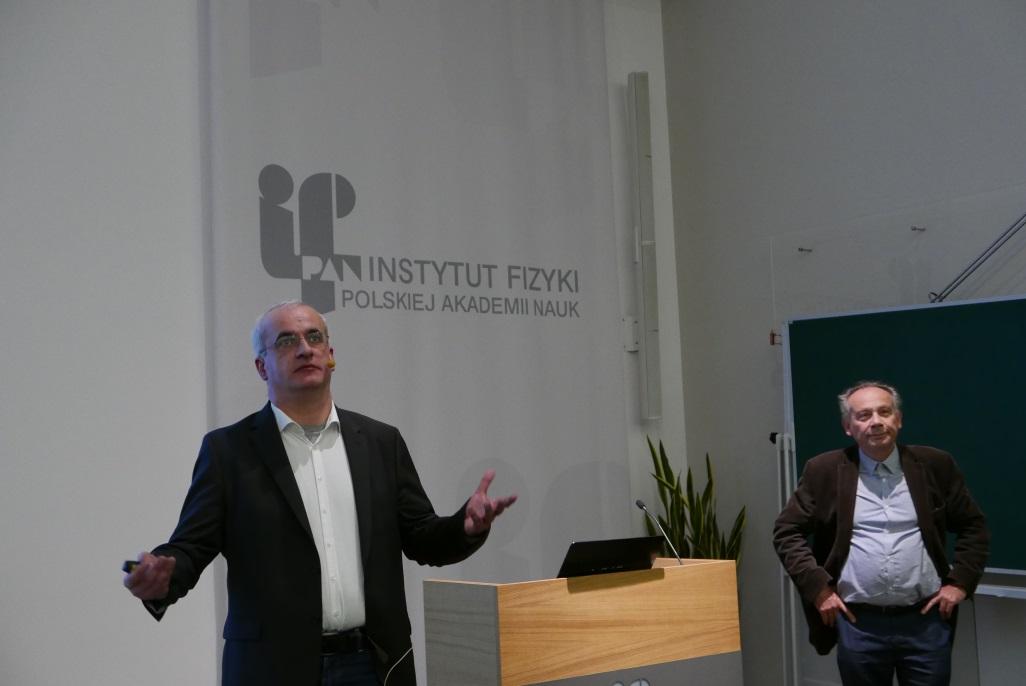 During of his visit Prof. Manfred Bayer has delivered lecture, entitled “Rydberg excitons in cuprous oxide”. In Rydberg atoms an electron has been promoted into a state with high principal quantum number, thereby representing an hydrogen atom-like object with dimensions in the micrometer-range. Such Rydberg atoms allow, for example, studies of the transition from quantum to classical dynamics. The description of excitons in semiconductors as hydrogen atom-like complexes has turned out to be extremely useful for describing their optical properties. Recently it has been shown that also an exciton can be highly excited by observing states with principal quantum number up to n=25 in high-quality natural cuprous oxide crystals. This corresponds to an average radius of 1.04 µm so that the exciton wave function is extended over more than 10 billion crystal unit cells. Subsequently, established effects from atomic physics could be demonstrated such as the Rydberg blockade where the presence of one such exciton prevents excitation of another exciton in its close vicinity.
During of his visit Prof. Manfred Bayer has delivered lecture, entitled “Rydberg excitons in cuprous oxide”. In Rydberg atoms an electron has been promoted into a state with high principal quantum number, thereby representing an hydrogen atom-like object with dimensions in the micrometer-range. Such Rydberg atoms allow, for example, studies of the transition from quantum to classical dynamics. The description of excitons in semiconductors as hydrogen atom-like complexes has turned out to be extremely useful for describing their optical properties. Recently it has been shown that also an exciton can be highly excited by observing states with principal quantum number up to n=25 in high-quality natural cuprous oxide crystals. This corresponds to an average radius of 1.04 µm so that the exciton wave function is extended over more than 10 billion crystal unit cells. Subsequently, established effects from atomic physics could be demonstrated such as the Rydberg blockade where the presence of one such exciton prevents excitation of another exciton in its close vicinity.
Development of cooperation between IFPAN and DTU in a field of semiconductors spintronic (especially in study of novel hybrid ferromagnetic-semiconductors nanostructures based on II-VI DMS) has been discussed with Prof. J. Kossut and Prof. T. Wojtowicz.
- • Dr. Maciej Zgirski - Task 2.9 - Visit from Aalto University, Espoo, Finland
In the framework of the task 2.9 of the work package "Enhancing of human potential through exchange of know-how and twinning activities with partnering organization", Dr. Alexander Savin from Aalto University, Espoo, Finland, visited the Institute in the period of October 25th – November 7th, 2015.
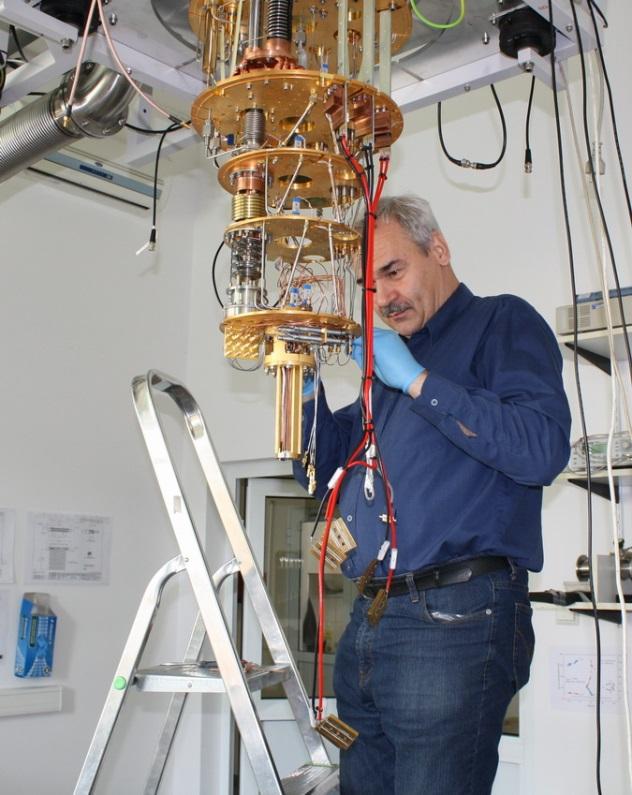 Dr. Alexander Savin is recognized expert in the field of low temperature measurements. His visit allowed to acquire many useful information concerning the most ergonomic employment of the new low temperature apparatus, purchased with the EAgLE’s project. He suggested changes in the pumping system of the vacuum chamber and load lock. He helped with the design of a dedicated, low He4 boiling rate, cryostat compatible with Heliox 270mK refrigerator. His visit was also a very good occasion for learning tips and tricks for conducting professional low temperature measurements. In particular, electromagnetic filters and efficient thermalization schemes were discussed.
Dr. Alexander Savin is recognized expert in the field of low temperature measurements. His visit allowed to acquire many useful information concerning the most ergonomic employment of the new low temperature apparatus, purchased with the EAgLE’s project. He suggested changes in the pumping system of the vacuum chamber and load lock. He helped with the design of a dedicated, low He4 boiling rate, cryostat compatible with Heliox 270mK refrigerator. His visit was also a very good occasion for learning tips and tricks for conducting professional low temperature measurements. In particular, electromagnetic filters and efficient thermalization schemes were discussed.
Alexander Savin brought with him RuOx thermometer calibrated down to 10mK. It got assembled in the sample puck and was used to measure the base sample puck temperature. It was the first electrical measurement of the temperature in the sample puck. Obtained temperature of 16.5 mK is very important figure of merit of our dilution refrigerator.
Dr Savin assembled new components in the existing Triton dilution refrigerator: cryogenic microwave amplifier and microwave circulators, which are indispensable for sensitive Ferromagnetic Resonance investigations. He also suggested future improvements in the wiring of the system: split-out boxes for cryogenic looms, a way to thermalize Thermocoaxes.
A part of the Aleksander Savin visit was devoted to development of a measuring apparatus both for the Triton and Heliox refrigerators: he recommended specific models of amplifiers and data acquisition devices. Substantial part of the visit was devoted to the design of a new sample holder that will provide good low-noise characteristics and versatility to carry out electrical transport investigations in a wide range of studied materials and structures.
- • Dr. Marcin Klepka - Task 2.1 - Visit from Elettra synchrotron
In the framework of the task 2.1 of the work package "Enhancing of human potential through exchange of know-how and twinning activities with partnering organization", Dr. Bridinette Thiodjio Sendja from Elettra, Sincrotrone Trieste S.C.p.A visited the Institute on October 19th - 23rd, 2015.
There is ongoing collaboration between part of the Group of X-ray spectroscopy and microanalysis at IP PAS and XAFS group at Elettra. Head of the group is Dr. G. Aquilanti. Member of her team Dr. B. Thiodjio Sendja is interested in collaboration in the field of X-ray photoelectron spectroscopy.
During stay Dr. B. Thiodjio Sendja was participating in the workshop entitled: "Modern techniques in photoelectron spectroscopy – experiments and data analysis". Workshop was devoted to the XPS experiments and data analysis. Moreover, hands-on QUASES and SESSA tutorials, programs used for the X-ray photoelectron spectroscopy (XPS) analysis took place. The topics and examples showed during the workshop helped in further discussion. Dr. B. Thiodjio Sendja discussed with Dr. Laurent Nittler about possibility of the measurements and data analysis of the dust particles deposited on a filter. The biggest challenge might be sample preparation.
- • Prof. Dr. hab. Maciej Sawicki - Task 2.16 - Visit from HZDR Helmholtz Centrum Dresden Rossendorf Institute of Ion Beam Physics and Material Research
In the framework of the task 2.16 of the work package "Enhancing of human potential through exchange of know-how and twinning activities with partnering organization", Dr. Shengqiang Zhou from HZDR Helmholtz Centrum Dresden Rossendorf Institute of Ion Beam Physics and Material Research visited the Institute between September 14th - 23th, 2015.
During the past decade, ion implantation has become an alternative nonequilibrium method to introduce Mn atoms into III-V compounds to obtain dilute ferromagnetic semiconductors (DFS). Although thermal annealing has been an effective and a general way for crystallizing the implanted (amorphous) layer and for activating the implanted dopant atoms, the easy generation of Mn-V second phases prohibits most traditional methods to fabricate III-Mn-V DFS such as furnace annealing and rapid thermal annealing. It turned out that a much faster annealing, especially within nanoseconds, is mandatory to achieve high-quality DFS and a new method, the pulsed laser annealing (PLA), with a duration of several tens of nanoseconds only, is exactly qualified for this demand. This proved crucial for preparation of such compound as (Ga,Mn)P, which is hard to obtain by low-temperature molecule beam epitaxy.
During his visit numerous discussions with Prof. T. Dietl, Prof. M. Sawicki and the other members of the Group of Magnetism of Spintronic Materials were carried out about the prospects of pulsed laser annealing in general and particularly in the case of (Ga,Mn)P. In addition, SQUID magnetic measurements under the supervision of Dr. Zhou were conducted - focused on establishing the magnetic anisotropy of (Ga,Mn)P layers obtained by Mn ion implantation into GaP matrix and re-crystallized using PLA at different laser power setting. The measurements were done according to the experimental protocol elaborated during the previous visit of Dr. Zhou in IFPAN.
Having the magnetic measurements completed the results were compared with results of systematic structure characterization (high-resolution X-ray diffraction, transmission electron microscopy, Rutherford backscattering spectrometry, ultraviolet Raman spectroscopy, and extended X-ray absorption fine structure). A clear pictured has emerged that the vanishing of the uniaxial magnetic anisotropy and ferromagnetic moment in Mn-implanted GaP observed in samples subjected to PLA at higher energy fluencies is due to a defective epitaxial recrystallization. These findings were the core for the new publication which preparation has been initiated during the visit of Dr. Zhou.

A comparison of transition electron microscopy images and the magnetic anisotropy [insets: low temperature m(H) – measured in SQUID magnetometer] clearly pointing to a decrease of uniaxial magnetic anisotropy in a sample possessing a disoriented crystallographic composure (right).
Dr. Zhou also shared his experience on ion implantation method with a larger EAgLE community, participating in the Symposium W (Nanoscale phase separations in spintronic materials, superconductors, and other) of 2015 Fall Meeting of the European Materials Research Society (E-MRS) presenting a talk entitled: “Application of ion beams to fabricate and tune ferromagnetic semiconductors“. Both the conference and this Symposium were widely attended by IFPAN scientist and the EAgLE project community.
- • Prof. Dr. hab. Tomasz Dietl - Task 2.8 - Visit from JK University, Linz, Austria
In the framework of the task 2.8 of the work package "Enhancing of human potential through exchange of know-how and twinning activities with partnering organization", Prof. Alberta Bonanni from JK University, Linz, Austria visited the Institute on September 14th - 18th, 2015.
During the visit Prof. Bonanni met with the members of the Laboratory of Cryogenic and Spintronic Research to present the most recent progress in controlling of the aggregation mechanisms of transition metals during their incorporation into group III nitrides, like GaN. A rich spectrum of possibilities were discussed concerning the numerous crystallographic phases as well as magnetic properties. Am important point was a discussion about the prospects of their functionalization – in spin-filters in particular. It was agreed that the material obtained at the Linz University will be magnetically investigated using SQUID magnetometers in the group headed by Prof. M. Sawicki: Group of magnetism of spintronic materials. Finally, methods increasing chances of obtaining antiferromagnetic nanocrystals in semiconducting nitrides matrix were discussed.
Apart from the meetings at IFPAN Prof. Bonanni shared her broad knowledge with much wider audience giving an invited talk “Phase separation in modulated III-nitrides doped with transition metals” during symposium Nanoscale phase separations in spintronic materials, superconductors, and other systems which was a part of annual Fall Meeting of the European Materials Research Society (E-MRS) in Warsawa. This symposium was co-organised by EAgLE Project and widely attended of both IFPAN scientists and the EAgLE project participants.
- • Prof. Dr. hab. Maciej Sawicki - Task 2.16 - Visit from HZDR Helmholtz Centrum Dresden Rossendorf Institute of Ion Beam Physics and Material Research
In the framework of the task 2.16 of the work package "Enhancing of human potential through exchange of know-how and twinning activities with partnering organization", Prof. Manfred Helm from HZDR Helmholtz Centrum Dresden Rossendorf Institute of Ion Beam Physics and Material Research visited the Institute between September 14th - 18th, 2015.
Despite many conflicting and over-optimistic reports on high and very high Curie temperature in some semiconductors doped with transition metals, it is now widely agreed that extensive doping of semiconductors leads very frequently to a mixed crystals consisting of two or even more main phases which can determine either the electronic, magnetic or optical properties of the final solid solution. Such a situation has been frequently met in spintronic compounds, particularly in III-V family in which solubility limits of most of the transition metals are low. It has to be underlined, that the phase separation does not have to play a detrimental role for the material. Some very interesting possibilities of employment of the “alien” inclusions in the host matrix have been considered.
The visit of prof. Helm was mainly devoted to lay a road map for IFPAN – HZDR collaboration in either functionalization of phase separation in spintronics or in developing methods for both enhancing and eliminating of this process. During some meetings held with prof. T. Dietl and M. Sawicki from the Group of Magnetism of Spintronic Materials the state of the art in synthesis of phase separated materials, understanding of mechanism of phase separation, and perspectives of functionalization, in particular in spintronics were discussed.
Prof. Helm also shared his knowledge with a larger EAgLE community, co-chairing Symposium W (Nanoscale phase separations in spintronic materials, superconductors, and other systems) 2015 Fall Meeting of the European Materials Research Society (E-MRS). Both the conference and this Symposium were widely attended by IFPAN scientist and the EAgLE project community.
- • Prof. Dr. hab. Maciej Sawicki - Task 2.10 - Visit from CEA – Saclay, Gif-sur-Yvette, France
In the framework of the task 2.10 of the work package "Enhancing of human potential through exchange of know-how and twinning activities with partnering organization", Dr. Michael Viret from CEA – Saclay, Gif-sur-Yvette, France visited the Institute between September 14th - 17th, 2015.
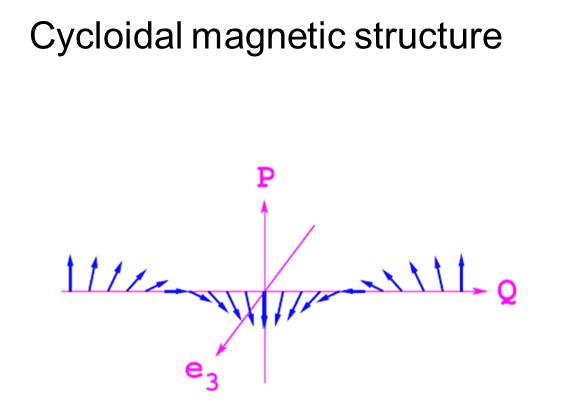 Multiferroic materials are the focus of an intense research effort due to the significant technological interest of multifunctional materials as well as the rich fundamental physics lying in the coupling of various order parameters. Among all multiferroics, BiFeO3 is a material of choice because it is the only (antiferro)magnetic ferroelectric material, that is its two ordering temperatures (ferroelectric and antiferromagnetic) are well above the room temperature. In addition, a fairly large magnetoelectric coupling has been demonstrated in single crystals as well as in thin films.
Multiferroic materials are the focus of an intense research effort due to the significant technological interest of multifunctional materials as well as the rich fundamental physics lying in the coupling of various order parameters. Among all multiferroics, BiFeO3 is a material of choice because it is the only (antiferro)magnetic ferroelectric material, that is its two ordering temperatures (ferroelectric and antiferromagnetic) are well above the room temperature. In addition, a fairly large magnetoelectric coupling has been demonstrated in single crystals as well as in thin films.
During his visit Dr. Viret discussed the issues related to the growth and characterisation of thin layers of BaFeO3, characterisation techniques and perspectivesin application in antiferromagnetic spintronics. with scientists grouped around profs. T. Dietl and M. Sawicki from the Laboratory of Cryogenic and Spintronic Research. Among many important information he showed that the magnetoelectric coupling effect in BaFeO3 was responsible for the establishment of a long period cycloidal arrangement, which could be affected by the application of a large magnetic field.
Dr. Viret also shared his knowledge with a larger EAgLE community, participating in the 2015 Fall Meeting of the European Materials Research Society (E-MRS) giving the invited talk entitled: “Magnetocapacitance of BiFeO3 at high fields and the role of inhomogeneous antiferromagnetism”.
- • Prof. Dr. hab. Maciej Sawicki - Task 2.10 - Visit from French Atomic Energy Commission (CEA) – Saclay, IRAMIS, Gif-sur-Yvette, France
In the framework of the task 2.10 of the work package "Enhancing of human potential through exchange of know-how and twinning activities with partnering organization", Dr. Antoine Barbier from French Atomic Energy Commission (CEA) – Saclay, IRAMIS, Gif-sur-Yvette, France visited the Institute between September 13th - 19th, 2015.
During his visit to IFPAN Dr. Barbier met with scientists of both the Laboratory of Cryogenic and Spintronic Research and Division of Physics of Magnetism. The numerous and vivid discussion were centred on the issues related to the details of the growth methods, structural characterization and the electronic structure of thin multiferroic BaTiO3 films containing Fe i NiFe2 obtained by by atomic oxygen plasma assisted molecular beam epitaxy. In these compounds Dr. Barbier and his colleagues from CEA/Saclay realized the antiferromagnetic long-range spin ordering. In particular the issues and the practical path to obtain the base material, the BaTiO3, and it co-doping with Fe or NiFe2 were presented. The other topics contained spin filters structures based on Fe3O4 tunnel junctions, scanning x-ray micro-diffraction, doping with magnetic ions as well as interfaces with ferrite magnetic oxides like CoFe2O4. An extended overview on the subject was given to the broad IFPAN community in the form of seminar entitled: “Epitaxial spintronics dedicated oxide thin films studied by synchrotron radiation techniques".
Dr. Barbier also shared his knowledge with a larger EAgLE community, participating in the Symposium X (Semiconductor spintronics) of 2015 Fall Meeting of the European Materials Research Society (E-MRS) presenting a talk entitled: “Antiferromagnetic long-range spin ordering in Fe- and NiFe2-doped BaTiO3 multiferroic layers“.
- • Prof. Dr. hab. Maciej Sawicki - Task 2.16 - Visit from HZDR Helmholtz Centrum Dresden Rossendorf Institute of Ion Beam Physics and Material Research
In the framework of the task 2.16 of the work package "Enhancing of human potential through exchange of know-how and twinning activities with partnering organization", Dr. Slawomir Prucnal from HZDR Helmholtz Centrum Dresden Rossendorf Institute of Ion Beam Physics and Material Research visited the Institute between September 13th - 18th, 2015.
ZnO and TiO2 are wide band gap semiconductors (the energy gap is of the order of 3.3 eV) widely investigated in the field of the optoelectronics for ultraviolet lasers, heterojunction solar cells, thin film transistors and light emitting diodes. A highly doped n-type ZnO thin layer is an attractive candidate to replace the much more expensive indium-tin-oxide layer in the microelectronic industry. The optoelectronic properties of transparent conductive oxides are determined by the type of doping and carrier concentration. The n-type conductivity of ZnO is easily achieved by substitution of Zn by group III elements (Al, Ga, In), or by doping with halogen elements (F, Cl or I) substituting into the oxygen lattice site. In the case of TiO2 the n-type material can be achieved by doping with Nb, Ta or F ions while p-type TiO2 can be realized by e.g. Cr doping.  It turns out that the utilization of highly non-equilibrium thermal processing of heterojunctions consisting of either of these two materials and Si using millisecond range flash lamp annealing (FLA, see the figure) techniques proves highly successful for the formation of highly p- and n-type semiconductor films on silicon substrate. The n- and p-type doping in ZnO is made by Al and F or N and P doping into ZnO, respectively. While conductivity of TiO2 films can be easily controlled by incorporation of Ta and Cr into the lattice site of Ti.
It turns out that the utilization of highly non-equilibrium thermal processing of heterojunctions consisting of either of these two materials and Si using millisecond range flash lamp annealing (FLA, see the figure) techniques proves highly successful for the formation of highly p- and n-type semiconductor films on silicon substrate. The n- and p-type doping in ZnO is made by Al and F or N and P doping into ZnO, respectively. While conductivity of TiO2 films can be easily controlled by incorporation of Ta and Cr into the lattice site of Ti.
During his visit Dr. Prucnal had a series of meetings with Prof. M. Sawicki and other members of the Group of Magnetism of Spintronic Materials during which he introduced the method and its prospects as well as limitations in respect to transparent oxides and other semiconductors investigated in the field of spintronics, such as (Ga,Mn)As and (Ga,Mn)N. It is of a particular relevance as the method of millisecond flash lamp annealing can also be used for modifications of the crystallographic orientation and to preclude other phase formation. He gave a broad overview of the optical properties investigations, including temperature dependent photoluminescence, Raman and transmission spectroscopy, the XRD, and cross-section TEM studies of the microstructural properties.
Dr. Prucnal also shared his knowledge on this subject with a larger EAgLE community, participating in the Symposium G (Transparent conductive materials: from fundamental understanding to applications) of 2015 Fall Meeting of the European Materials Research Society (E-MRS) presenting a talk entitled: “Non-equilibrium thermal processing towards p-n junction formation in TCOs“. Both the conference and this Symposium were widely attended by IFPAN scientist and the EAgLE project community.
- • Dr. hab. Marek Wójcik - Task 2.12 - Visit from Institute of Materials Science of Barcelona (ICMAB), Spain
In the framework of the task 2.12 of the work package "Enhancing of human potential through exchange of know-how and twinning activities with partnering organization", Prof. Josep Fontcuberta and Dr. Anna Roig Serra from Institute of Materials Science of Barcelona (ICMAB), Spain visited the Institute between September 13th - 17th, 2015.
During their visit at IFPAN professor Fontcuberta and dr. Anna Roig from ICMAB Barcelona, participated in the meetings with the members of NMR group and discussed the progress and achievement of application of NMR technique to study the problem of interfacial properties of magnetic oxide thin films depending on a substrate and a capping material properties. It is is known that symmetry breaking produced by strain in thin films affects the population of d states in the valence or conduction band in transition metal. However, larger disruption of the symmetry is present at the surface that can profoundly alter the orbital hierarchy promoting electron localization in certain orbitals.
Optimally doped manganite La2/3Sr1/3MnO3 (LSMO) is prospective for use in spintronic devices, which involve contact of a manganite layer with other materials (mainly other perovskite oxides - ABO3), leading to deterioration of magnetic and conducting properties of manganite film. 55Mn NMR has been used by IFPAN group as a probe of charge distribution and of Mn spin state in LSMO ultra-thin films to study the effect of strain and bonding at the interface between manganite and ABO3 capping layer. A series of LSMO thin films were grown by PLD deposition on the (001) STO-TiO2 terminated substrates in ICMAB. Three of these films were respectively capped with SrTiO3 (STO), SrZrO3 (SZO) or LaAlO3 (LAO), while the fourth remained uncapped and served as a reference. Based on the characteristic features of 55Mn NMR spectra, the contributions from the two interfaces (with substrate and with capping) have been disentangled. The NMR line around 375 MHz corresponds to the mixed valence state of Mn ions within the main ferromagnetic and metallic phase (FMM) governed by double exchange (DE) interaction. Intensity of this line varies with the capping material and reveals a dramatic role of an open surface in breaking degeneracy of Mn eg(3d) orbitals, diminishing the strength of DE and converting a few upper atomic layers of the manganite film into antiferromagnetic (AF) phase. Depending on the capping material, parameters such as lattice mismatch to manganite, symmetry (s, d) and space expansion (3d, 4d) of the wave function of the B atom (Al, Ti, Zr), the local symmetry of Mn atoms in the upper layers is altered. In case of capping with LAO and STO (to less extend), this brings back the degeneracy of Mn eg(3d) orbitals and recovers the DE phase, whereas in case of SZO, the asymmetry of the Mn eg(3d) orbitals is strengthened, leading to expansion of the AF phase.
- • Dr. Aleksandra Drzewiecka-Antonik - Task 2.1 - Visit from Elettra synchrotron
In the framework of the task 2.1 of the work package "Enhancing of human potential through exchange of know-how and twinning activities with partnering organization", Dr. Diane Eichert from Elettra, Sincrotrone Trieste S.C.p.A visited the Institute between September 6th - 12th, 2015.
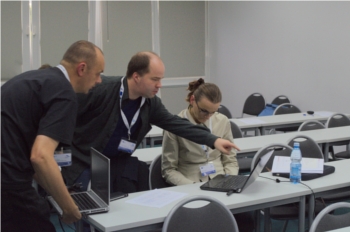 The main goal of the visit was to discuss the preliminary results of the XPS measurements performed on compounds with biological activity. The ongoing analysis revealed many questions about the preparation methods of the samples in the form of powder. Dr. Eichert suggested avoiding preparation of pellets since such preparation method can modify the structure of analyzed compounds.
The main goal of the visit was to discuss the preliminary results of the XPS measurements performed on compounds with biological activity. The ongoing analysis revealed many questions about the preparation methods of the samples in the form of powder. Dr. Eichert suggested avoiding preparation of pellets since such preparation method can modify the structure of analyzed compounds.
Dr. D. Eichert is also interested in the molecular modeling of bioactive compounds, therefore, she was invited to participate in the “kshop on Molecular Simulation and Drug Design in which quantum chemistry as well as quantitive structure-activity relationship methods were studied. The workshop took place in IF PAN on September 8th - 11th, 2015.
- • Prof. Dr. hab. Wojciech Paszkowicz - Task 2.2 - Visit from European Synchrotron Radiation Facility (ESRF)
In the framework of the task 2.2 of the work package "Enhancing of human potential through exchange of know-how and twinning activities with partnering organization", Dr. Jürgen Härtwig from European Synchrotron Radiation Facility (ESRF), France, visited the Institute of Physics PAS, Warsaw, in the period of August 20th – September 2nd, 2015.
During the visit, Dr. Härtwig discussed, with Prof. Paszkowicz and Dr. Domagała, the results of investigation for nitride samples measured using two complementary methodics: (i) during the stay at IFPAN, using a high resolution diffractometer, and (ii) during an earlier visit in the ESRF, using synchrotron radiation based X-ray topography. The obtained results are a part of a planned publication concerning the X-ray characterization of GaN platelets obtained by growth of the single crystal GaN by HVPE. During his stay at the Institute Dr. Härtwig has also visited the new X-ray Photoelectron Spectroscopy laboratory, built in the frame of another task of the EAgLE grant. Dr. Härtwig presented two lectures. The first one, entitled: "The European Synchrotron Radiation Facility (ESRF, Grenoble, France) - Its Past and Future" where he shown upgrade results of the ESRF synchrotron transforming it into a fourth generation X-ray source. It was useful for the audience, as many researchers of the Institute of Physics have used or plan to use the opportunities offered by the numerous beamlines of this facility. The second lecture was entitled “Elements of X-ray optics and examples of X-ray topography of monochromator crystals”. Dr. Härtwig, a specialist in topography and X-ray optics, focused on the transfer of knowledge about imaging methods for crystals and epitaxial films of various sizes. The visit enabled (i) becoming acquainted with experimental studies at the high-resolution X-ray laboratory equipment, (ii) progressing in data analysis for earlier obtained results, (iii) planning of future collaboration in the field of diffraction imaging techniques, X-ray optics and data analysis.
- • Dr. hab. Sławomir Kret - Task 2.3 - Visit from Department of Physics, University of Warwick, United Kingdom
In the framework of task 2.3 of work package "Enhancing of human potential through exchange of know-how and twinning activities with partnering organization" Dr. Jeremy Sloan from Department of Physics, University of Warwick, United Kingdom visited the Institute on August 2nd - 15th, 2015.
During his visit Dr. Jeremy Sloan participated in optimization of investigation conditions of carbon nanotubes filled with the chain of heavy atoms like CoI2 the Titan Cubed 80-300 microscope operating at 300KV what is unusual in the practice of study of carbon related materials. The main purposes of this investigation were to check what is the structure of low dimensional crystals (how are they organized inside the nanotube) and how stable are both nanotubes and chains of atoms under the electron beam at 300KV. In his laboratory at University of Warwick he has already investigated the same nanotubes on Jeol ARM 200 kV microscope and noticed that under the 80 kV electron beam the nanotubes are stable but chains of atoms oscillate and it is not possible obtain clear image of single atom chains. He predicted that under 300 kV electron beam the situation will be opposite – crystals inside the nanotubes will be more stable than the nanotubes themselves. His predictions were true although fast degeneration of carbon atoms under 300 kV beam was hindering the investigation. During his stay we tested different strategy of obtaining exploitable images of heavy atoms chains encapsulated in light carbon nanotubes. We find out that operator of microscope had to keep the exposure on a very low level to prevent nanotubes from damaging. With such low exposure the image contrast is very low so the operator had to strongly defocus the image to start seeing some recognizable features. He shouldn't investigate one area for too long (more than 60 s) because that would also damage the nanotubes. After finding a single or double walled nanotube with a chain of atoms inside the operator had to quickly focus the image and acquire a couple of images by adjusting the intensity at the same time to obtain the best possible contrast. Then he had to move to a different (significantly distant) area which was not affected by the previous investigations. We conclude that under 300 kV and well optimized low dose conditions atoms chains are stable and can be imaged successfully before disintegration of the carbon nanotubes.
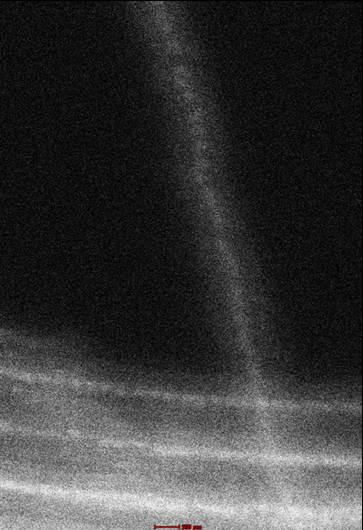 (a)
(a) 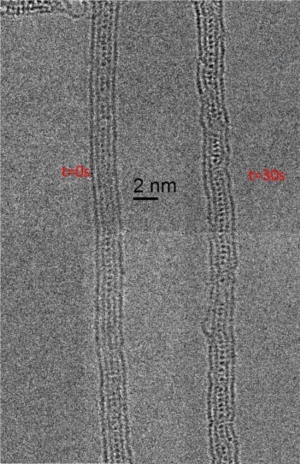 (b)
(b)
Fig. (a) STEM HAADF images of chains of I-Co atoms inside carbon nanotubes at 300 kV (white dots corresponds to one atom ),
(b) two HRTEM images illustrating the process of carbon nanotube degradation during 30 s irradiation with 300 kV electrons (please note that chains of heavy atoms are stable – black dot corresponds to one atom).
- • Prof. Dr. hab. Maciej Sawicki - Task 2.16 - Visit from HZDR Helmholtz Centrum Dresden Rossendorf Institute of Ion Beam Physics and Material Research
In the framework of the task 2.16 of the work package "Enhancing of human potential through exchange of know-how and twinning activities with partnering organization", Dr. Shengqiang Zhou from HZDR Helmholtz Centrum Dresden Rossendorf Institute of Ion Beam Physics and Material Research, visited the Institute between June 29th – July 2nd, 2015.
Ferromagnetic semiconductors have been under intensive investigation for more than two decades. Mn doped III-V compound semiconductors have been regarded as the prototype of ferromagnetic semiconductors from both experimental and theoretic investigations. The magnetic properties of III-V:Mn can be controlled by manipulating free carriers via electrical gating, as for controlling the electrical properties in conventional semiconductors. However, the preparation of ferromagnetic semiconductors presents a big challenge due to the low solubility of Mn in semiconductors. Ion implantation has been developed as a standard method for doping Si in microelectronic industry and now, this method has been applied to grow layered structures of Mn and Fe containing III-V semiconductors. Also, this method allow for fine tuning of the micromagnetic properties or for laterar structuring. During his stay at IFPAN numerous discussions about the prospects of this method and most useful directions of joint collaboration between IFPAN and HZDR were carried out with Prof. T. Dietl, Prof. M. Sawicki and the other members of the Group of Magnetism of Spintronic Materials. Apart, a lot od attention was put on practical aspects of magnetic characterization of these compounds. Experimental test under the supervision of Dr Zhou were conducted focused on finding adequate methods and experimental protocols to perform proper magnetic characterization of ion implanted materials. Some very interesting results were obtained for GaP:Mn and these results will constitute the basis of a forthcoming publication.
- • Prof. Dr. hab. Maciej Sawicki - Task 2.16 - Visit from HZDR Helmholtz Centrum Dresden Rossendorf Institute of Ion Beam Physics and Material Research
In the framework of the task 2.16 of the work package "Enhancing of human potential through exchange of know-how and twinning activities with partnering organization", Ye Yuan from HZDR Helmholtz Centrum Dresden Rossendorf Institute of Ion Beam Physics and Material Research, visited the Institute between June 18th – July 2nd, 2015.
Ferromagnetic semiconductors have been under intensive investigation for the last two decades. Until now, the prototype ferromagnetic semiconductor GaMnAs has revealed a collection of unique features exceeding by far a simple sum of its magnetic and semiconducting properties. However, there still remain paramount challenges concerning the growth of these compounds. As a non-equilibrium process, ion implantation promisses to overcome some of them, mainly the method may allow to obtain high quality materials with Mn and Fe concentrations exceeding by far limits encountered by standard growth methods of III-V compounds.
During his stay at IFPAN a numerous disscussion were caried out with Prof. M. Sawicki and the other members of the Group of Magnetism of Spintronic Materials and Dr. S. Zhou (also from HZDR). They were focused on finding an adequate methods and experimental protocols to perform proper magnetic characterization of ion implanted materials. Numerous test measurements were conducted under the supervision of dr S. Zhou, and the results proved very promissing. Most of the experimental time was devoted to GaP:Mn and the obtained results will constitute the basis of a forthcomming publication.
During his visit Mr Yuan presented also a detailed report of the recent progress achieved in HZDR in growth, structural, electrical and magnetic characterization of Mn doped III-V: InAs, GaAs, InP, and GaP during the annual meeting of Semiconductor Physics, Jaszowiec 2015. This conference was widely attended by IFPAN scientist and the EAgLE project community, to whom his presentation was mainly addressed.
- • Prof. Dr. hab. Maciej Sawicki - Task 2.6 - Visit from University of Wuerzburg, Experimentelle Physik III, Wuerzburg, Germany
In the framework of the task 2.6 of the work package "Enhancing of human potential through exchange of know-how and twinning activities with partnering organization", Martin Baussenwein from University of Wuerzburg, visited the Institute between June 18th – June 27th, 2015.
The half-Heusler alloy NiMnSb is a well established half-metallic ferromagnet with a theoretical spin polarization of 100% in bulk. At the surface the spin polarization is reduced significantly, however it is still high compared to other commonly used materials. Furthermore the material exhibits a very low Gilbert damping and a rich magnetic anisotropy.
Mr. Baussenwein in a set of meetings with IFPAN scientist showed the methods and most recent achievenets in molecular beam epitaxy growth of this compound. A possibility of a spin-transfer torque device based on the very favorable combination of the high spin polarization, low damping and engineerable anisotropies were explored during this discussions. One of the discussed possibility which was pointed out was an in-situ grown NiMnSb/ZnTe/NiMnSb heterostructure, where ZnTe serves as the tunnel barrier. Such an spin torque oscillator will be soon a subject of detailed magnetic SQUID and FMR measurements. During his stay at IFPAN preliminary SQUID magnetic measuremnts were performed together with Prof. Maciej Sawicki.
During his visit Mr Baussenwein presented also a detailed report on the investigation of the NiMnSb/ZnTe/NiMnSb heterostructures, which are ment to became the basis of the spin torque oscillator, during the annual meeting of Semiconductor Physics, Jaszowiec 2015. This conference was widely attended by IFPAN scientist and the EAgLE project community, to whom his presentation was mainly addressed.
- • Prof. Dr. hab. Maciej Sawicki - Task 2.6 - Visit from University of Wuerzburg, Experimentelle Physik III, Wuerzburg, Germany
In the framework of the task 2.6 of the work package "Enhancing of human potential through exchange of know-how and twinning activities with partnering organization", Mirko Trabel from University of Wuerzburg, visited the Institute between June 18th – June 27th, 2015.
MnSi has recently resurfaced as a potentially interesting spintronics material. The lack of inversion symmetry in its B20 crystal structure leads to a Dzyaloshinskii-Moriya (DM) interaction between spins which favora a non-collinear spin alignments which can take the form of conical, helical or skyrmionic spin textures. As the metallic state at the border of the skyrmion lattice in MnSi represents a new form of magnetic order it is of a paramount importance to elaborate suitable experimental protocols to assess properly the properties of the material.
The first part of the visit of Mr. Trabel was devoted to further detailed tests of experimental configurations of MnSi layers in SQUID magnetometers. Together with Prof. Maciej Sawicki other experimental approaches were tested in order to increase the credibility of the magnetic data obtained from the SQUID magnetometer. This time most of the effort was devoted to data reduction and subsequent numerical data analysis to avoid various artefacts. Mr. Trabel wrote and tested some software codes which proved very useful in SQUID data analysis.
During his visit Mr. Traube also presented detailed report on the recent results of structural, magnetic and electrical measurements of MnSi layers during the annual meeting of Semiconductor Physics, Jaszowiec 2015. This conference was widely attended by IFPAN scientist and the EAgLE project community, to whom his presentation was mainly addressed.
- • Prof. Dr. hab. Jacek Kossut - Task 2.13 - Visit from DUT, Dortmund, Germany
In the framework of the task 2.13 of the work package "Enhancing of human potential through exchange of know-how and twinning activities with partnering organization", Prof. Dmitri Yakovlev from DUT, Dortmund, Germany, visited the Institute between June 18th – June 26th, 2015.
Prof. Yakovlev discussed with researchers from IFPAN various aspects of experimental studies of spin dynamic in Quantum Dots using polarization resolved and time resolved spectroscopic techniques. The main attention was put on the new results obtained in SL-3 laboratory and ON4 division of IFPAN. His suggestion would largely stimulate the progress of work in this field at IFPAN.
Main part of his conference lecture was devoted to spin physics in colloidal nanocrystals. He reported on experimental and theoretical studies of the trion and exciton spin dynamics in core/thick-shell CdSe/CdS NCs, showing in particular that photo-excitation of core/shell CdSe/CdS nanocrystals (NCs), which shell thickness exceeds 4 nm, leads to a single electron charging of NCs. He showed how from the decay of the photoluminescence intensity the trion radiative time can be measured. It proved independent of the magnetic field reflecting the fact that the trion ground state is always optically bright (i.e. allowed in electric-dipole approximation). This is in strong contrast to the exciton states in NCs which dynamics is controlled by a competition of the bright and dark states, which can be mixed either by magnetic fields or thermally.
He also briefly sketched methods of theoretical description of the polarization dynamics which is complicated by the fact that normally an ensemble of CdSe/CdS nanocrystals with random orientation of their hexagonal axises to the magnetic field direction is studied. However, the newly developed model approach accounts for this complication.
- • Prof. Dr. hab. Tomasz Baczewski - Task 2.7 - Visit from Institute of Nuclear and Radiological Science Energy, Technology and Safety of NCSR Demokritos, Athens, Greece
In the framework of the task 2.7 of the work package "Enhancing of human potential through exchange of know-how and twinning activities with partnering organization", Ofelia Tsompopoulou from Institute of Nuclear and Radiological Science Energy, Technology and Safety of NCSR Demokritos, Athens, Greece, visited the Institute between June 1st – July 10th, 2015.
The Fusion Technology Group of the Institute of Nuclear and Radiological Science, Energy, Technology and Safety of NCSR Demokritos in Athens, Greece, of which Ms. Efthymia Ofelia Tsompopoulou is a member, has a large experience in ion and neutron irradiation effects on materials relevant to fusion energy applications. They are also specialists of neutron diffraction and reflectivity. The visit of Ms Tsompopoulou provided the opportunity to discuss various aspects of irradiation effects on magnetic materials and to disseminate the knowledge tuning of the magnetic properties using ion irradiation and implantation effects.
At Demokritos she is studying Fe ions irradiation effects on magnetic properties of Fe thin films deposited on Si substrates. At IFPAN she gave a comprehensive overview of the method and results of usage of a nuclear reactor made ion beams of different energies and of the simulation methods of the penetration depths depending on film thickness and beam energy. Using complementary specialisations of the two labs i.e. ion irradiation and neutron methods from the Greek side and nanotechnology from Polish side the series of thin films samples were grown by MBE method. During the exercise the best conditions for epitaxial growth of Fe layer on Pt buffer were determined. As the result thin films with very small surface roughness were grown (as determined by AFM and X-ray diffraction). Magnetic properties were measured by PPMS system with different orientations of the applied magnetic field. For the further joint studies, these samples will be irradiated in Saclay, France in Sept 2015.
Ms. Tsompopoulou was also very active in the nanotechnology lab, when she gave “hands on” tutorials on the many aspects of metallic thin films growth by MBE method and their nanostructurisation. These layers were studied together with the staff members of Magnetic Heterostructures laboratory using in-situ characterisation techniques available in the system.
- • Dr. Maciej Zgirski - Task 2.9 - Visit from Aalto University, Low Temperature Laboratory, Finland
In the framework of the task 2.9 within the work package "Enhancing of human potential through exchange of know-how and twinning activities with partnering organization" Dr. Olli-Pentti Saira from Aalto University, Low Temperature Laboratory, Finland visited the Institute on May 9th - 23th, 2015.
Olli-Pentti Saira brought 2 samples from his home laboratory. The samples were microwave circuits with 2 NIS thermometers placed on a proximized Copper nanoisland with aim to explore intrinsic temperature fluctuations of small object. We bonded samples on sample holder, prepared coaxes in the new dilution fridge and especially in the sample puck. We were able to cool down both samples and successfully measured resonances of microwave superconducting resonators. We failed to observe the response of NIS thermometers but got hints what should be improved for the next trial. We agreed to continue both during next visit of Olli-Pentti and during my short visit to Olli-Pentti lab.
During his stay, Dr. Saira delivered the talk “Thermal fluctuations in small metallic systems”, in which he presented experimental work illuminating the unique thermal phenomena occuring in nanostructures at milikelvin temperatures.
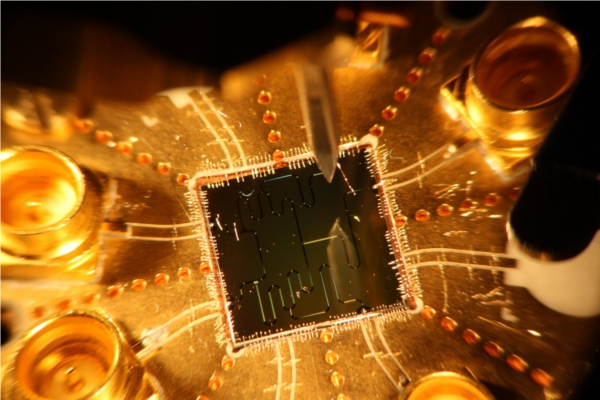
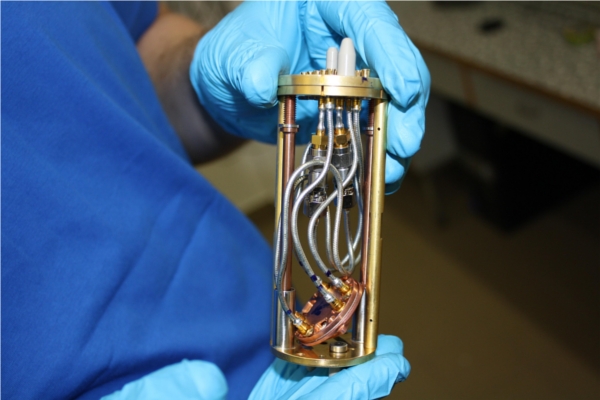
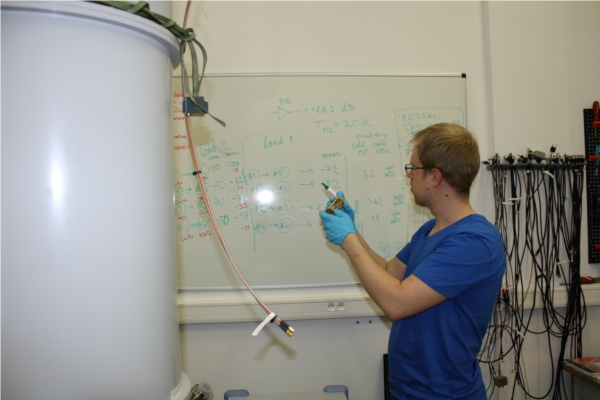
- • Dr. hab. Eng. Anna Wolska - Task 2.14 - Visit from European X-ray Free-Electron Laser GmbH
In the framework of the task 2.14 within the work package "Enhancing of human potential through exchange of know-how and twinning activities with partnering organization" Mr. Tadesse Assefa and Mr. Alexander Britz from European X-ray Free-Electron Laser Facility GmbH visited the Institute on April 13th - 21st, 2015.
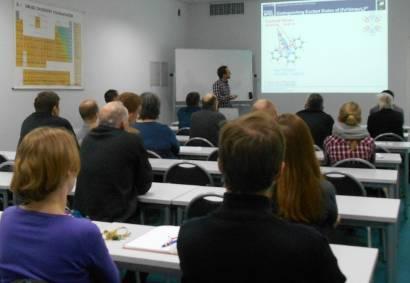 The visit of Mr. A. Britz and Mr. T. Assefa to the Institute was a continuation of their visit in 2014 and aimed at further strengthening the knowledge in the field of time-resolved X-ray spectroscopy and scattering at the IP PAS. Mr. A. Britz and Mr. T. Assefa presented their recent results in the seminar with their talk titled "Tracking chemical reactions with ultrafast X-ray techniques". In their talk they gave an introduction to a suite of different time-resolved X-ray spectroscopic and scattering techniques. They've shown examples of the application of their techniques to solvated iron-centered molecules. Here they focused on model systems for light induced low to high spin transitions as well as ligand exchange mechanisms.
The visit of Mr. A. Britz and Mr. T. Assefa to the Institute was a continuation of their visit in 2014 and aimed at further strengthening the knowledge in the field of time-resolved X-ray spectroscopy and scattering at the IP PAS. Mr. A. Britz and Mr. T. Assefa presented their recent results in the seminar with their talk titled "Tracking chemical reactions with ultrafast X-ray techniques". In their talk they gave an introduction to a suite of different time-resolved X-ray spectroscopic and scattering techniques. They've shown examples of the application of their techniques to solvated iron-centered molecules. Here they focused on model systems for light induced low to high spin transitions as well as ligand exchange mechanisms.
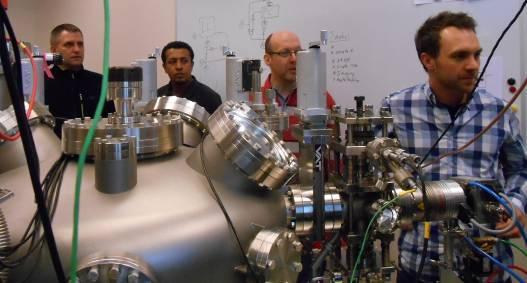 In discussion with Dr. M. Klepka and Dr. A. Wolska they elaborated the potential of these techniques at synchrotrons and XFELs. They discussed future collaborations and experiments in time-resolved X-ray absorption spectroscopy measurements at synchrotrons. Mr. A. Britz and Mr. T. Assefa also had the chance to visit the new-built XPS facility at IP PAN. Furthermore, they participated in the workshop "New challenges and solutions for XAS data analysis part II - FEFF and IFEFFIT for XANES and EXAFS analysis" where the powerful tools for XAFS data analysis have been introduced.
In discussion with Dr. M. Klepka and Dr. A. Wolska they elaborated the potential of these techniques at synchrotrons and XFELs. They discussed future collaborations and experiments in time-resolved X-ray absorption spectroscopy measurements at synchrotrons. Mr. A. Britz and Mr. T. Assefa also had the chance to visit the new-built XPS facility at IP PAN. Furthermore, they participated in the workshop "New challenges and solutions for XAS data analysis part II - FEFF and IFEFFIT for XANES and EXAFS analysis" where the powerful tools for XAFS data analysis have been introduced.
- • Dr. Marcin Klepka - Task 2.1 - Visit from Elettra synchrotron
In the framework of task 2.1 of work package "Enhancing of human potential through exchange of know-how and twinning activities with partnering organization" Dr. Diane Eichert from Elettra, Sincrotrone Trieste S.C.p.A visited the Institute on April 13th - 21st, 2015.
 The main goal of the visit was to discuss the preliminary results of the test measurements performed on the Pt/Co/Pt thin layers fabricated at the IP PAS. The preliminary experiment was carried out in December at the XRF beamline at Elettra where Dr. D. Eichert is a research scientist. The ongoing analysis revealed many questions about the parameters that should be included in the further studies. Additional difficulty in the analysis is lack of appropriate user friendly software for analysis. Therefore, there was also discussion about new software which is being prepared by group of Dr. D. Eichert. Another important topic was discussion about preparation of the next set of samples for potential beamtime in the second part of the year.
The main goal of the visit was to discuss the preliminary results of the test measurements performed on the Pt/Co/Pt thin layers fabricated at the IP PAS. The preliminary experiment was carried out in December at the XRF beamline at Elettra where Dr. D. Eichert is a research scientist. The ongoing analysis revealed many questions about the parameters that should be included in the further studies. Additional difficulty in the analysis is lack of appropriate user friendly software for analysis. Therefore, there was also discussion about new software which is being prepared by group of Dr. D. Eichert. Another important topic was discussion about preparation of the next set of samples for potential beamtime in the second part of the year.
Dr. D. Eichert is also interested in the X-ray absorption spectroscopy technique, therefore, she was invited to participate in the workshop entitled: "New challenges and solutions for XAS data analysis part II - FEFF and IFEFFIT for XANES and EXAFS analysis". She was also invited to visit newly built laboratory where an XPS instrument is located.
- • Dr. hab. Eng. Anna Wolska - Task 2.2: Visit from European Synchrotron Radiation Facility
In the framework of task 2.2 of work package "Enhancing of human potential through exchange of know-how and twinning activities with partnering organization" Dr. Angelika Rosa and Dr. Debora Motta Meira from European Synchrotron Radiation Facility visited the Institute on April 13th - 18th, 2015.
Dr. A. Rosa and Dr. D. Meira are the members of a group of Dr. Sakura Pascarelli - a leader of a X-ray absorption spectroscopy group at the ESRF and a key researcher within a WP 2.2 of the EAgLE project. XAFS group at the ESRF is in charge of several beamlines devoted to XAFS experiments. Among them can be found: (i) a beamline with conventional set-up for basic experiments; (ii) a beamline where XAFS experiments in extreme conditions can be performed; (iii) and also a beamline where very advanced energy dispersive set-up can be used for time resolved XAFS experiments. The future collaboration and possibilities of performing experiments using these sophisticated techniques were discussed.
The visitors were also invited to participate in the workshop entitled: "New challenges and solutions for XAS data analysis part II - FEFF and IFEFFIT for XANES and EXAFS analysis". The scope of the workshop concerned analysis of the X-ray Absorption Near Edge Structure (XANES) and Extended X-ray Absorption Fine Structure (EXAFS) spectra which gave a better insight into analysis of the XAFS data obtained using advanced and sophisticated absorption techniques.
- • Dr. Marcin Klepka - Task 2.1 - Visit from Elettra synchrotron
In the framework of task 2.1 of work package "Enhancing of human potential through exchange of know-how and twinning activities with partnering organization" Dr. Clara Guglieri and Dr. Bridinette Thiodjio Sendja from Elettra, Sincrotrone Trieste S.C.p.A visited the Institute on April 13th - 18th, 2015.
The collaboration between part of the Group of X-ray spectroscopy and microanalysis at IP PAS and XAFS group at Elettra started in January 2015 by the test measurements on the Cu complexes of the coumarin derivatives. Dr. C. Guglieri and Dr. B. Thiodjio Sendja, members of a group of Dr. G. Aquilanti - the beamline scientist at the XAFS beamline at Elettra, were invited to discuss some vital issues connected with the specifics of the measurements on solutions and data analysis.
During their stay both visitors were also participating in the workshop entitled: "New challenges and solutions for XAS data analysis part II - FEFF and IFEFFIT for XANES and EXAFS analysis". Workshop was devoted to the FEFF 9 and IFEFFIT programs used for the X-ray Absorption Near Edge Structure (XANES) and Extended X-ray Absorption Fine Structure (EXAFS) analysis. The topics and examples showed during the workshop helped in further discussion on the analysis of the results for the liquid samples.
- • Dr. Iraida Demchenko - Task 2.4 - Visits from ALBA- synchrotron light facility - Cerdanyola del Valles, Spain
In the framework of task 2.4 of work package "Enhancing of human potential through exchange of know-how and twinning activities with partnering organization" Dr. Marta Avila, Dr. Wojciech Olszewski, and Dr. Carlo Marini, research scientists from ALBA synchrotron light facility, visited IF PAN on April 10th - 18th, 2015.
The general aim of the visit was to strengthen the networking and interdisciplinary communication between the researchers of ALBA synchrotron light facility and IF PAN. Additionally, Dr. Avila, Dr. Marini, and Dr. Olszewski participated in the workshop entitled “New challenges and solutions for XAS data analysis, part II - FEFF and IFEFFIT for XANES and EXAFS analysis” organized by IF PAN in the framework of realization of EAgLE project.
The working visit started from the meeting with the task 2.4 leader of EAgLE project Dr. Demchenko during which the current plans concerning collaboration in the framework of realization of the task 2.4 were discussed. Series of discussions with SL 1.2 specialists were conducted to look into the possibilities of XAFS data acquisition and analysis at CLÆSS beamline. One of the central issues of discussions was related to the potential joint grant application tentatively entitled “GEM prospects in Synchrotron Radiation Applications” aimed for submission to the FET Open call (Horizon 2020 program).
Taking into account that FET Open supports early-stage joint science and technology research around new ideas for radically new future technologies, a joint project for construction of a new detector using GEM technology for synchrotron applications was proposed by IF PAN research scientists in collaboration with IFPiLM (Warsaw, Poland) specialists. Development and testing of such detector will build up a diverse portfolio of our Institutes to explore a wide range of new technological possibilities of such detector, inspired by cutting-edge science, unconventional collaborations, new research and innovation practices. Besides IF PAN and IFPiLM, the involvement from two divisions of ALBA synchrotron light facility: CLÆSS beamline and Department of Electronics – is planned. The structure of the grant application as well as the roles of all partners in preparation of the grant application were established during this stay.
If realized, the FET Open joint application will reinforce the research capacity of the IF PAN specialists by their local recruitment and through support of secondments to EU partner synchrotron Lab ALBA will have a significant impact on increasing of IF PAN researchers' skills in the field of modern materials characterization by synchrotron techniques. All of that would cause a potential increase of research in the IF PAN.
- • Prof. Dr. hab. Maciej Sawicki - Task 2.5 - Visit from Institute of Solid State Physics, University of Bremen, Germany
In the framework of the task 2.5 of the work package "Enhancing of human potential through exchange of know-how and twinning activities with partnering organization",Prof. Detlef Hommel from nstitute of Solid State Physics, University of Bremen, Germany visited the Institute in the period of March 3rd – 5th, 2015.
After a decade of contradicting reports, the last years have witnessed a breakthrough progress in the understanding of magnetism of (Ga,Mn)N. This is of a paramount relevance to the spintronics researches since the GaN, the parent compound, has already reached the state of being the second most important semiconductor after silicon and because due to a strong p-d hybridization the Mn2+/3+ acceptor level occupies the mid band gap position in GaN – what makes the (Ga,Mn)N compound an insulating ferromagnet. During the stay Prof. D. Hommel took part in a series of meetings with Prof. T. Dietl and Prof. M. Sawicki (including other scientists from the Laboratory of Cryogenic and Spintronic Research) devoted to the selected topics of the molecular beam epitaxy growth of various (Ga,Mn)N containing structures for spintronics applications. Three main areas of interest were identified: (i) single phase, homogenous layers with as high Mn content as possible to extend the magnetic phase diagram of (Ga,Mn)N and so to check the validity the superexchange-driven model of ferromagnetism in this material; (ii) superlattice-like (Ga,Mn)N/GaN:Mg structures to explore the influence of charge transfer effects on the magnetic ground state; and (iii) (Ga,Mn)N/GaN:Si structures for gating experiments.
- • Dr. hab. Sławomir Kret - Task 2.3 - Visit from Department of Physics, University of Warwick, United Kingdom
In the framework of task 2.3 of work package "Enhancing of human potential through exchange of know-how and twinning activities with partnering organization" Prof. Chris McConville from Department of Physics, University of Warwick, United Kingdom visited the Institute on February 25th - 27th, 2015.
Prof. Chris McConville participated in part of Worshop starting from 25 February. Prof. Chris McConville gave a seminar lecture entitled “ARPES and XPS of CdO” he also take an e active part during panel discussion about ongoing research within the EAgLE project and future grant application within HORIZON 2020 as one of the British partners. During these discussions, we agreed that both centres have great potential and complementary experience in the field of characterization of TEM, XPS and XRD methods. However, it is necessary to focus on the search for industrial partners to ensure success of common application for Horizont 2020 competitions. He also declared help in search of such partners.
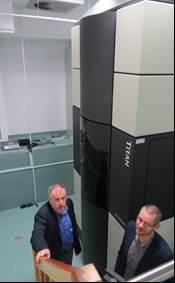
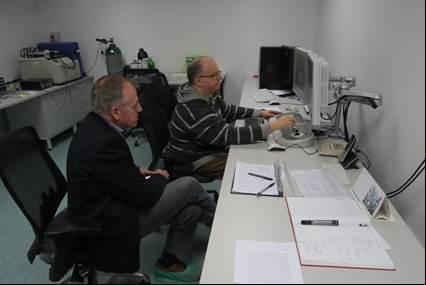
Prof. Chris McConville and Dr Aleksander Krupski visiting TEM laboratory.
- • Dr. hab. Sławomir Kret - Task 2.3 - Visit from Department of Physics, University of Warwick, United Kingdom
In the framework of task 2.3 of work package "Enhancing of human potential through exchange of know-how and twinning activities with partnering organization" Dr. Anna Sanchez from Department of Physics, University of Warwick, United Kingdom visited the Institute on February 23th - 27th, 2015.
Dr. Ana Sanchez helped lead the Twinning Seminar between the Institute of Physics Polish Academy of Science and the University
of Warwick.
Dr. Ana Sanchez gave also a seminar lecture entitled “Progress and perspectives in microscopy of low dimensional materials”.
Dr. Ana Sanchez take active part during panel discussion about ongoing research within the EAgLE project and future
grant application within HORIZON 2020 as one of the British partners.
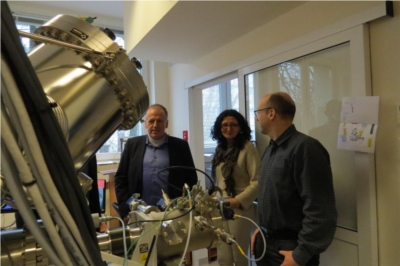
Dr.Ana Sanchez, Prof. Chris McConville and Dr Laurent Nittler, during tests of new XPS equipment.
- • Dr. hab. Sławomir Kret - Task 2.3 - Visit from Department of Physics, University of Warwick, United Kingdom
In the framework of task 2.3 of work package "Enhancing of human potential through exchange of know-how and twinning activities with partnering organization" Dr. Katarzyna Krupski from Department of Physics, University of Warwick, United Kingdom visited the Institute on February 18th - March 1st, 2015.
Dr. Katarzyna Krupski helped to prepare, organize and lead the Twinning Seminar between the Institute of Physics Polish Academy of Science and the University of Warwick. She prepared together with Laurent Niter exercises devoted to use of the CASA program to XPS spectra analysis.
During the visit Dr. Katarzyna Krupski presented results of her ongoing research focused on the anatase phase of TiO2(001) layers grown by Pulsed Laser Deposition method on LaAlO3(001) substrate studied with the use of HREED, XRD, HRR, AFM, LEED (incl. I-V LEED/CLEED), XPS, SXRD, DFT methods. Dr. Katarzyna Krupski gave also a seminar lecture entitled “Structural Optimization Of Titanium Dioxide of (4×1) Reconstruction for Photocatalytic Applications”.
Additionally, after workshop, Dr. Katarzyna Krupski, Dr. hab. Sławomir Kret and Dr. hab. Aleksander Krupski participated in the meeting devoted to presentation of possibilities of the CASTEP software in modeling of surface atomic structure, what is necessary to understanding the LEED patterns.
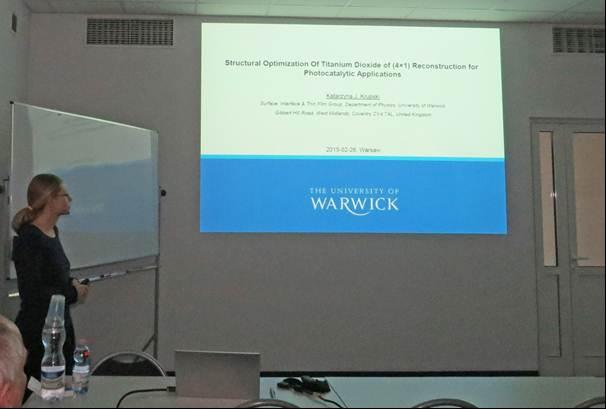
Dr. Katarzyna Krupski during lecture.
- • Dr. hab. Sławomir Kret - Task 2.3 - Visit from Department of Physics, University of Warwick, United Kingdom
In the framework of task 2.3 of work package "Enhancing of human potential through exchange of know-how and twinning activities with partnering organization" Dr. Aleksander Krupski from Department of Physics, University of Warwick, United Kingdom visited the Institute on February 18th - March 1st, 2015.
Dr. Aleksander Krupski helped to prepare, organize and lead the Twinning Seminarbetween the Institute of Physics Polish Academy of Science and the University of Warwick.
During the visit Dr. Krupski presented briefly examples of using the experimental and theoretical methods like Scanning Tunneling Microscopy (STM), Low Energy Electron Diffraction (LEED), Auger Electron Spectroscopy (AES), X-ray Photoelectron Spectroscopy (XPS), Angle-Resolved Photoemission Spectroscopy (ARPES), Density Functional Theory (DFT) and CLEED calculations.
At the same time, Dr. Krupski took active part during panel discussion about ongoing research within the EAgLE project and future grant application within HORIZON 2020 as one of the British partners.
Under the arrangements during the Twinning Seminar Dr. Krupski is going to try to perform RT-STM studies of GaAs samples provided by Dr. Iraida Demchenko, Dr. Dr Yevgen Melikhov and HRTEM samples provided by Dr. hab. Sławomir Kret.
Dr. Aleksander Krupski gave also a seminar lecture entitled “Growth morphology of thin films on the metallic and oxide surfaces”.
Aleksander Krupski participated in the meeting devoted to presentation of possibilities of the CASTEP software in modeling of surface atomic structure, what is necessary to understanding the LEED patterns.
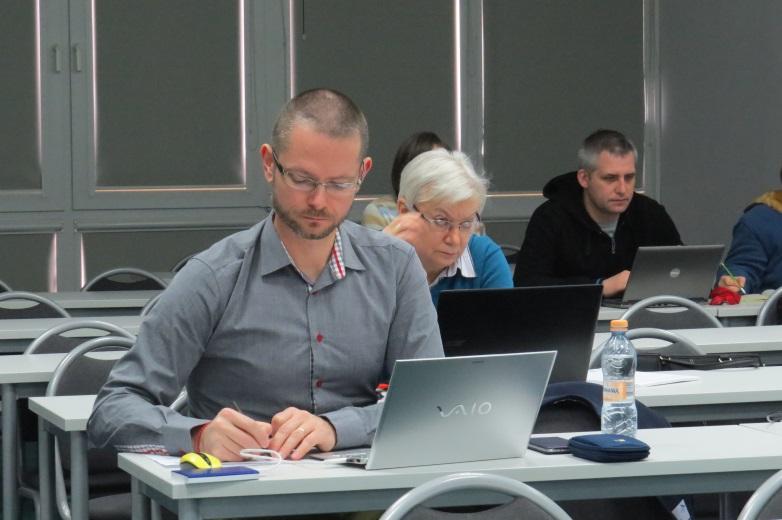
Dr. K. Krupski, Prof. Krystyna Jabłonska and Dr. Marcin Klepka during Practical lab: XPS spectra analysis , CASA program.
- • Dr. Vitalii Ivanov - Task 2.13 - Visit from Dortmund Technical University, Dortmund, Germany
In the framework of task 2.13 of work package "Enhancing of human potential through exchange of know-how and twinning activities with partnering organization" Dr. Jorg Debus from Dortmund Technical University, Dortmund, Germany visited the Institute on February 8th - 21st, 2015.
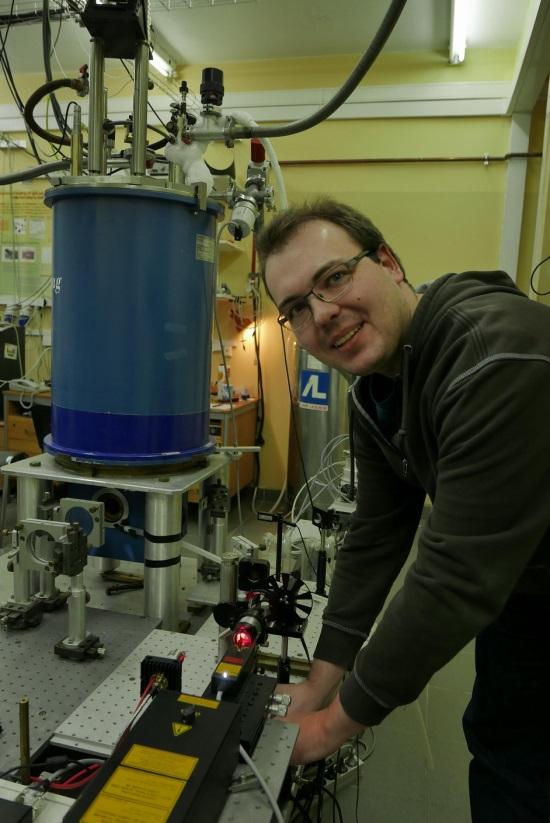 The research visit was held in the laboratory of magneto-optical resonances of ON4.2 research group of IFPAN. In detail, the polarization of the exciting laser light was modulated with a photo-elastic modulator and temporally synchronized with 60-GHz microwave pulses and the detection hardware based on a charged-coupled-device camera. Using this advanced extension of the experimental setup we studied how the linear and circular polarization of the exciting laser light influences the polarization properties of the ODMR of nitrogen vacancies as well as isolated nitrogen impurities in diamond crystals. A high sensitivity of the polarization degrees of their ODMR signals on the polarization of the exciting light as well as on the crystal orientation and magnetic field direction were observed. These strong dependences open novel insights into the spin physics and the mutual interactions of nitrogen defect centers in diamond crystals being very promising for quantum information technology and spin-electronics applications. As a next step, the extended experimental approach shall show its possibilities for room temperature measurements.
The research visit was held in the laboratory of magneto-optical resonances of ON4.2 research group of IFPAN. In detail, the polarization of the exciting laser light was modulated with a photo-elastic modulator and temporally synchronized with 60-GHz microwave pulses and the detection hardware based on a charged-coupled-device camera. Using this advanced extension of the experimental setup we studied how the linear and circular polarization of the exciting laser light influences the polarization properties of the ODMR of nitrogen vacancies as well as isolated nitrogen impurities in diamond crystals. A high sensitivity of the polarization degrees of their ODMR signals on the polarization of the exciting light as well as on the crystal orientation and magnetic field direction were observed. These strong dependences open novel insights into the spin physics and the mutual interactions of nitrogen defect centers in diamond crystals being very promising for quantum information technology and spin-electronics applications. As a next step, the extended experimental approach shall show its possibilities for room temperature measurements.
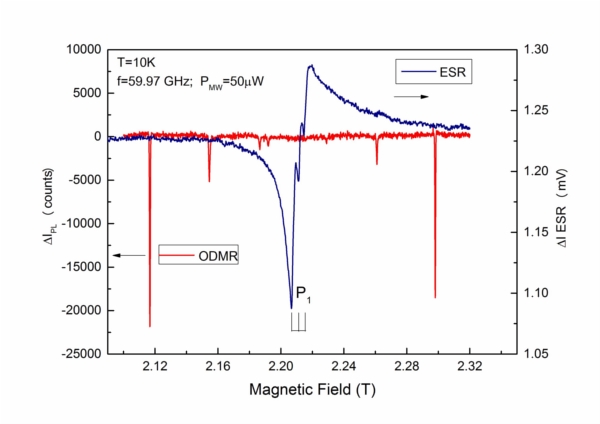
DMR and ESR spectra of diamond doped with NV-centers. Only isolated nitrogen impurity spectrum is observed in ESR, but NV- center appears in ODMR.
- • Prof. Dr. hab. Tomasz Dietl - Task 2.7 - Visit from NCSR 'Demokritos', Athens, Greece
In the framework of task 2.7 of work package "Enhancing of human potential through exchange of know-how and twinning activities with partnering organization" Dr. Kalliopi Trohidou from NCSR 'Demokritos', Athens, Greece visited the Institute on January 8th - 10th, 2015.
The aim of the visit was to gain knowledge about the development of theoretical methods suitable for quantitative description by Monte Carlo and related methods of ferromagnetic and antiferromagnetic nanocrystals.
Dr. Trohidou is the Director of Research at NCSR 'Demokritos' involved in theoretical studies of magnetic nanostructures and their applications. Following the recent successful collaboration [common paper “Phase diagram and critical behavior of the random ferromagnet Ga1-xMnxN“ - S. Stefanowiczet al., Phys. Rev. B 88, 081201 (2013)], the visit allowed the IFPAN researchers to gain knowledge about the development at Democritos of theoretical methods suitable for quantitative description by Monte Carlo and related methods of ferromagnetic and antiferromagnetic nanocrystals as well as of core/shell structures, particularly relevant for the development of recording media. In this context perspectives of common projects were discussed.
During her stay, Dr. Trohidou delivered the talk “Multiscale Modelling of the exchange bias behaviour of magnetic nanoparticles with core/shell (surface) morphology and their assemblies”, in which the state-of-the-art theoretical approaches were presented.
The visit provided an extended knowledge about theoretical methods, perspectives of common projects resulting from the established scientific collaboration were discussed and it was agreed to continue of collaboration aiming in theoretical modelling of materials of interest for the Institute of Physics.
- • Prof. Dr. hab. Maciej Sawicki - Task 2.6 - Visit from University of Wuerzburg, Experimentelle Physik III, Wuerzburg, Germany
In the framework of task 2.6 of work package "Enhancing of human potential through exchange of know-how and twinning activities with partnering organization" Mirko Trabel from University of Wuerzburg, Germany visited the Institute between November 30th - December 14th, 2014.
The aim of the visit was to update IFPAN scientist with the current state of the magnetic measurements and the experimental methodology of the new spintronics material: layered MnSi, with the main emphasis put onto the measurements in perpendicular configuration. The expected outreach of this visit is to lay down plans for the joint collaboration IFPAN-UWue on this material.
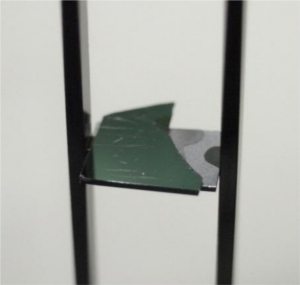 Fermi liquid theory provides a remarkably powerful framework for the description of the conduction electrons in metals and their ordering phenomena, such as superconductivity, ferromagnetism, and spin- and charge-density-wave order. A different class of ordering phenomena of great interest concerns spin configurations that are topologically protected, that is, their topology can be destroyed only by forcing the average magnetization locally to zero. A central question concerns the nature of the metallic state in the presence of such topologically distinct spin textures. It has been found that metallic state at the border of the skyrmion lattice in MnSi represents a new form of magnetic order composed of topologically non-trivial vortices. It is therefore of a paramount importance to provide a dedicated magnetic characterisation of this material in combination with the magnetoconductivity studies.
Fermi liquid theory provides a remarkably powerful framework for the description of the conduction electrons in metals and their ordering phenomena, such as superconductivity, ferromagnetism, and spin- and charge-density-wave order. A different class of ordering phenomena of great interest concerns spin configurations that are topologically protected, that is, their topology can be destroyed only by forcing the average magnetization locally to zero. A central question concerns the nature of the metallic state in the presence of such topologically distinct spin textures. It has been found that metallic state at the border of the skyrmion lattice in MnSi represents a new form of magnetic order composed of topologically non-trivial vortices. It is therefore of a paramount importance to provide a dedicated magnetic characterisation of this material in combination with the magnetoconductivity studies.
To this end a new technique of magnetic SQUID measurements in perpendicular orientation had to be elaborated and thoroughly tested. During the stay Mr. Trabel together with Prof. Maciej Sawicki tested a few ideas of special sample holders allowing for accurate measurements and data manipulations of small samples grown on silicon substrates. These tests consisted of full hysteresis (magnetic moment as a function of magnetic field) measurements in the field range of +/- 70 kOe at room temperature and 2-3 very low temperatures as 20, 5 and 2 K. The analysis of the test allowed the selection of the best configuration which allowed both room and low temperature studies of the thin MnSi layers on Si substrates. The basic idea is exemplified on the figure: the sample (a nonregular body) is placed on a very thin Si support plate which in turn is placed between two thicker Si rods cut from industry-standard Si wafers.
- • Dr. hab. Eng. Anna Wolska - Task 2.2 -Visit from European Synchrotron Radiation Facility
In the framework of task 2.2 of work package "Enhancing of human potential through exchange of know-how and twinning activities with partnering organization" Dr. Sara Lafuerza Bielsa from European Synchrotron Radiation Facility visited the Institute on September 28th - October 7th, 2014.
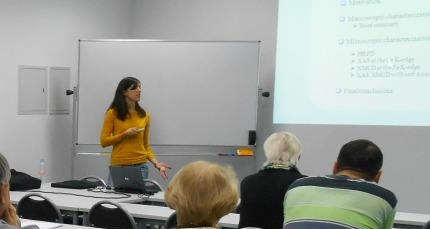 During the visit at the IP PAS, Dr. Sara Lafuerza gave a seminar entitled: "LuFe2O4: a potential multiferroic studied by synchrotron radiation techniques". She focused on the LuFe2O4 which is among the most studied candidates for multiferroic compound. She presented the results of a complete structural and electronic microscopic characterization of LuFe2O4 by means of various synchrotron radiation based techniques: high resolution powder diffraction (HRPD), X-ray absorption spectroscopy (XAS) and X-ray magnetic circular dichroism (XMCD).
During the visit at the IP PAS, Dr. Sara Lafuerza gave a seminar entitled: "LuFe2O4: a potential multiferroic studied by synchrotron radiation techniques". She focused on the LuFe2O4 which is among the most studied candidates for multiferroic compound. She presented the results of a complete structural and electronic microscopic characterization of LuFe2O4 by means of various synchrotron radiation based techniques: high resolution powder diffraction (HRPD), X-ray absorption spectroscopy (XAS) and X-ray magnetic circular dichroism (XMCD).
Another part of the visit was devoted to discussing and constructing the example input files of the FDMNES code with Dr. A. Wolska. This program is created and developed at the ESRF and is used to calculate X-ray absorption near edge structure (XANES) spectra. It employs ab initio approach which eliminates all the methodological parameters. The code uses two techniques of fully relativistic monoelectronic calculations (DFT-LSDA) with optionally the Hubbard correction (LSDA+U). The first one allows to avoid the mufin-tin (MT) approximation. The second one uses the Green formalism on an MT potential. For most structures the approach using MT potential works well enough, however, for some of the systems it is not always sufficient. Among them there are some of the metal-organic complexes investigated in the Group of X-ray spectroscopy and microanalysis. Dr. Lafuerza was also participating in the workshop entitled: "WIEN2k and SPECTROSCOPY: HANDS-ON WORKSHOP" devoted to the WIEN2k code.
- • Prof. Dr. hab. Krystyna Jabłonska - Visit from Elettra synchrotron, Trieste, Italy
In the framework of task 2.1 of work package "Enhancing of human potential through exchange of know-how and twinning activities with partnering organization" Diane Eichert from Elettra synchrotrone EAgLE scientific partner, visited the Institute between September 28th and October 4th, 2014.
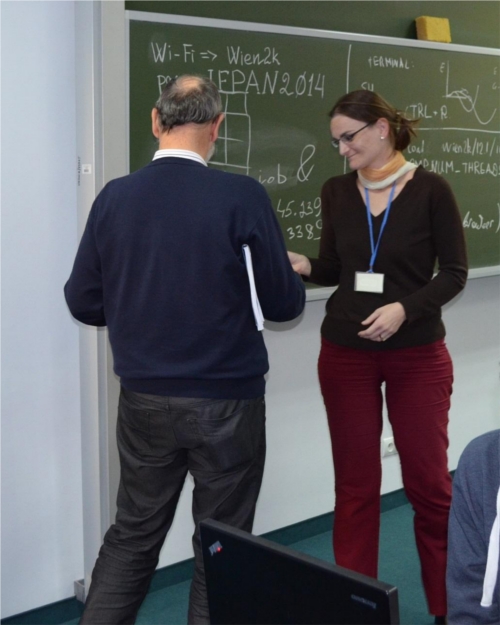 The aims of the visits were: meetings with scientists interested in exploiting X-Ray fluorescence beamline at the Elettra synchrotron, discussion of the performed experiments and plan for the upcoming experiments as well as participation in the WIEN2k workshop organized in the framework of EAgLE project on 29. 09 – 2.10. 2014.
The aims of the visits were: meetings with scientists interested in exploiting X-Ray fluorescence beamline at the Elettra synchrotron, discussion of the performed experiments and plan for the upcoming experiments as well as participation in the WIEN2k workshop organized in the framework of EAgLE project on 29. 09 – 2.10. 2014.
The one week visit of Diane Eichert was very productive for scientists from the Laboratory of X-Ray and Electron Microscopy Research. The testing experiments have been performed at the X-Ray Fluorescence beamline at Elltra and these first results were discussed. The visits at the Elettra of two groups from X-Ray Laboratory were planned for the November and December 2014 and the technical requirements for the samples were talked about. In the following days she was participated together with scientists from IFPAN in the workshop devoted to WIEN2k code application to calculate density of states distribution in ordered structures and from that simulate various experimental spectra. The four days of working together and discussing the application of WIEN2k code for simulation the X-ray emission and absorption spectra provided the perfect forum for preparing the background for future collaboration.
- • Dr. hab. Eng. Anna Wolska - Visit from European Synchrotron Radiation Facility
In the framework of task 2.2 of work package "Enhancing of human potential through exchange of know-how and twinning activities with partnering organization" Dr. Angela Trapananti from European Synchrotron Radiation Facility visited the Institute on September 25th - October 3th, 2014.
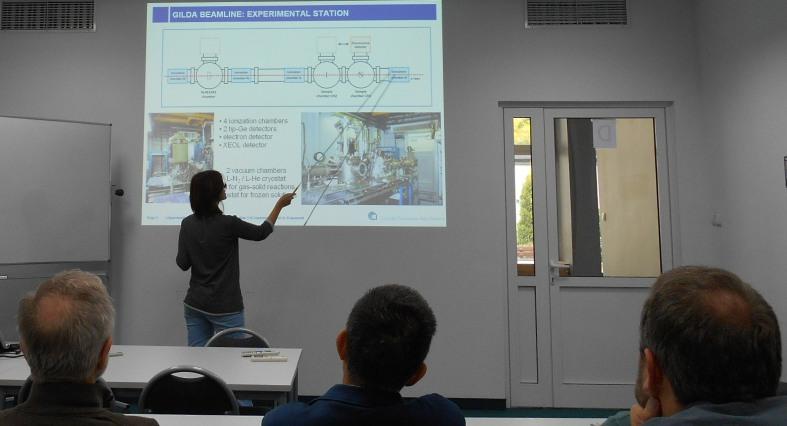 At the beginning of the visit at the IP PAS, Dr. Angela Trapananti gave a seminar entitled: "Experimental Opportunities for X-ray Absorption Spectroscopy studies at GILDA beamline (ESRF)". She showed the most important technical information about the beamline and focused on the examples of studies performed there. In particular she presented the results of investigations on natural gemstones (how to relate their colour with the local environment of transition metals) and on materials for electrodes (in relation with their electrochemical performance in Li-ion batteries).
At the beginning of the visit at the IP PAS, Dr. Angela Trapananti gave a seminar entitled: "Experimental Opportunities for X-ray Absorption Spectroscopy studies at GILDA beamline (ESRF)". She showed the most important technical information about the beamline and focused on the examples of studies performed there. In particular she presented the results of investigations on natural gemstones (how to relate their colour with the local environment of transition metals) and on materials for electrodes (in relation with their electrochemical performance in Li-ion batteries).
During her visit Dr. Trapananti was also participating in the workshop entitled: "WIEN2k and SPECTROSCOPY: HANDS-ON WORKSHOP" devoted to the WIEN2k code which is a very versatile tool to perform electronic structure calculations with the Full Potential LAPW method. Another part of the visit was devoted to giving an introduction to the GNXAS code to Dr. M. Klepka. This program is created and developed by the group at the University of Camerino and is used to analyse extended X-ray absorption fine structure (EXAFS) spectra. It is a very sophisticated and advanced software based on multiple-scattering calculations and a rigorous fitting procedure of the raw experimental data. The methodology of the program differs substantially from the most popular code, i.e. IFEFFIT, and needs more help and deeper introduction before starting data analysis.
- • Prof. Josep Fontcuberta and Dr. Mateusz Scigaj - isit from the Institut de Ciència de Materials de Barcelona, Spain.
In the framework of task 2.12 of work package "Enhancing of human potential through exchange of know-how and twinning activities with partnering organization" Prof. Josep Fontcuberta and Dr Mateusz Scigaj from the Institut de Ciència de Materials de Barcelona (ICMAB-CSIC) , Bellaterra, Spain visited IF PAN in the period: September 15th - 19th , 2014.
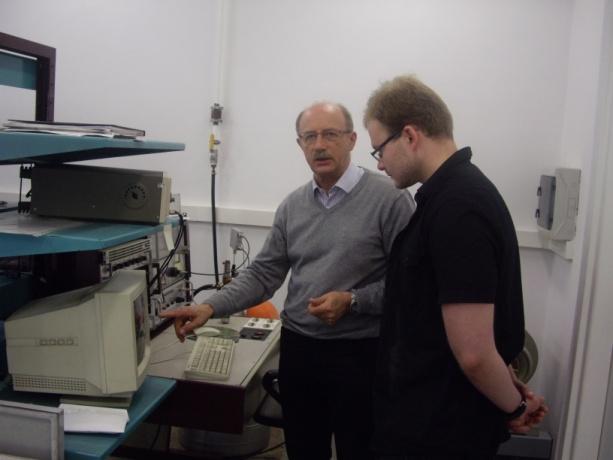 The aim of the visit was (a) to discuss the 55Mn NMR measurements carried out recently in IFPAN on half doped manganite thin films grown in ICMAB, (b) to plan further NMR experiments on this system and a new research related to manganite oxides surface and interfaces, (c) to deliver three invited lectures (prof. J. Fontcuberta) and one contributing oral presentation (dr M. Scigaj) at the symposia of the 2014 Fall Meeting of E-MRS, that were co-organized by the EAgLE project.
The aim of the visit was (a) to discuss the 55Mn NMR measurements carried out recently in IFPAN on half doped manganite thin films grown in ICMAB, (b) to plan further NMR experiments on this system and a new research related to manganite oxides surface and interfaces, (c) to deliver three invited lectures (prof. J. Fontcuberta) and one contributing oral presentation (dr M. Scigaj) at the symposia of the 2014 Fall Meeting of E-MRS, that were co-organized by the EAgLE project.
During their visit at IF PAN professor Fontcuberta and dr Mateusz Ścigaj discussed with the members of NMR group the results of the recent 55Mn NMR experiments carried out in IF PAN on 20 and 35 nm thick thin films of half doped manganites La0.5Sr0.5MnO3 grown on oxide substrates with a different lattice mismatch in order to induce different strain effect in the half doped manganite. The discussions led to the following conclusions: (1) Strain induces a separation into antiferromagnetic and ferromagnetic phases rather than reducing an overall magnetization of a film as could be assumed from the macroscopic magnetization measurements.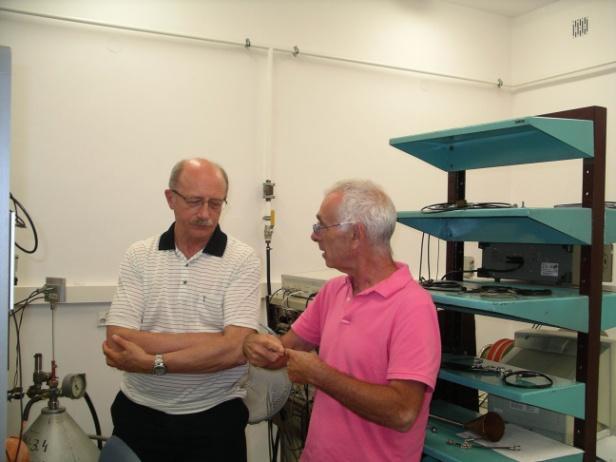 (2) A degree of the phase separation depends on film thickness and on magnetic history of the film. (3) Besides the phase separation also electronic charge redistribution takes place between the ferromagnetic and the antiferromagnetic phases. These results will be published in a joint publication.
(2) A degree of the phase separation depends on film thickness and on magnetic history of the film. (3) Besides the phase separation also electronic charge redistribution takes place between the ferromagnetic and the antiferromagnetic phases. These results will be published in a joint publication.
Besides, Professor Fontcuberta shared his knowledge with a larger EAgLE community, participating as an invited lecturer in the 2014 Fall Meeting of the European Materials Research Society (E-MRS). Several symposia at this meeting were co-organized by the EAgLE project. He delivered three invited talks presenting the research carried out by the ICMAB group. Also dr Scigaj presented the results of his studies related to the topic of our twinning programme at the 2014 Fall Meeting of the E-MRS.
- • Prof. Dr. hab. Maciej Sawicki - Task 2.6 - Visit from University of Wuerzburg, Experimentelle Physik III, Wuerzburg, Germany
In the framework of task 2.6 of work package "Enhancing of human potential through exchange of know-how and twinning activities with partnering organization" Christoph Brüne, Raimund Schlereth, Philipp Leubner, and Simon Hartinger from University of Wuerzburg, Germany visited the Institute between September 14th - 20th, 2014.
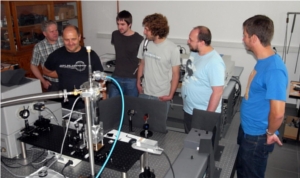 The aim of the visit was to provide IFPAN community with the most recent advances in the electronic transport and related phenomena in various topological insulators (TI) aiming at finding the most relevant effects for spintronics applications. Also, to present the recent progress during Warsaw’s E-MRS Fall Meeting symposia that were co-organized by the EAgLE project.
The aim of the visit was to provide IFPAN community with the most recent advances in the electronic transport and related phenomena in various topological insulators (TI) aiming at finding the most relevant effects for spintronics applications. Also, to present the recent progress during Warsaw’s E-MRS Fall Meeting symposia that were co-organized by the EAgLE project.
The four guests from Wurzburg University belong to world leading group investigating various aspects of the physics of TI. During the visit to IFPAN they had numerous vivid and long lasting discussions with IFPAN TI investigators, both experimentally
and form theoretical point of view. These include Profs. T. Story, R. Buczko, G. Grabecki and P. Kacman as well as the members of their teams from three scientific divisions of IFPAN. They also set on lab visiting tour around the relevant experimental facilities of IFPAN, sharing their expertise and knowledge on the subject.
Apart from personal contacts in various (small) groups at IFPAN the scientists shared their knowledge with a larger EAgLE community, participating in the Symposium T (Topological materials II) E-MRS Fall Meeting and giving the following presentations:
• (invited lecture) “Electron transport in the topological edge and surface states of HgTe”.
• (poster) “New gating technique for HgTe/HgCdTe-Heterostructures”.
• (poster) “Magnetic contacts on strained HgTe”.
• (poster) “The effect of strain on the two-dimensional topological insulator HgTe”.
- • Dr. Iraida Demchenko - Visit from ALBA- synchrotron light facility - Cerdanyola del Valles, Spain
In the framework of task 2.4 of work package "Enhancing of human potential through exchange of know-how and twinning activities with partnering organization" Dr. E. Pellegrin, research scientist from ALBA synchrotron, visited IF PAN on September 14th - 19th, 2014.
The visit aims of Dr. Pellegrin were to improve the capacity of IF PAN in the: (i) direction of designing a beamline for the XAFS/RIXS measurements in the soft X region at Polish synchrotron Solaris; (ii) field of characterization and interpretation of the experimental data of modern materials by X-ray spectroscopy. In addition the research meetings with the head of the Task 2.4 and with the IF PAN scientists were also planned. A research seminar for the employees of institute was scheduled.
Dr. Pellegrin’s working visit started with the meeting with the Task 2.4 leader of EAgLE project Dr. Demchenko where current plans concerning collaboration in the framework of realization of the Task 2.4 were discussed. The scheduled seminar entitled 'Opportunities for Soft X-Ray Spectroscopies at the CELLS-ALBA Synchrotron Light Source' was delivered by Dr. Pellegrin on September 18, 2014. This followed by the series of discussions with the ‘Group of X-ray spectroscopy and microanalysis’ specialists was conducted regarding the possibilities of XAFS/RIXS/XMCD/NAPP/PEEM/TXM data acquisition and analysis at CLÆSS, BOREAS, CIRCE, MISTRAL beamlines. In addition, the meetings with Prof. Baczewski, Prof. Kossut, Dr. Jakubczyk, and Prof. Kolwas resulted in agreement that Dr. Pellegrin will critically review the scientific applicability of the CIRCE as well as the BOREAS beamlines to the research directions pursued at the IF PAN (e.g., magnetic oxides, magnetic heterostructures, etc.). Finally, at the end of Dr. Pelligrin’s visit, time and duration for next visits were approved. It was again positively confirmed that such reciprocal visits between the IF PAN and EU partnering organizations in general and ALBA synchrotron in paryicular, have a significant impact on increasing of skills of the IF PAN scientists in the field of characterization of modern materials by synchrotron techniques, in this case, RIXS/XMCD/NAPP/PEEM/TXM.
- • Prof. Dr. hab. Maciej Sawicki - Visit from School of Physics & Astronomy, The University of Nottingham, Nottingham, UK
In the framework of task 2.11 of work package "Enhancing of human potential through exchange of know-how and twinning activities with partnering organization" Peter Wadley, Bryan Gallagher, Shahed Khan Mohamad, and Bryn Howells from School of Physics & Astronomy, The University of Nottingham, Nottingham, UK visited the Institute between September 14th - 19th, 2014.
The aim of the visit was to present to the IFPAN scientific community the most recent progress and expected directions of development of growth related and experimental challenges in antiferromagnetic spintronics. Also, to deliver an invited talk on this subject by one of the guests during Warsaw’s E-MRS Fall Meeting symposia, co-organized by the EAgLE project, to IFPAN participants and a broad international audience.
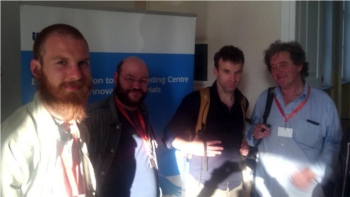 The four guests from Nottingham University belong to currently world leading inter-laboratory group investigating AFM spintronics in AFM I-II-V semiconductors such as LiMnAs, NaMnAs, and CuMnN. During meetings held at IFPAN with scientists from Laboratory of Cryogenic Research and Spintronics and Division of Physics of Semiconductors, including Profs. T. Dietl, M. Sawicki, T. Story and Dr. Podgorni the visitors presented and discussed various aspects of the growth and characterization of these materials.
The four guests from Nottingham University belong to currently world leading inter-laboratory group investigating AFM spintronics in AFM I-II-V semiconductors such as LiMnAs, NaMnAs, and CuMnN. During meetings held at IFPAN with scientists from Laboratory of Cryogenic Research and Spintronics and Division of Physics of Semiconductors, including Profs. T. Dietl, M. Sawicki, T. Story and Dr. Podgorni the visitors presented and discussed various aspects of the growth and characterization of these materials.
Besides these direct group meetings at IFPAN the recent achievements in AFM spintronics of the Nottingham group were presented to a larger EAgLE community, participating in the Symposium X (Antiferromagnetic Spintronics) of 2014 Fall Meeting of the European Materials Research Society (E-MRS) by delivering an invited talk entitled: “Tetragonal CuMnAs thin films for antiferromagnetic spintronics”. This was a highly appreciated contribution which spurred numerous discussions on this subject with other participants of the meeting.
- • Dr. hab. Sławomir Kret - Task 2.3 - Visit from Department of Physics, University of Warwick, United Kingdom
In the framework of task 2.3 of work package "Enhancing of human potential through exchange of know-how and twinning activities with partnering organization" Dr. Richard Beanland from Department of Physics, University of Warwick, United Kingdom visited the Institute on August 21st - 31st, 2014.
During the visit Dr. Richard Beanland introduced the principle of a new method of acquisition of the large-angle convergent-beam diffraction (LACBED) patterns.
In proposed approach the tilt of the incident beam was controlled via a computer script to scan over a large angular range (typically up to 0.1 radians) and a diffraction pattern was collected at each different incident beam tilt using the CCD camera. Typically 1000 direction patterns are collected for one beam position in less than 2 minutes. The data from each different diffracted beam are then recombined into a single image using a second computer script, giving a combined digital LACBED (D-LACBED) pattern. For relatively big angular range, useful D-LACBED patterns can be extracted for typically 50–60 different reflections from a single data set.
The increased amount of information significantly improves the interpretation and widens the applicability of the technique, particularly for materials with larger lattice parameters.
The full description of how to setup microscope to obtain such type of diffraction as well as how to combine individual patterns into one big data set was given. Dr. R. Beyland demonstrated also how D-LACBED patterns could be used to determine the symmetry of crystal with unknown structure.
A possibility of the adaptation of this technique, developed initial for Jeol 2010 microscope, into the FEI Titan Microscope installed in IFPAN was discussed. There are some technical obstacles. Mainly this is the presence of the aberration corrector of the objective lens as well as different camera type installed at IFPAN’s microscope which make the acquisition of D-LACBED pattern much slower. It turned out that both significant modification of the scripts and additional information about software control protocol of the corrector lenses are needed to reach an acceptable speed at IFPAN’s FEI Titan to avoid the beam damage of studied sample.
Dr. Richard Beanland gave also a seminar lecture entitled “Pushing the boundaries of symmetry determination with 'digital' electron diffraction”.
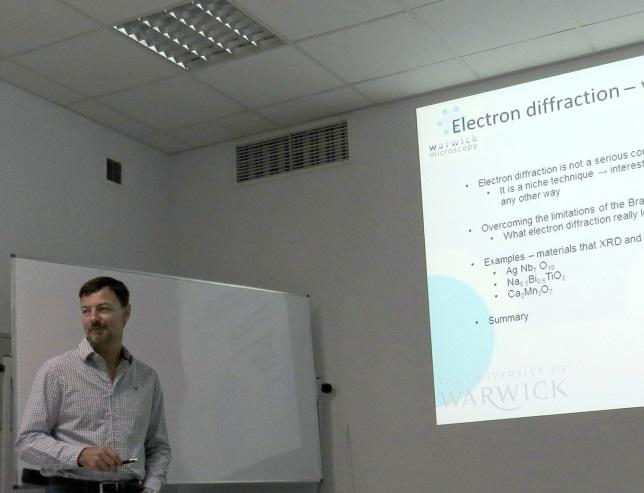

Dr. Richard Beanland during lecture and digital large-angle convergent beam electron diffraction (D-LACBED) pattern from KTiOPO4 (KTP), a combination of over 2500 individual CBED patterns.
- • Dr. hab. Sławomir Kret - Task 2.3 - Visit from Department of Physics, University of Warwick, United Kingdom
In the framework of task 2.3 of work package "Enhancing of human potential through exchange of know-how and twinning activities with partnering organization" Dr. Ana Sanchez from Department of Physics, University of Warwick, United Kingdom visited the Institute between August 21st - 31st, 2014.
The transition-metal dichalcogenides (TMD) MX2 have a layered structure, with just Van der Waals forces between the layers. The properties of bulk TMD range from insulators (i.e. HfS2) to metallic monolayers of semiconducting TMD exhibiting a direct band gap, have promise to complement the zero band gap energy of graphene, offering an extensive range of applications in electronics and optics.
During visit Dr. Ana Sanchez presented current stage of research and achievements of the Warwick Microscopy group concerning the study of the heterojenctions crated in two dimension sheets of such materials by lateral grow. Different acquisition strategy permitting observation such ultrathin beam sensitive material were tested. Dr. Sanchez proposed to apply special acquisition script permitting obtain the best signal/noise ratio by using fast scanning approach with automatic alignment and summation of the frames. Analysis of existing data sets as well as other simulation of the STEM images performed during the visit of Dr. A. Sanchez showed that good enough contrast between one and two sheets of MoSe2/WSe can be obtained for specific camera lengths with the use Angular Dark Field detector (ADF). Dr. Sanchez demonstrated the methodology of analysis permitting determination of the stacking type of such 2D structure bounded only by Van der Waals forces on the base of the planar images. Finally, a feasibility of determination of the local electronic properties of such structures by using the HR–EELS with the use of monochromated microscope installed in IFPAN was tested.
- • Dr. hab. Sławomir Kret - Task 2.3 - Visit from Department of Physics, University of Warwick, United Kingdom
In the framework of task 2.3 of work package "Enhancing of human potential through exchange of know-how and twinning activities with partnering organization" Dr. Jeremy Sloan from Department of Physics, University of Warwick, United Kingdom visited the Institute between August 3th - 8th, 2014.
During his stay in the Institute Prof. Sloan delivered a seminar lecture entitled "High Resolution Transmission Electron Microscopy advanced imaging of low dimensional crystals". He presented investigations of two new systems, SWCNT embedded SnSe5 which undergoes band gap expansion, as well as shear induced phase change behaviour in SWCNTs with diameters >1.4 nm and also experimental studies of two-atom thick SWCNT-embedded HgTe extreme nanowires. The TEM results were compared with Raman spectra measured for ensembles of bundled filled tubes for excitation photon energies in the ranges 3.39 to 2.61eV and 1.82 to 1.26eV for Raman shifts down to ~25 cm-1 and sample temperatures in the range 4-300K. All of the evidence support the hypothesis that the observed Raman features are not attributable to single walled carbon nanotubes, but instead to the HgTe nanowires. The observed additional features are due to four distinct phonons, with energies 47, 51, 94 and 115 cm-1 respectively, plus their overtones and combinations. These facts were subject for further discussion leading to agreement of common HRTEM experiment with high energetic electron beam. A part of that experiment have been done on the specimens delivered by Prof. J. Sloan. The experimental results confirmed the preliminary assumptions that the 300 keV electron bundle is suitable for observation of 1D crystals.
- • Prof. Dr. hab. Maciej Sawicki - Visit from University of Wuerzburg, Experimentelle Physik III, Wuerzburg, Germany
In the framework of task 2.6 of work package "Enhancing of human potential through exchange of know-how and twinning activities with partnering organization" Dr. Tatiana Borzenko from University of Wuerzburg, Germany visited the Institute between July 7th - 11th, 2014.
The aim of the visit was to provide IFPAN community with the tutorial on the recent advances in techniques used in e-beam nanolithography.
During the stay at the Institute of Physics Dr. Borzenko held a number of hands-on training courses aiming to familiarize the IFPAN community with the recent advances in techniques used in e-beam nanolithography. These tutorial-like meetings were concentrated on three main subjects:
1.) New functionalities of popular e-beam resist PMMA under extremely high doses when this positive resists becomes a negative one and she exploited possibilities of using it as a gate dielectric.
2.) Methods of lithographic fabrication of metallic (nano-)bridges to cross a connection above an existing electrical path. Various approaches basing on PMMA resist were presented.
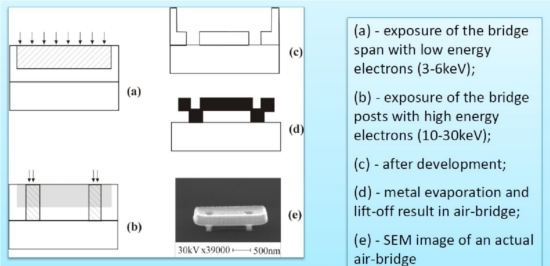
Schematic diagram of one of the method of fabrication of a nano-bridge.
3.) Presentation of a new negative resist HSQ which upon exposure to electron beam turns into SiO2, and so can be employed as gate dielectric.
- • Dr. Vitalii Ivanov - Visit from Dortmund Technical University, Germany
In the framework of task 2.13 of work package "Enhancing of human potential through exchange of know-how and twinning activities with partnering organization" Prof. Dmitri Yakovlev from Dortmund Technical University, Germany visited the Institute between July 7th - 11th, 2014.
During visit to IFPAN, professor Dmitri Yakovlev gave seminar “Second harmonic generation spectroscopy of excitons in semiconductors GaAs, ZnO and CdMnTe”. In his talk an overview on the results of experimental and theoretical study of the three-photon process of optical second-harmonic generation (SHG) involving the exciton resonances in various semiconductors, like GaAs, CdMnTe and ZnO was presented. Strong signals of magnetic-field induced SHG due to orbital and spin quantization are found in GaAs and CdMnTe, respectively. SHG signals at these exciton resonances are induced by the application of a magnetic field when the incident and the SHG light wave vectors are along the crystal z axis where the crystallographic SHG response vanishes. Depending on the particular symmetry of the exciton states SHG can originate from the electric- and magnetic-field-induced perturbations of the excitons due to the Stark effect, the spin as well as orbital Zeeman effects, or the magneto-Stark effect. Prof. Yakovlev discussed with Dr. Ivanov, Prof. G. Karczewski and Prof. J Kossut the possibility of the application of SHG spectroscopy of excitons in nanostructures based of ZnO and CdMnTe.
- • Prof. Dr. hab. Maciej Sawicki - Visit from University of Wuerzburg, Experimentelle Physik III, Wuerzburg, Germany
In the framework of task 2.6 of work package "Enhancing of human potential through exchange of know-how and twinning activities with partnering organization" Dr. Charles Gould from University of Wuerzburg, Germany visited the Institute between June 6th - 14th, 2014.
The aim of the visit was to provide IFPAN community with the most recent advances in the growth, contacting techniques, and electrical measurements of the new spintronics material: MnSi.
During the stay at the Institute Dr. Gould had a number of face to face discussions with Prof. T. Dietl, Prof. M Sawicki and Prof. G. Karczewski during which he presented the recent advances in the MBE growth methods on Si(111) substrates, contacting techniques, and electrical measurements performed at Weurzburg University on the new spintronics material: MnSi. This material has attracted a great attention in the community recently since the observation of the robust formation of skyrmions over a wide temperature-magnetic field region. This new feature of the epitaxial MnSi films is not present in bulk MnSi. Together with the topological Hall effect observed in such layers the observations suggest versatile features of skyrmion-induced topological Hall effect beyond the current understanding. This novel magnetic structure spells a great potential application. It has been found that the skyrmion motion can be driven by a current density about 10000 times weaker than it is required to manipulate with the magnetic domain walls of conventional ferromagnets. This high current-sensitivity may promise the potential application of the skyrmion in the next-generation magnetic recording technique as well as other related spintronic devices. Together with Prof. M. Sawicki there have been performed preliminary SQUID-magnetometry measurements of the samples dr. Gould brought with him. On the account of the obtained results main potential experimental challenges have been identified and it was agreed that they are to be refined later, during Prof. Sawicki visit to Wuerzburg.
Dr. Gould had held also some panel meetings during which he discussed with scientists of the Laboratory of Cryogenic and Spintronic Research recent development and expected directions of activity in spin-polarized current injection to semiconductors.
- • Prof. Dr. hab. Maciej Sawicki - Visit from Institute of Solid State Physics, University of Bremen, Germany
In the framework of task 2.5 of work package "Enhancing of human potential through exchange of know-how and twinning activities with partnering organization" Dr. Gerd Kunert from University of Bremen, Germany visited the Institute between May 12th - 14th, 2014.
The aim of the visit were SQUID-magnetic measurements on ultrathin layers (superlattices) of (Ga,Mn)N grown at the University of Bremen to determine optimal growth conditions in the MBE techniques for maximization of the Curie temperature of (Ga,Mn)N.
The main purpose of the visit of dr. Kunert was to perform SQUID measurements of superlattice samples containing alternating layers of p-type GaN and (Ga,Mn)N. The investigated layers were grown at the MBE facility in Bremen at deliberately varied growth conditions. Indeed, the samples showed sizable variations of the Curie temperature and numerous discussions with the team at IFPAN (Prof. T. Dietl, Prof. M. Sawicki and MSc. S. Stefanowicz) concluded on the directions of further alteration of the growth protocol which should lead to sizable increase of the Curie temperature in (Ga,Mn)N.
Beside these activities Dr. G. Kunert shared his experience on the MBE growth of nanostructures of GaN (self organized growth of nanowires and quantum dots) with the growth team of Prof. Z Żytkiewicz.
- • Dr. Katarzyna Gas - Visit from French Atomic Energy Commission (CEA) – Saclay, France
In the framework of task 2.10 of work package "Enhancing of human potential through exchange of know-how and twinning activities with partnering organization" Dr. Sylvain Petit from CEA Saclay, France, visited the Institute between April 13th - 17th, 2014.
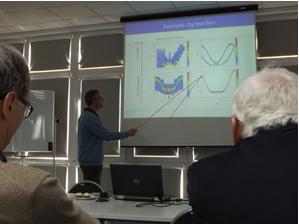 During the visit at IF PAN, Dr. Sylvain Petit held a series of meetings with Prof. W. Szuszkiewicz, Dr. K. Gas, Prof. M. Sawicki, Prof. A. Wiśniewski and Prof. R. Puźniak. Dr. Petit presented recent advances in methods of neutron scattering studies and discussed the relevant details concerning their application for specific materials, especially for the magnetic and spintronics materials.
During the visit at IF PAN, Dr. Sylvain Petit held a series of meetings with Prof. W. Szuszkiewicz, Dr. K. Gas, Prof. M. Sawicki, Prof. A. Wiśniewski and Prof. R. Puźniak. Dr. Petit presented recent advances in methods of neutron scattering studies and discussed the relevant details concerning their application for specific materials, especially for the magnetic and spintronics materials.
On April 15th Dr. Petit gave lecture entitled “Neutron scattering: a tool for studying condensed matter” to the open audience of IF PAN scientist. In this lecture he reviewed the basics of neutron scattering, especially focusing on magnetic diffraction, polarized neutrons, and inelastic scattering. To complement this content, several highlighted examples of nowadays research were presented, especially in the study of thin films. Additionally, on April 15th Dr. Petit gave a seminar talk entitled “Spin dynamics in highly frustrated pyrochlore magnets”.
- • Dr. Ryszard Sobierajski - Task 2.14 - Visit from European X-ray Free-Electron Laser GmbH.
In the framework of the task task 2.14 within the work package "Enhancing of human potential through exchange of know-how and twinning activities with partnering organization" Mr. Tadesse Assefa and Mr. Alexander Britz from European X-ray Free-Electron Laser Facility GmbH visited IP PAS in the period of April 7st - 12th, 2014.
The aim of the visit was to increase the capability of the Institute in the field of time-resolved X-ray spectroscopy. The main part of the visit of Mr Assefa and Mr. Britz was devoted to the discussions with Dr. R. Sobierajski, Dr. M. Klepka and Dr. A. Wolska about possible cooperation. In particular applications of the time-resolved X-ray spectroscopy techniques with the X-ray free electron lasers for studying of the dynamics of the structural changes in samples under optical laser excitations were considered. It is expected to be a very useful tool for studies of the photoinduced processes in biological samples. Both visitors were also participating in the workshop entitled: "New challenges and solutions for XAS data analysis part I – MXAN code for XANES analysis" devoted to the MXAN code which is one of the tools to analyse X-ray absorption spectra. The visitors gave a lecture entitled: "Tracking chemical reactions using combined time-resolved X-ray spectroscopies and scattering". During the lecture time-resolved hard X-ray techniques were introduced as powerful tools for direct probing of structural dynamics in solvated molecular systems. Moreover, the current status of the European XFEL facility and its properties were presented in the context of structural dynamics research. The scientific opportunities at all six experimental instruments were discussed. Special attention was given to the Femtosecond X-ray Experiments (FXE) instrument devoted to pump-probe studies of condensed matter systems. Furthermore, an introduction to static and time-resolved X-ray Absorption Spectroscopy (XAS) was given. As examples, both static and time-resolved XAS spectra measured on different Fe-based transition metal complexes such as [Fe(CN)6]4-, [Fe(terpy)2]2+ and [Fe(dcpp)2]2+ were presented.
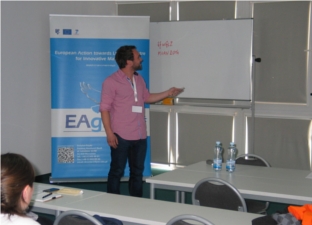
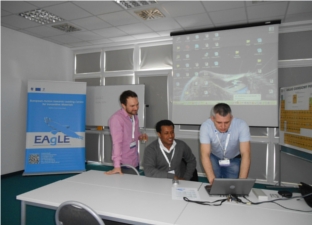
- • Dr. Iraida Demchenko - Visits from ALBA- synchrotron light facility - Cerdanyola del Valles, Spain
In frames of the task 2.4 within the work package "Enhancing of human potential through exchange of know-how and twinning activities with partnering organization" Dr. Marta Avila and Dr. Wojciech Olszewski, research scientists from ALBA synchrotron, visited IF PAN on April 7st - 12th, 2014.
The general aim of their visit was to strengthen the networking and interdisciplinary communication between the ALBA research center, namely CLÆSS (Core Level Absorption & Emission Spectroscopies) beamline, and IF PAN researchers. Additionally, discussions on the analysis procedures on core level spectroscopy data from the experimental point of view were planned.
Working visit started with the meeting with the Task 2.4 leader during which the current plans concerning collaboration in the framework of realization of Task 2.4 were discussed. Special lectures were given by Dr. Olszewski and Dr. Avila on details of present set up and challenges related to the x-ray absorption/emission experiments on CLÆSS beamline at ALBA. Series of discussions were held together with SL 1.2 specialists regarding the possibilities of realization of own XAFS projects. One of the central issue of the discussions concerned the experimental project "XAFS investigations of local structural changes in (Ga,Mn)As thin layers at low temperature postgrowth annealing" accepted for realization in 2014. Main emphasis was focused on the practical aspects of following ‘in situ’ XAFS measurements.
Both visitors participated also in the workshop devoted to MXAN code (primary interest for ALBA and IF PAN scientists who specialized in x-ray spectroscopy).
Reinforcing the research capacity of the IF PAN specialists by their local recruitment and supporting secondments to EU partner synchrotron Lab, ALBA has a significant impact on increasing of IF PAN researchers’ skills in the field of characterization of modern materials using synchrotron techniques, namely, XAFS/XES. Scientific discussions with ALBA leading specialist in x-ray spectroscopies and close collaboration with them contribute highly to the potential increase of research activities at the IF PAN.
- • Prof. Dr. hab. Krystyna Jablonska - visits from Elettra synchrotron, Trieste, Italy
In frames of the task 2.1 of work package "Enhancing of human potential through exchange of know-how and twinning activities with partnering organization" Diane Eichert and Giuliana Aquilanti from EAgLE scientific partner Elettra synchrotrone visited the Institute between April 6st - 12th, 2014.
The aims of the visits were: i) to present on dedicated seminars, the details of construction of the x-ray fluorescence (Diane) and EXAFS (Giuliana) beamlines at the Elettra synchrotron and discuss the evaluable x-ray techniques: ii) to meet with scientists interested in exploiting these beamlines: iii) to participate in the MXAN workshop (task 3.11a) organized in the framework of EAgLE project.
The visits of scientists from Elettra were very fruitful. On 7 of April during the dedicated meeting with scientists from SL-1.2 group they explained the details of X-ray fluorescence and EXAFS beamlines construction. The X-ray fluorescence beamline does not accept proposals yet. However, users with "friendly experiments" are invited to contact Diane. Two visits of researchers from IFPAN have been planned for 2014. EXAFS at Elettra is the Italian beamline dedicated to x-ray absorption spectroscopy. It is installed on a bending magnet source and it was designed to cover a wide energy range: from 2.4 to 27 keV meeting the needs of a large number of researchers in the area of conventional x-ray absorption spectroscopy. The best technical solutions to be applied for low energy synchrotron such like Polish Solaris were of particular interest for scientists from SL1.2 and vitally discussed. During the seminar presented on 8 April beside the technical details of stations construction they provided several examples of experimental results performed at the beamlines. In the following days the workshop devoted to MXAN code application to simulate and fit the experimental NEXAFS data was of primary interest for both the Elettra and IF PAN scientists.
Giuliana Aquilanti and Diane Eichert visits provided added value to all objectives specified for WP2.
1. To exchange know-how and expertise within EAgLE project strategic research directions. - The seminar was given on 8 of April at the seminar room D. The details of construction of the EXAFS and x-ray fluorescence beamlines and the evaluable mode of measurements were shown and discussed with the scientists from IF PAN. It is of particular importance, because the technical project for construction of EXAFS and fluorescence beamlines is currently drafted by x-ray spectroscopy group (SL-1.2). This beamline will be constructed at Polish synchrotron Solaris.
2. To learn new research methods and techniques. – By attending the MXAN workshop together with the scientists from
IF PAN the new method of XAS simulation and model fitting was learned.
3. To establish long term cooperation with partnering organization. – The one week of working together on scientific problems with the researchers from IF PAN created the personal contacts to establish long term cooperation.
4. To increase number of submitted proposals to the Horizon 2020 Programme. – The example of researchers from Elettra participation in EU FP7 projects have been given and possibilities of similar projects to be prepared in Horizon 2020 discussed.
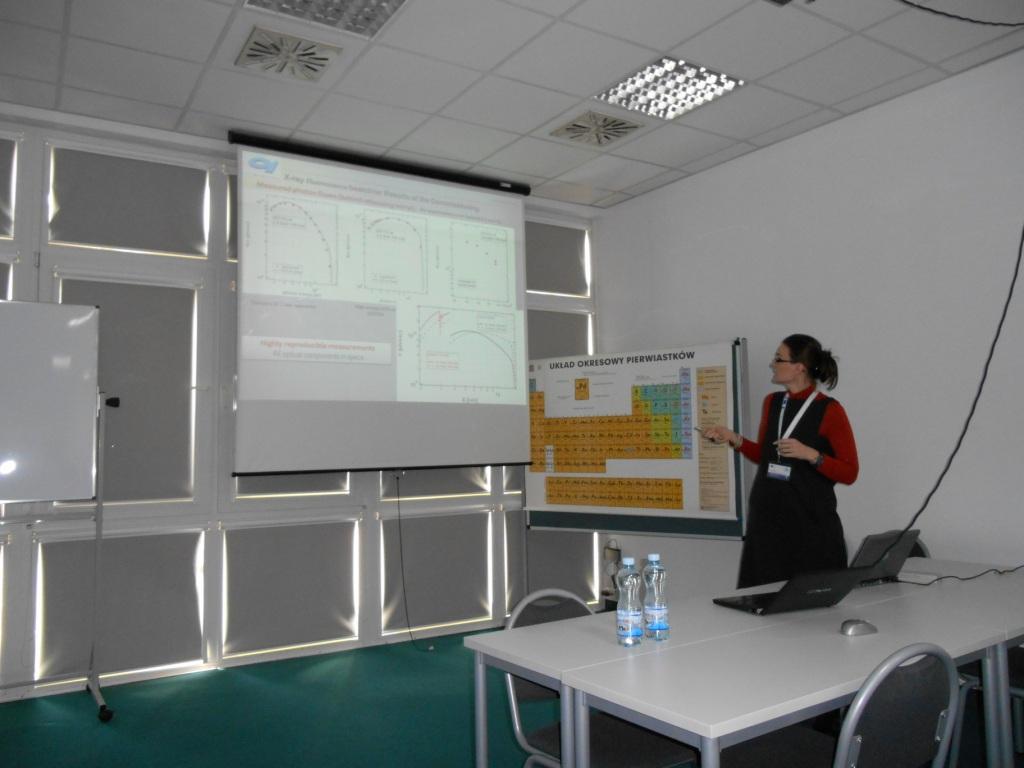
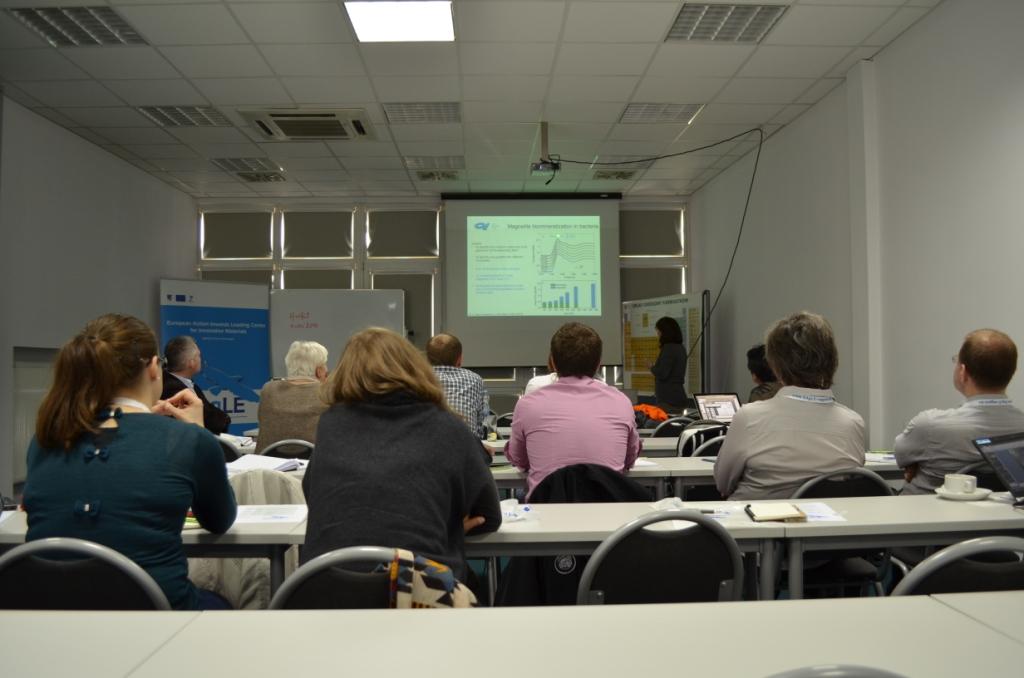
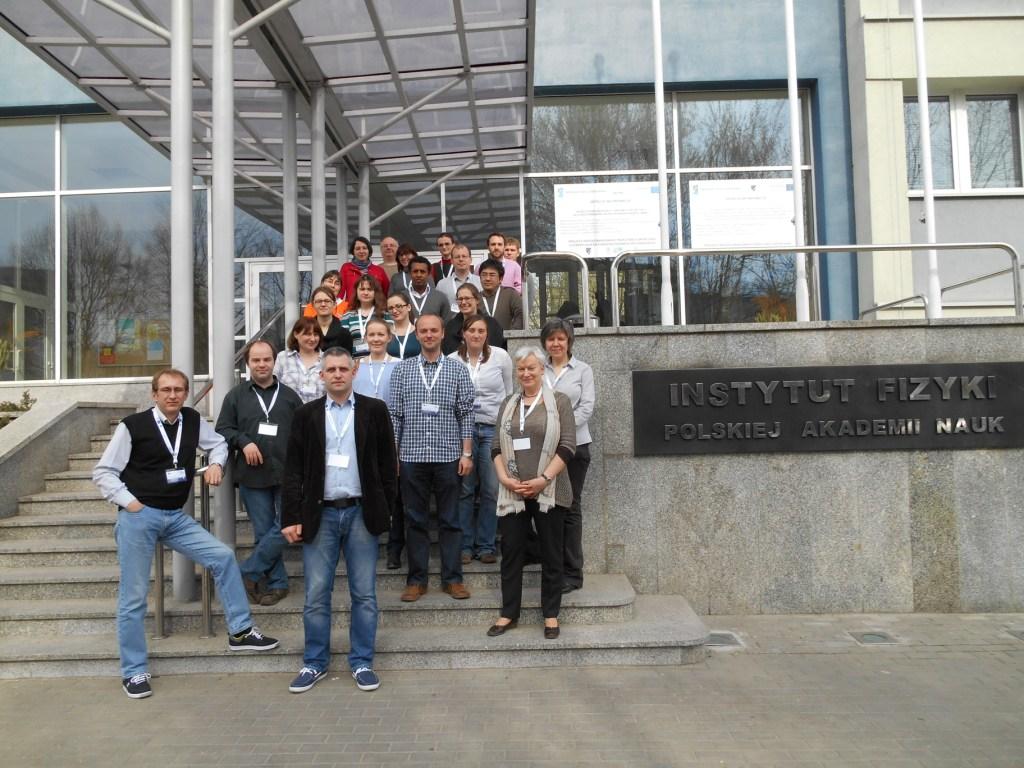
- • Dr. Vitalii Ivanov - Visit from Dortmund Technical University, Germany
In the framework of task 2.13 of work package "Enhancing of human potential through exchange of know-how and twinning activities with partnering organization" Dr. hab. Ilya Akimov from Dortmund Technical University, Germany visited the Institute between March 30th - April 6th, 2014.
Coherent optical phenomena in systems with discrete energy level structure attract a lot of attention for realization of optical quantum memories. One of these phenomena is the photon echo where in the classical picture an intense optical pulse results in rephasing and retrieval of the macroscopic medium’s polarization, which was created by a preceding optical pulse. By the application of a third optical pulse the macroscopic polarization can be retrieved on demand, resulting in a stimulated photon echo.
The concept relies on the photon echo in an electron-trion system in n-type CdTe semiconductor quantum wells subject to transverse magnetic field. The ground (electron) and the excited (trion) states are the doublets characterized by the electron (S=+1/2,-1/2) and hole (J=+3/2,-3/2) spin projections, respectively. The selection rules for optical transitions allow the coupling of the ±1/2 and ±3/2 states, respectively. Optical transitions can be well accessed due to a spectral separation of neutral and charged (trion) exciton resonances. As shown in Fig. 1, three pulses were used for excitation and an additional reference pulse enabled the use of heterodyne detection of the emitted photon echo amplitude.
The first pulse at t=0 induces a coherent superposition of optically accessible electron and trion states (e.g. S=+1/2, J=+3/2, optical coherence). A magnetic field in Voigt-geometry leads to Larmor precession of the electron spin in the ground state. Hence the optical coherence is continuously transferred into a superposition of a pair of states that is optically inaccessible (S=-1/2, J=+3/2 - dark coherence) and back with Larmor precession frequency. As the result the photon echo signal exhibits oscillatory behaviour, which depends sensitively on the polarization configuration of the exciting and refocusing pulses, as described in paper by L. Langer et al., Phys. Rev. Lett. 109, 157403 (2012).
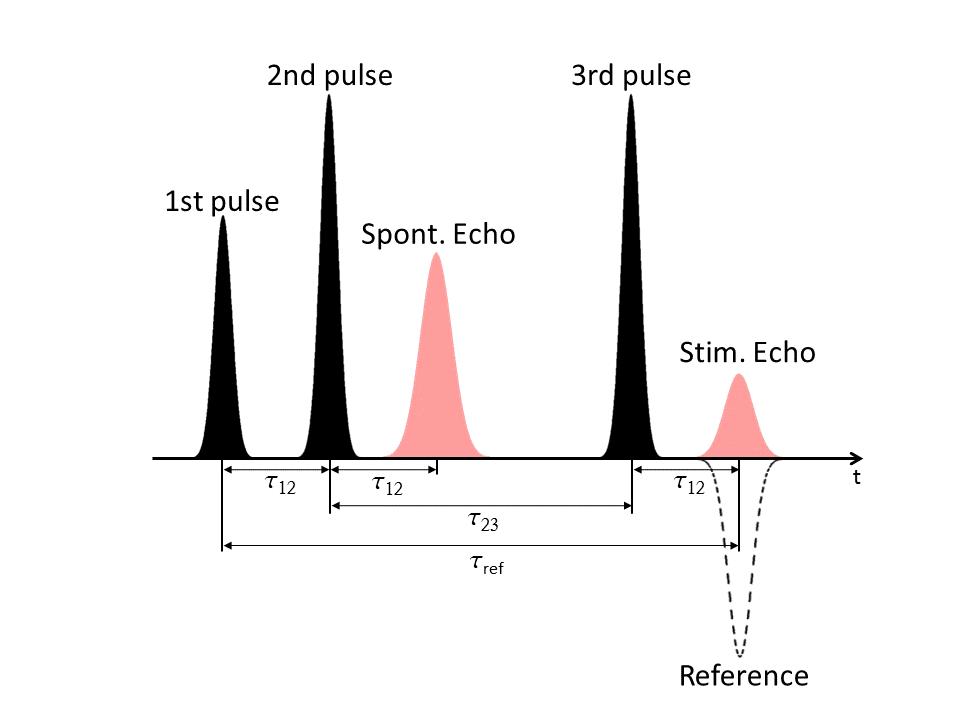
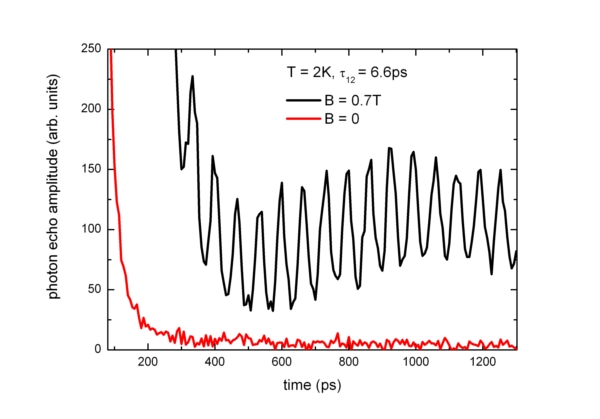
Fig. 1: Scheme of pulses and delay times. Fig. 2: Amplitude of Stimulated Photon Echo.
The second pulse at t = τ12 can also lead to transfer of the optical coherence into a long-lived, dark electron spin coherence. Using a third pulse we can convert it again into an optical coherence appearing at t = 2τ12+τ23 as a stimulated echo. Fig. 2 shows that the application of a transverse magnetic field allows storing optical coherence for a long period of time. The results are explained in terms of the optical Bloch equations accounting for the spin level structure of electrons and trions.
Additionally, during of the visit the lecture titled “Photon echoes from localized trions in transverse magnetic field” was presented by Dr. hab. Ilya Akimov as a regular seminar of Physics and Technology of Wide-band-Gap Semiconductor Nanostructures Division (delivered on April 1st, 2014).
- • Prof. Dr. hab. Maciej Sawicki - Visit from Institute of Solid State Physics, University of Bremen, Germany
In the framework of task 2.6 of work package "Enhancing of human potential through exchange of know-how and twinning activities with partnering organization" Prof. Detlef Hommel from University of Bremen, Germany visited the Institute between March 19th - 21st, 2014.
The aim of the visit was to transfer of knowledge on the growth of nitride semiconducting quantum dots and single photon emitters. Establishing subjects and means for further Bremen – IFPAN collaboration on spintronics.
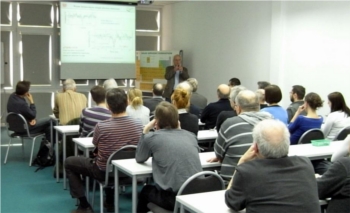 During the stay Prof. Hommel held a series of meetings with Prof. T. Dietl, Prof. Z. Żytkiewicz and Prof. M. Sawicki (including other scientists from their teams) devoted to the selected topics of the molecular beam epitaxy growth of various nitride structures for either spintronics or optoelectronic. He described the current state of the art growth technologies developed by his team in Bremen.
During the stay Prof. Hommel held a series of meetings with Prof. T. Dietl, Prof. Z. Żytkiewicz and Prof. M. Sawicki (including other scientists from their teams) devoted to the selected topics of the molecular beam epitaxy growth of various nitride structures for either spintronics or optoelectronic. He described the current state of the art growth technologies developed by his team in Bremen.
Special attention was paid to the challenges and possible means to mitigate the problem of simultaneous incorporation of manganese and p- or n- type doping to GaN. Mn-doped various GaN-related structures are intensively investigated in the Laboratory of Cryogenic Research and Spintronics in IFPAN since they offer a new paradigm for devices for semiconductor spintronics.
Additionally, a seminar talk entitled „Semiconductor quantum dots and single photon emitters” was given to the open audience of IFPAN scientists.
- • Prof. Tomasz Dietl - Visit from J-K University, Linz, Austria
In the framework of the task 2.8 within the work package "Enhancing of human potential through exchange of know-how and twinning activities with partnering organization" Giulia Capuzzo from Johanes Keppler University, Linz, Austria, visited the Institute between February 3rd - 13th, 2014.
The aim of the visit was to perform SQUID magnetometry of AlGaN:Mn homogeneous and of (Ga,Fe)N phase separated layers.
During the stay at IF PAN epitaxial (Al,Ga)N:Mn homogeneous layers and phase-separated (Ga,Fe)N grown at JKU (Linz, Austria) by metalorganic vapour phase epitaxy (MOVPE) have been measured by SQUID magnetometry at Group of Magnetism of Spintronic Materials with Prof. M. Sawicki and Dr. W. Stefanowicz. The material systems investigated are of crucial importance for a collaborative set of investigations involving several EAgLE partners (IF PAN, JKU, University of Warsaw, ESRF, ELETTRA,…) and concerning the study of novel materials for the next generation of spintronic devices. The experiments carried out at IF PAN in the frame of the visit will be correlated with complementary synchrotron (ESRF), magnetooptical (University of Warsaw) and electron microscopy (JKU and IF PAN) measurements on the same samples.
During the time of the visit at IF PAN regular meetings with the IF PAN partner groups (including Prof. T. Dietl, Prof. M. Sawicki, Dr. I. Kowalik, and Dr. T. Li) have been exploited to refine the plans and strategy for the future exchange visits in the frame of the EAgLE project.
Details on the preparation of the epitaxial samples by MOVPE and on the characterization of the layers by high-resolution X-ray diffraction and synchrotron radiation absorption measurements have been transferred to IF PAN.
- • Prof. Maciej Sawicki - Visit from University of Wurzburg, Germany
In the framework of the task 2.6 within the work package "Enhancing of human potential through exchange of know-how and twinning activities with partnering organization" Prof. Ewelina Hankiewicz from University of Wurzburg, Germany, visited the Institute on January 25th – 30th, 2014.
The aim of the visit was to discuss with to the IF PAN the theoretical aspects of topological insulators and crystalline topological insulators in view of the imagnetoresistance and the fluctuations of resistance in HgTe/HgCdTe quantum.
During the stay at the Institute the role of disorder and defects on transport properties and topological protection in crystalline topological insulators (Pb, Sn)Te was discussed with Prof. Tomasz Story and Dr. Krzysztof Dybko. As the result the theoretical description of the transport tight-binding Hamiltonians for the crystalline topological insulators (Pb,Sn)Te was established in collaboration with Dr. Ryszard Buczko.
The meeting with Prof. Tomasz Dietl allowed discussing experimental transport data on 3D strained gated HgTe. The possible interpretation within Dirac states was established.
Additionally, a seminar talk entitled „Transport and unconventional superconductivity in topological insulators” was given to the open audience of IF PAN scientists. In this talk, combined theoretical and experimental approach to establish spin polarization of the edge channels of 2D topological insulators as well as transition between topological insulator and quantum Hall effect was presented. Further, it was showen that the helicity of edge states lead to new phenomena when superconducting (SC) proximity gap is induced in topological insulators.
- • Dr. V. Ivanov - Visit from TU Dortmund University, Germany
In the framework of task 2.13 of work package "Enhancing of human potential through exchange of know-how and twinning activities with partnering organization" Dr. Debus Joerg from TU Dortmund University, Germany visited the Institute between January 19th - February 28th, 2014.
The main aim of the visit of Dr. Debus was the transfer to IF PAN community a new experimental algorithm for the detection of magnetic resonances by optical Faraday rotation. The goal was supposed to achieve through advanced investigations of magneto-optical properties of the negatively charged nitrogen vacancy center in diamond by using the technique of optically detected magnetic resonance.
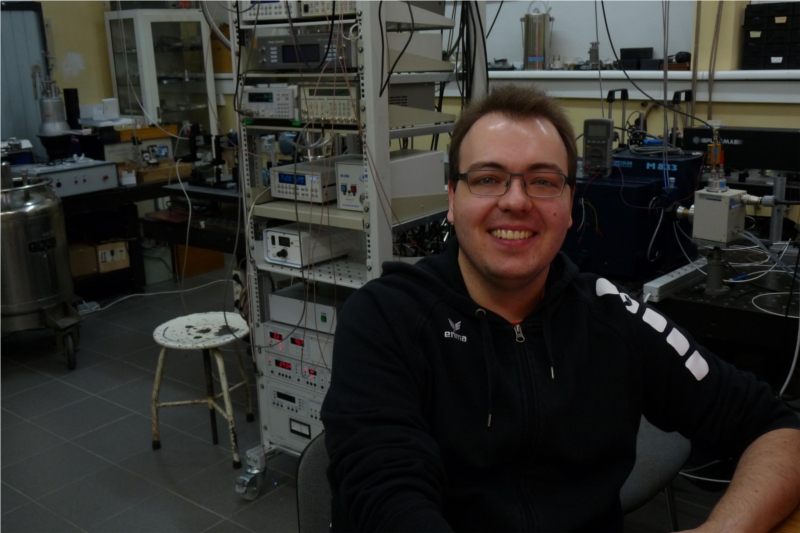 The research plan of the visit was focused on advanced investigations of magneto-optical properties of the negatively charged nitrogen vacancy (NV-) center in diamond by using the technique of optically detected magnetic resonance (ODMR). The IF PAN research group headed by Prof. Marek Godlewski disposes one of the most advanced ODMR spectrometer in Europe operating at the 60 GHz microwave band, which provides possibilities of comprehensive studies on the energetic level-structure and spin dynamic processes of the NV- center. The negatively charged nitrogen vacancy center in diamond offers unique temperature-robust optical properties like very long spin coherence times of several seconds, even at room temperature. Since the energy of the zero-phonon line lies in the visible spectral range, the optical properties of the NV- centers are moreover easily addressable by spectroscopic techniques. During his research visit, specific magneto-optical effects of the NV- center in diamond were investigated.
The research plan of the visit was focused on advanced investigations of magneto-optical properties of the negatively charged nitrogen vacancy (NV-) center in diamond by using the technique of optically detected magnetic resonance (ODMR). The IF PAN research group headed by Prof. Marek Godlewski disposes one of the most advanced ODMR spectrometer in Europe operating at the 60 GHz microwave band, which provides possibilities of comprehensive studies on the energetic level-structure and spin dynamic processes of the NV- center. The negatively charged nitrogen vacancy center in diamond offers unique temperature-robust optical properties like very long spin coherence times of several seconds, even at room temperature. Since the energy of the zero-phonon line lies in the visible spectral range, the optical properties of the NV- centers are moreover easily addressable by spectroscopic techniques. During his research visit, specific magneto-optical effects of the NV- center in diamond were investigated.
The use of high-frequency microwave radiation (60 GHz) provides, on the one hand, the characterization of the spin-level structure including relaxation times. On the other hand, it enables one to obtain optical responses on microwaves with extreme low power in the nanowatt-range. Dr. J. Debus has probed spin transitions of the NV- center in diamond by means of his implemented experimental algorithm: due to the illumination with resonant microwaves the photoluminescence intensity changes as the spin population moves to or from optically active spin levels. In that respect, it is highly remarkable that a pronounced ODMR signal at room temperature for an output power of microwaves of 25 nW could have been detected! This experimental observation clearly demonstrates that the NV- center can be used as a nanowatt-microwave detector, thus opening various possibilities for applications and devices.
- • Dr. Ryszard Sobierajski - Task 2.14 European XFEL - visit of Dr. Andrew Aquila, research scientist for coherent X-ray imaging
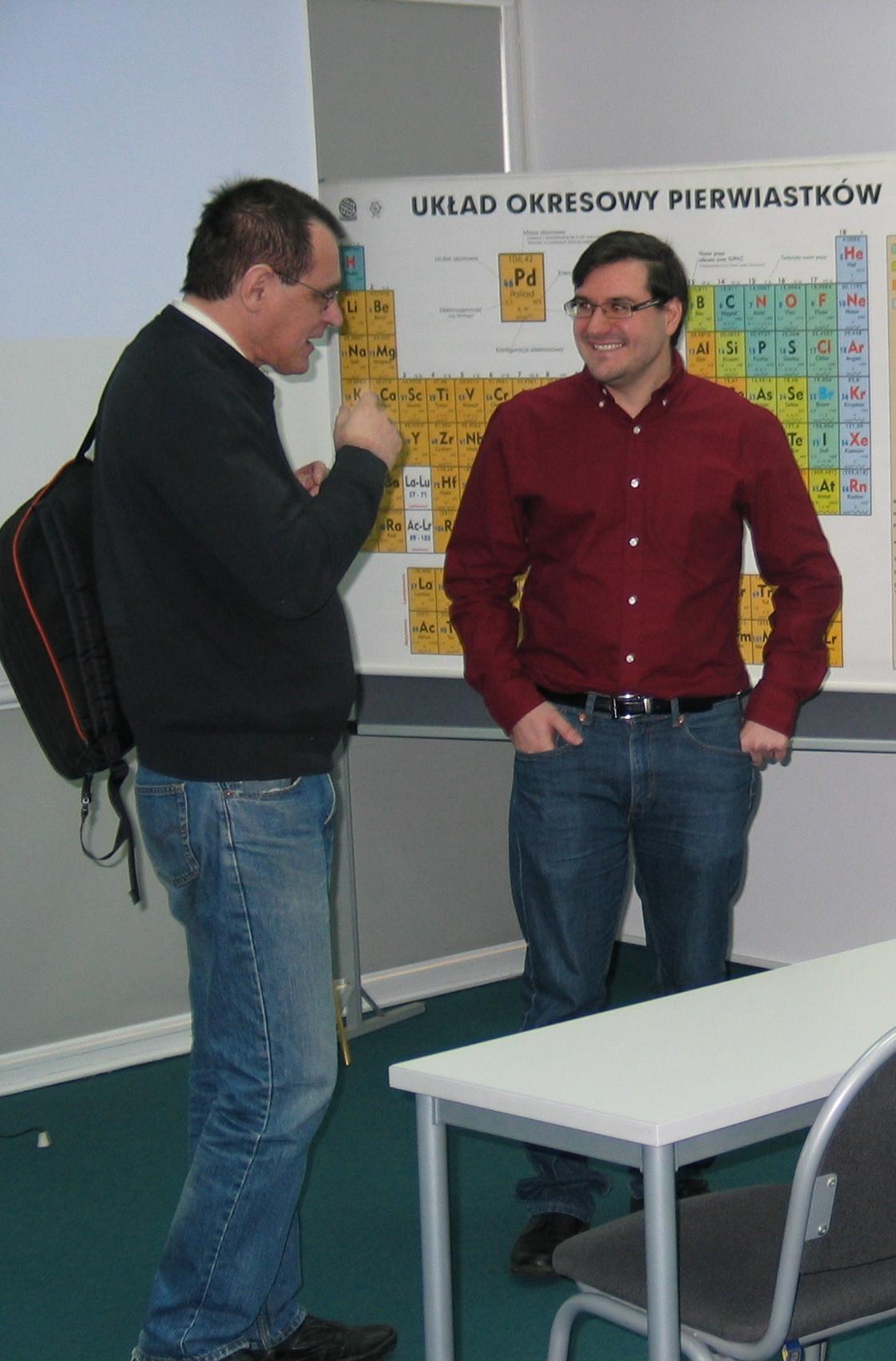 In the framework of the task 2.14 within the work package "Enhancing of human potential through exchange of know-how and twinning activities with partnering organization" Dr. Andrew Aquila, research scientist for coherent X-ray imaging at European XFEL, visited IF PAN on January 19th ‑ 21st, 2014.
In the framework of the task 2.14 within the work package "Enhancing of human potential through exchange of know-how and twinning activities with partnering organization" Dr. Andrew Aquila, research scientist for coherent X-ray imaging at European XFEL, visited IF PAN on January 19th ‑ 21st, 2014.
The main goal of the visit was a tutorial course on the application of the PENELOPE software used for simulation of the ballistic electron transport in solids. Dr. Andrew Aquila presented how to apply the PENELOPE code to the case of the electronic transport process in solids irradiated with intense femtosecond X-ray pulses. The physical meaning of the input parameters, effective running of the code and the analysis of the output data were discussed. First simulations for the case of the crystalline silicon and silica thin layer at the silicon substrate were performed. The influence of the ballistic electron energy transport on the reduction of the melting threshold was discussed and compared with experimental results. Moreover Dr. Andrew Aquila gave a talk during the regular seminar of the Laboratory of X-Ray and Electron Microscopy Research on the “Bio-imaging at the European XFEL” (see pictures below and transparencies). During his talk he discussed advances in biophysical X-ray imaging with emphasis on the latest developments and instrumentation for the European XFEL, specifically focusing on the Single Particles, Clusters and Biomolecules (SPB) instrument. Instrument development including the optical layout, key diagnostics, sample environment and detection systems were described. Experimental techniques include various forms of coherent diffractive imaging and crystallographic analysis applied to collections of many thousands of nano-crystals were also presented. Participants get familiarized with the scientific research performed by the SPB (Single Particles, Clusters and Biomolecules) group at the Eu-XFEL. This can be a base to establish a further collaboration in the topic of the biophysical X-ray imaging.
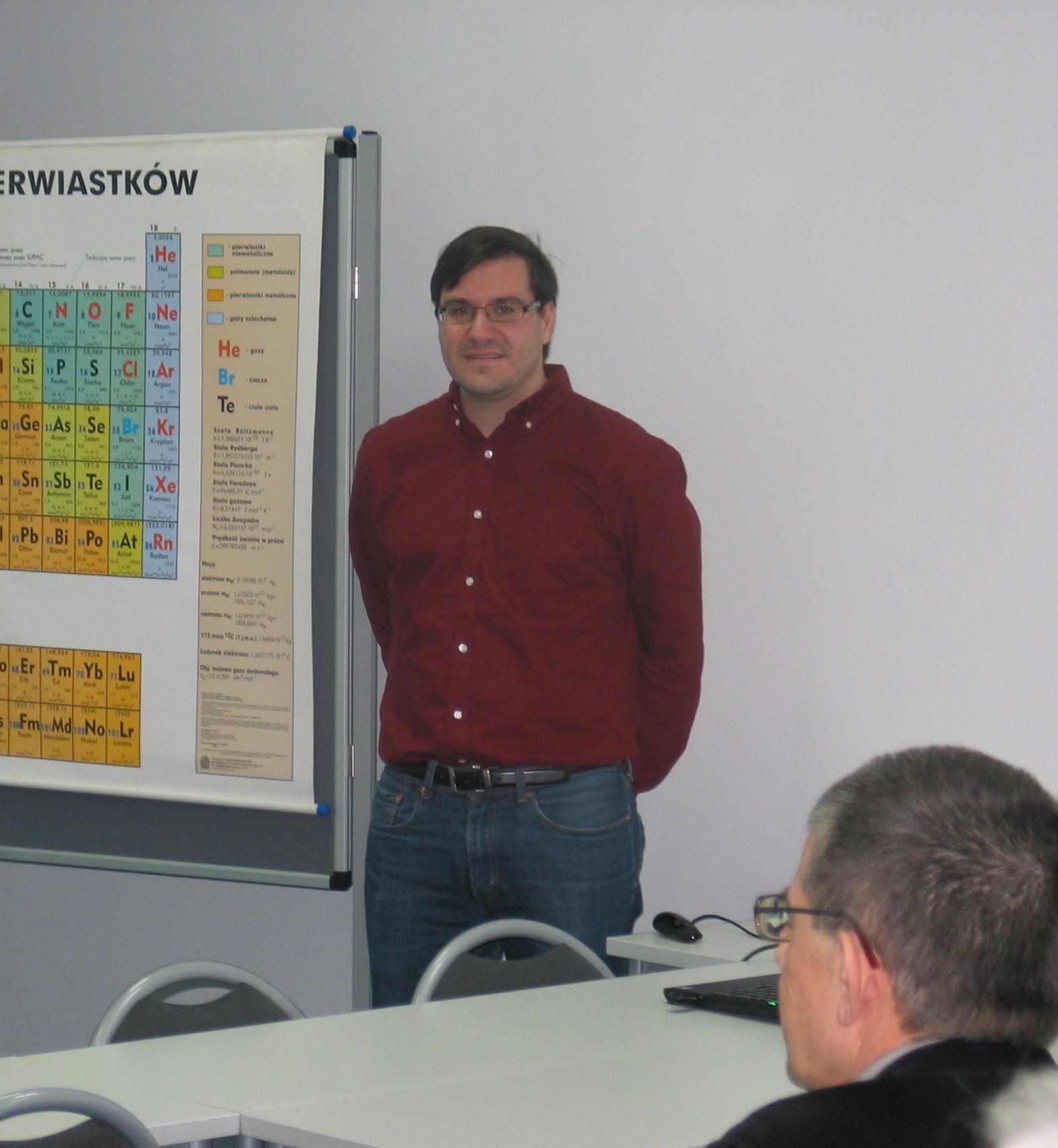
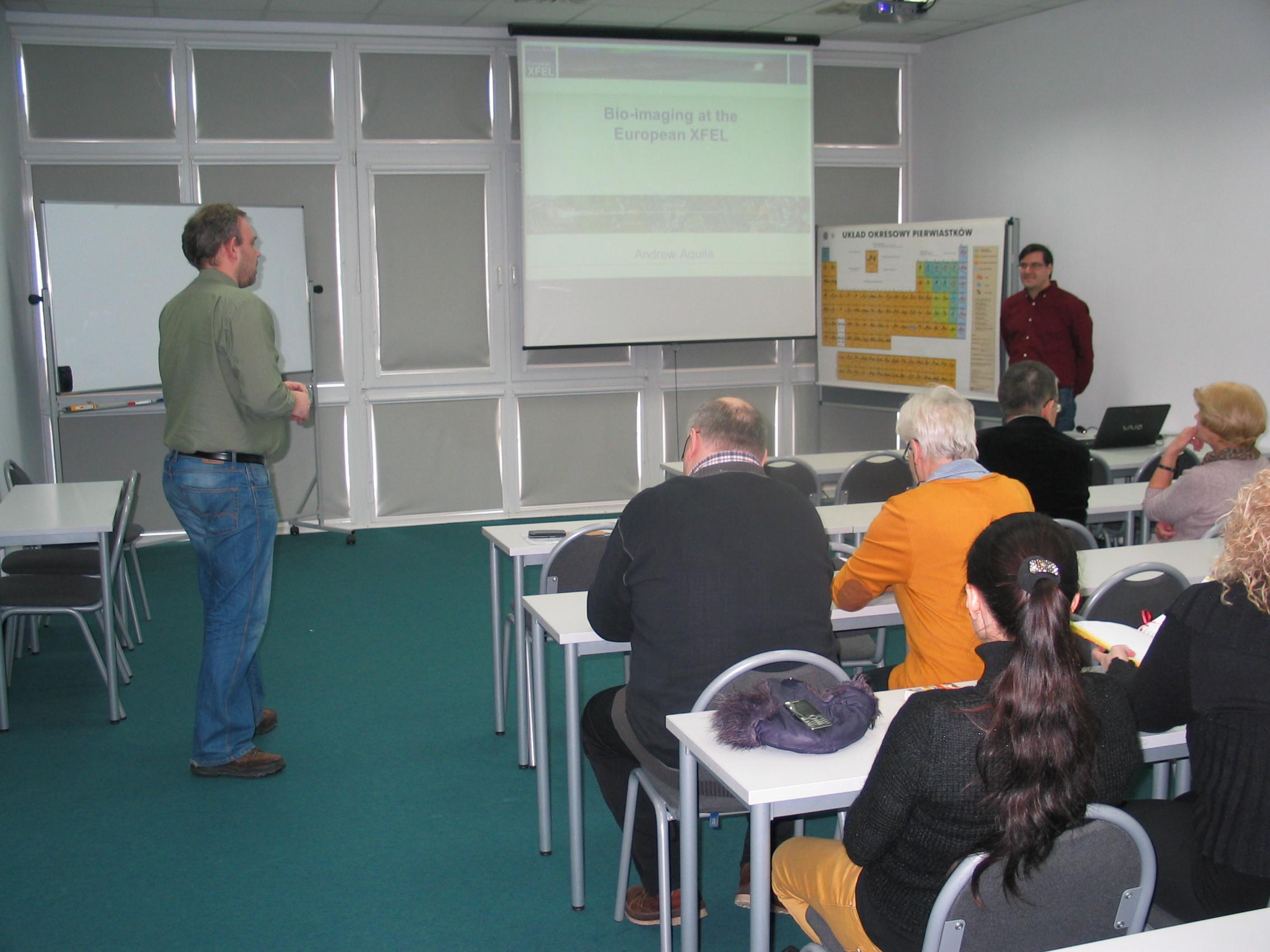
- • Dr. Anna Wolska - Task 2.2: European Synchrotron Radiation Facility
In the framework of task 2.2 of work package "Enhancing of human potential through exchange of know-how and twinning activities with partnering organization" Dr. Francesco d'Acapito from European Synchrotron Radiation Facility visited the Institute on January14th - 17th, 2014.
During the visit Dr. d'Acapito gave a seminar entitled: "X-ray Absorption Spectroscopy studies at the GILDA beamline (ESRF): the role of ab-initio structural modelling in data analysis". He presented technical information about the beamline and showed what kind of experiments could be performed there. Second part of the seminar was devoted to the XAS data analysis. Dr. d'Acapito demonstrated the role of structural modelling in the analysis and presented the examples. The seminar was opened to everybody interested.
Another part of the visit was devoted to the discussions about possible cooperation in the field of X-ray absorption spectroscopy investigations on different types of materials produced in the Institute of Physics, especially in the field of metal-organic complexes.
- • Prof. Maciej Sawicki - Visit from The University of Nottingham, UK
In the framework of task 2.11 of work package "Enhancing of human potential through exchange of know-how and twinning activities with partnering organization" Dr. Peter Wadley from The University of Nottingham, UK visited the Institute between January 6th - 10th, 2014.
The central aim of the visit of Dr. Wadley to IF PAN was to discuss theoretical and experimental issues concerning resent X-ray magnetic circular dichroism measurements made at the K-edge of Mn, Ga and As in the dilute magnetic semiconductor (Ga,Mn)As and to advance preparation for forthcoming collaboration on antiferromagnetic spintronics.
Dr. Peter Wadley gave a seminar presentation in which he presented results of X-ray magnetic circular dichroism measurements made at the K- edge of Mn, Ga and As in the dilute magnetic semiconductor (Ga,Mn)As. The measurements are complimentary to the recent theoretical results elaborated in IF PAN by Dr. Cesary Śliwa and Prof. Tomasz Dietl and the ways of improving the theoretical approach to the calculation of the orbital moment, with particular attention to the signs of the orbital moment given by the XMCD sum rules, were discussed.
Further discussions were initiated with other researchers who have expert knowledge in the modelling and derivation of the XMCD sum rules (Gerrit van der Laan, Diamond) who can hopefully help in more useful comparison of the experimental established orbital moments to the model values.
In additional talks with Prof. M. Sawicki revealed an avenue for collaboration on the new antiferromagnetic materials grown at Nottingham was identified. They could be jointly investigated at IF PAN using SQUID magnetometers, after some important technical issues are resolved. This could initiate an ongoing collaboration between IF PAN and Nottingham on the characterisation of new materials for antiferromagnetic spintronics.
- • Dr. Iraida Demchenko - TASK 2.4: ALBA- synchrotron light facility - Cerdanyola del Valles, Spain
In the framework of task 2.4 of work package "Enhancing of human potential through exchange of know-how and twinning activities with partnering organization" Prof. M. Aranda, scientific director of ALBA synchrotron, visited IF PAN on 11th - 13th December, 2013.
Prof. Aranda working visit started from the meeting with the manager of EAgLE project Prof. Jabłońska and task 2.4 leader Dr. Demchenko where selected current plans concerning collaboration in the framework of realization of Work Package 2 were discussed. This visit, following interests of our scientific partners, involved a series of meetings with leading specialists of IF PAN in the area of wide class materials growth and characterization, namely, Prof. Zytkiewicz, Prof. Guziewicz, Prof. Baczewski, and Prof. Kossut. A special lecture was given by Prof. M. Aranda about possibilities of new European ALBA synchrotron with emphasis on particular details on each operating beamline allowing for conducting unique experiments in the area of XRD, XAFS including XMCD, XPS and other experimental techniques being of interest for IF PAN workers. Obtained information was discussed with SL 1 specialists and guests of seminar. Additionally, scientific plans and collaboration between our centres were discussed during meeting with scientific director of IF PAN Prof. Kozaniecki. Finally, Prof. Aranda was introduced to the general director of IF PAN and coordinator of EAgLE project Prof. Sirko. During this meeting the schedule of exchange visits was confirmed and work visit of Prof. Sirko to ALBA was prospected on 2015.
- • Prof. Maciej Sawicki - Visit from University of Wurzburg, Germany
In the framework of task 2.6 of work package "Enhancing of human potential through exchange of know-how and twinning activities with partnering organization" Stefan Graue from University of Wurzburg, Germany, visited the Institute between 2nd – 13th December, 2013.
 During his stay at the Institute of Physics a set of electrical and magnetic measurements was conducted aiming to determine basic transport and magnetic properties of several BiCrTe layers.
During his stay at the Institute of Physics a set of electrical and magnetic measurements was conducted aiming to determine basic transport and magnetic properties of several BiCrTe layers.
This material is a magnetic derivative of so called topological insulators in which special kind of surface states is expected to exhibit various unique quantum phenomena which may bring revolutionary developments in low power electronics and topological quantum computation. A large portion of the quantum phenomena is expected from breaking of the time reversal symmetry of the topological insulators, and an introducing ferromagnetism is one of them.
The BiCrTe samples were grown by Stefan Grauer at University of Wurzburg by molecular beam epitaxy. He is now one of the leaders in the growth of this particular material. It is the first time that samples of magnetic topological insulators were introduced to the scientific community of the Institute of Physics.
For electrical transport measurements he showed how to deal with the samples and how to deposit ohmic electrical contacts. Longitudinal and transverse magnetoresistance were investigated at cryogenic temperatures in magnetic field up to several Tesla. These results were then compared with results of magnetic investigation in SQUID magnetometer. In order to obtain credible results various experimental configurations were tested, including the selection of most suitable sample holders, type of measurements (at constant temperature with changing magnetic field of in constant field as a function of temperature) and probing different experimental procedures. Also, a great deal of attention was devoted for elaborating the influence of the sample shape on the final results. All together 8 samples were probed at relevant experimental conditions and for all of them their true magnetic constituency and the real Cr concentration were established. This knowledge in turn will be used as the necessary information (feedback) to adjust the growth conditions helping to aid the growth process of this challenging material.
- • Prof. Lech T. Baczewski - Visit from NCSR Demokritos, Athens, Greece
In the framework of task 2.7 of work package "Enhancing of human potential through exchange of know-how and twinning activities with partnering organization" Efthymia Ofelia Tsompopoulou from NCSR Demokritos, Athens, Greece, visited the Institute between 2nd – 7th December, 2013.
The aim of the visit was to gain knowledge about the applicability of the ion and neutron irradiation, neutron diffraction and polarised neutron reflectivity PNR as methods of structural and magnetic characterisation for metallic nanostructures grown by MBE method. The scientists from the group headed by Dr. Konstantina Mergia, of which the visiting scientist is a member, are experienced specialists in the field. Another goal of this visit was to explore possibility of scientific collaboration and common research in view of the complementary specialisation of the two labs.
The Fusion Technology Group of the Institute of Nuclear and Radiological Science, Energy, Technology and Safety of NCSR Demokritos in Athens, Greece, of which Ms Efthymia Ofelia Tsompopoulou is a member, has large experience in ion and neutron irradiation effects on materials relevant to fusion energy applications. They are also specialists of neutron diffraction and reflectivity. The visit of Ms Tsompopoulou has given the opportunity to discuss various aspects of irradiation effects on magnetic materials and how one can tune magnetic properties using ion irradiation and implantation effects.
She is working on Fe ions irradiation effects on magnetic properties of Fe thin films deposited on Si substrates. She has given a detailed overview of the method using beam line in a reactor using ion beam of different energies and simulation methods of the penetration depths depending on film thickness and beam energy. Presentation about the principles of above mentioned methods and their advantages in structural and magnetic studies of thin films structures was given for the laboratory members. During discussions the possibility of scientific collaboration and common research was explored taking into account complementary specialisations of the two labs i.e. ion irradiation and neutron methods from the Greek side and nanotechnology from Polish side.
Ms Tsompopoulou has also visited the nanotechnology lab and different aspects of metallic thin films and nanostructures growth by MBE method were discussed. In-situ characterisation techniques available in the system were presented as well.
The ability of beam-time application forms preparation was also discussed as it is a very important issue increasing the success rate when applying for large facilities experiments where for both ion beam irradiation and neutron methods reactor lines are necessary.
- • prof. Grzegorz Karczewski - Visit from University of Wurzburg, Germany
In the framework of task 2.6 of work package "Enhancing of human potential through exchange of know-how and twinning activities with partnering organization" Steffen Schreyeck from University of Wurzburg, Germany, visited the Institute between November 25th – December 5th, 2013.
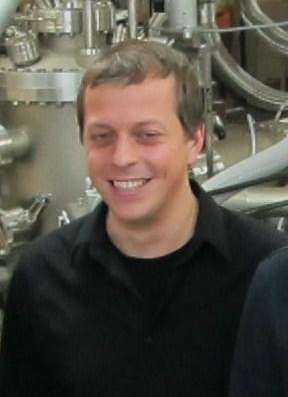 The aim of the visit was to provide to the IF PAN scientist the expertise in the growth of topological insutators of type Bi2Se3. Steffen Schreyck is a specialist in MBE growth of this kind of materials with exceptional quality.
The aim of the visit was to provide to the IF PAN scientist the expertise in the growth of topological insutators of type Bi2Se3. Steffen Schreyck is a specialist in MBE growth of this kind of materials with exceptional quality.
During the stay at the Institute Steffen Schreyeck together with Prof. G. Grabecki initiated quantum transport measurements on Bi2Se3 samples grown in Wurzburg. They established suitable experimental routines (samples preparation, contacting, handling) suitable for measurement of transport properties of the one of the thinnest Bi2Se3 films which consisted just of 4 quintuple layers.
He also gave a joint seminar lecture (with Rebbeka Pfferfer) as a part of the Institute series of Condensed Matter Physics Seminars for the broad Institute audience about his specifics of the growth and last results obtained for Bi2Se3.
The information provided by Steffen Schreyeck on growth of Bi-based topological insulators are of great importance for the entire IF PAN community, as it will allow the local community to initiate the growth of these highly timed but challenging materials. Also, the elaborated measurement routine will enable future activity in IF PAN on this subject.
- • prof. Grzegorz Karczewski - Visit from University of Wurzburg, Germany
In the framework of task 2.6 of work package "Enhancing of human potential through exchange of know-how and twinning activities with partnering organization" Rebekka Pfeuffer from University of Wurzburg, Germany, visited the Institute between November 25th – December 5th, 2013.
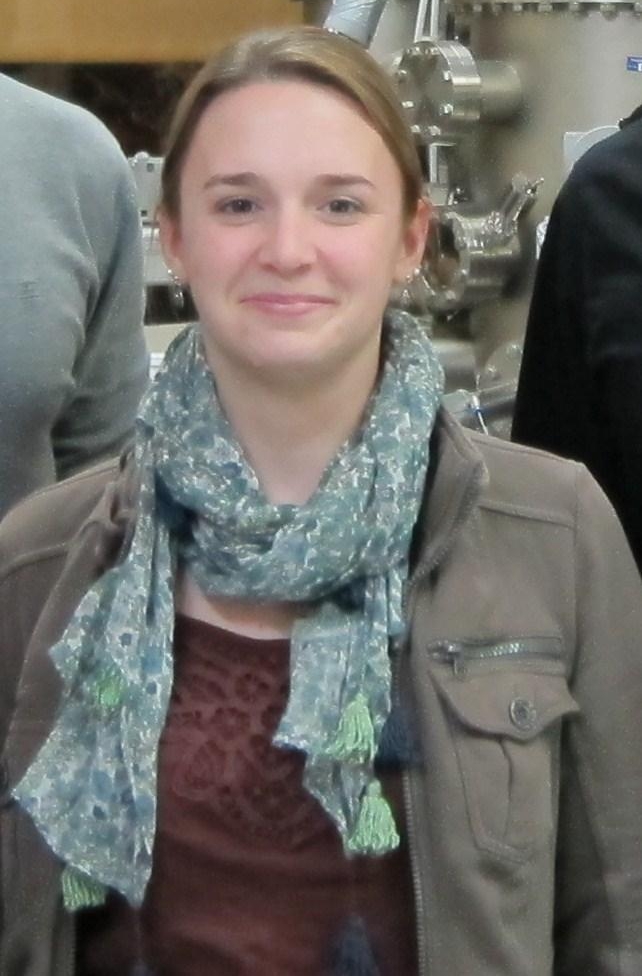 The aim of the visit was to transfer to IF PAN the experience in growth of one-dimensional semiconductors structures of ZnSe by molecular beam epitaxy from Au/Ga nanoseeds.
The aim of the visit was to transfer to IF PAN the experience in growth of one-dimensional semiconductors structures of ZnSe by molecular beam epitaxy from Au/Ga nanoseeds.
During the stay at the Institute Rebakka Pfeuffer presented her experience in growth and investigation of ZnSe nanowiskers. These 1D nanostructures were grown from Au/Ga nanoseeds in molecular beam epitaxy set-up at the University of Wurzburg. In particular, she presented methods leading to the growth of relatively thick ZnSe whiskers (over 40 nm) with good optical parameters. In addition she showed methods elaborated in Wurzburg for electrical contacting of such objects. The proper contacting is of crucial importance. She performed microluminecsence measurements of ZnSe nanowires containing CdSe quantum dots together with Dr. Kłopotowski and cathodoluminescence measurements together with W. Zaleszczyk.
Rebbeka Pfferfer gave a joint seminar lecture (with Steffen Schreyck) as a part of the Institute series of Condensed Matter Physics Seminars for the broad Institute audience about her last results.
- • Prof. Maciej Sawicki - Visit from University of Wurzburg, Germany
In the framework of task 2.6 of work package "Enhancing of human potential through exchange of know-how and twinning activities with partnering organization" Philip Leubner from University of Wurzburg, Germany, visited the Institute on November 25th – December 5th, 2013.
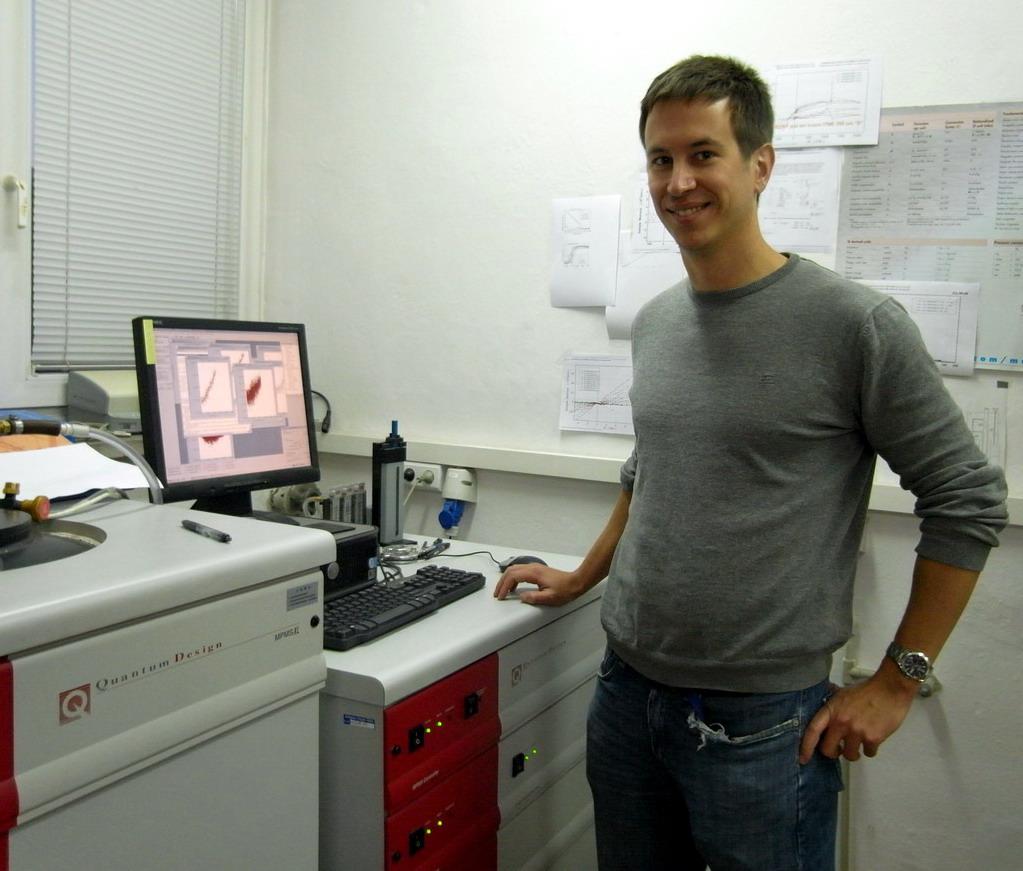 The aim of the visit was to provide to the IF PAN scientist the expertise in the growth of enriched in Mn ultrathin epitaxial layers of HgTe.
The aim of the visit was to provide to the IF PAN scientist the expertise in the growth of enriched in Mn ultrathin epitaxial layers of HgTe.
During his stay at the Institute of Physics extensive magnetometry utilising sensitive SQUID magnetometry were performed together with Prof. Maciej Sawicki. Various experimental configurations were tested, including the selection of most suitable sample holders, type of measurements (at constant temperature with changing magnetic field of in constant field as a function of temperature) and probing different experimental procedures. Also, a great deal of attention was devoted for elaborating the influence of the sample shape on the final results. All together 4 samples were tested at wide experimental conditions and finally, for all of them, relevant experimental conditions were elaborated enabling to establish the real Mn concentration in the studied layers. This in turn will serve as the necessary information (feedback) to adjust and rescale growth conditions to increase the throughput of the MBE grown layers with the desired growth conditions.
- • Prof. Maciej Sawicki - Visit from University of Bremen, Germany
In the framework of task 2.5 of work package "Enhancing of human potential through exchange of know-how and twinning activities with partnering organization" Dr. Gerd Kunert from University of Bremen, Germany, visited the Institute between November 5th - 15th, 2013.
The aim of the visit was to advance IF PAN experimental capability in magnetic studies of ultrathin layers of (Ga,Mn)N and (Ga,Mn)N/GaN:Mg superlattices grown by MBE method on sapphire substrates.
Dr. Kunert is a key expert in molecular beam epitaxy (MBE) growth of nitride compounds and has recently become the world class specialist in growth of GaN containing Mn. (Ga,Mn)N is the new member of the family of diluted magnetic semiconductors, the most promising material candidate for semiconductor spintronics, currently regarded as the second compound to (Ga,Mn)As.
During his visit he took part in intensive magnetometry measurements of ultrathin layers of (Ga,Mn)N grown by himself in MBE chamber in University of Bremen. As this layers are grown on thick sapphire substrates, which is mechanically too hard to be removed for the studies, he spent his time on performing test SQUID magnetometry measurements aiming to developed ways and protocols to correctly remove the contribution of the sapphire substrate from the total signal of the sample. The investigated specimens were either single nanometers thin layers of (Ga,Mn)N containing 1-3% of Mn or superlattices (Ga,Mn)N/GaN:Mg consisting of similarly thin (Ga,Mn)N layers. Both weak field and high magnetic field (for determination of the effective Mn content in the structures) were performed.
Dr. Kunert visited also the Group of MBE Growth of Nitride Nanostructures headed by Prof. Z. Żytkiewicz with whom he shared his experience on growth of GaN-based nanostructures. During this meeting a schedule for future collaborative (twinning) visits in this subjects was laid.
- • prof. Tomasz Dietl - Visit from J-K University, Linz, Austria
In the framework of task 2.8 of work package "Enhancing of human potential through exchange of know-how and twinning activities with partnering organization" Dr. Rajdeep Adhikari from Johanes Keppler University, Linz, Austria, visited the Institute between November 4th - 23th, 2013.
 The aim of the visit was to develop experimental methods suitable for millikelvin magnetotransport measurements of n-type GaN:Si samples.
The aim of the visit was to develop experimental methods suitable for millikelvin magnetotransport measurements of n-type GaN:Si samples.
During the stay Dr. R. Adhikari together with V. Stsefanovich with help of Dr. P. Kaczor and prof. M. Sawicki put electrical contacts, prepared and performed a series of magnetotransport measurements of n-type GaN:Si layer at millikelvin temperatures. Collected data will allow to estimate the value of spin-orbit coupling constant, λSO, as well as characteristic time constants e.g. classical momentum relaxation time or phase coherence time.
Dr R. Adhikari shared his experience in samples growth, making structures for magnetotransport measurements, placing ohmic contacts on GaN, and numerical analysis of magnetortransport measurements.
Visit of Dr. Rajdeep Adhikari increased the know-how of IF PAN scientist on contacting methods of n-type thin layers of GaN:Si and on the necessary conditions for performing subkelvin magnetotransport measurement of these layers. The obtained results will constitute the base of a scientific publication.
- • Dr. hab. Sławomir Kret - Visit from University of Warwick, United Kingdom
In the framework of the task task 2.3 within the work package "Enhancing of human potential through exchange of know-how and twinning activities with partnering organization" Dr. Ana Sanchez from Department of Physics, University of Warwick, United Kingdom visited the Institute on November 3th - 8th, 2013.
During visit, Dr. Ana Sanchez gave lecture 45 minutes on “A novel approach to high contrast electron microscopy of macromolecular block copolymer assemblies at sub-nanometricscale“ in the frame of series of X-ray Seminars of IF PAN. She visited the Electron Microscopy facilities of IF PAN (FEI-Titan, Helios Nanolab, sample preparation laboratory). She discussed about implementation of twinning at university of Warwick with Prof. Dr. hab. Krystyna Jabłońska – EAgLE Project Manager. Together with Dr. Piotr Dłuzewski she discussed about perspective of common development of digital electron diffraction experimental methodology and their theoretical background. Dr. Ana Sanchez together with Dr. Sławomir Kret tested the procedure of the alignment of the EELS Quantum spectrometer (which are common for both labs) to obtain the best energy resolution and less noisochromaticy in EFTEM mode.
Dr. Ana Sanchez shared also knowledge of the method of the investigation of the low contrast object like polymers and carbon nano-pipes using the graphen oxide support and electron exit wave reconstruction method.
|
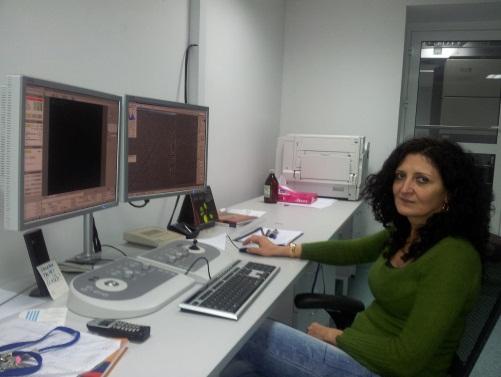
Dr. Ana Sanchez during EELS test on FEI Titan microscope at IF PAN |
- • Dr. Iwona Kowalik - Visit from Uppsala University, Sweden
In the framework of task 2.15 of work package "Enhancing of human potential through exchange of know-how and twinning activities with partnering organization" Dr. Dimitri Arvanitis from Uppsala University, Uppsala, Sweden, visited the Institute between November 2nd - 6th, 2013.
The goal of the visit of Dr. Dimitri Arvanitis was to enhance the experimental potential of the IF PAN by the development of the quantitative analysis of core level spectra and to strengthen the ties with Uppsala University, which is an acknowledged source of expertise in this field. Additionally, discussions on the analysis procedures on core level spectroscopy data from both the experimental and theoretical point of view were planned.
A special seminar lecture was given on magnetic measurements and challenges related to the specific core level spectroscopies. Discussions took place on the possibilities of X-ray related data acquisition and analysis in Uppsala and Lund (MAX IV lab). In several discussions and an informal seminar, D. Arvanitis highlighted the possibilities offered by the VERITAS beam line at MAX IV and the HELIOS XUV source in Uppsala. Special requirements were discussed for the samples suitable for HELIOS work as well as needed hardware for semiconductor physics at the VERITAS beam line from 2016 onwards.
The quantitative X-ray absorption data analysis procedures of photo absorption spectra at the O K edge of doped ZnO using a theoretical platform (FEFF) in collaboration with UU were also discussed. This effort laid the foundations for better designing of future experiments enabling the extraction of "ground state" information from the experimental spectra.
The visit vastly increased research potential of IF PAN in the area of the interpretation and quantitative analysis of oxygen K-edge spectra. Details of the FEFF ab initio code cards were elaborated enabling now to calculate XAS and XMCD spectra of doped ZnO at K edges. In-depth detailed information was acquired about magnetism oriented experimental facilities in Uppsala and Lund, in Sweden.
- • Prof. Tomasz Dietl - Visit from National and Kapodistrian University of Athens, Greece
In the framework of task 2.7 of work package "Enhancing of human potential through exchange of know-how and twinning activities with partnering organization" Dr. Constantinos Simserides from National and Kapodistrian University of Athens, Greece, visited the Institute between October 2nd - 13th, 2013.
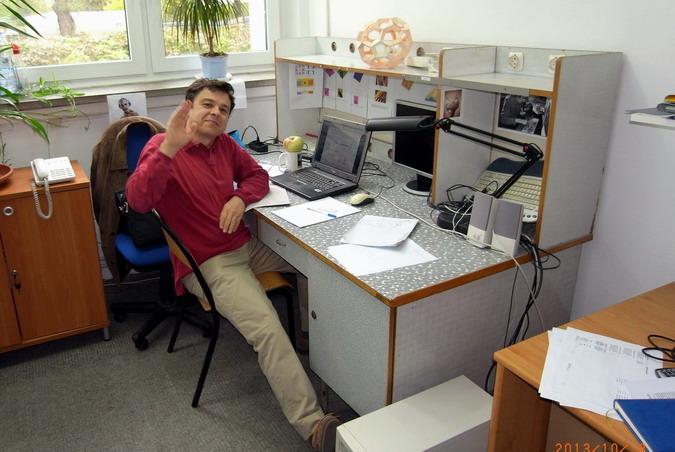 The aim of the visit was to advance numerical capabilities in computing the strength of magnetic order in wurtzite (Ga,Mn)N. The aim of the visit was to advance numerical capabilities in computing the strength of magnetic order in wurtzite (Ga,Mn)N.
Dr. Simserides is a theoretical physicist who with our group carry out theoretical investigations (mostly by massive Monte Carlo simulations) on the nature of ferromagnetism in (Cd,Mn)Te and (Ga,Mn)N. During his visit he became acquainted with tight binding model and numerical code (developed by Prof. Jacek Majewski of the University of Warsaw) of the exchange coupling by the superexchange interaction. He worked then on generalization this code for the wurtzite structure, with the Jahn-Teller effect and the spin-orbit interaction taken into account. Furthermore, he was working on the critical behavior near the Curie temperature in (Ga,Mn)N as seen by the Monte Carlo interaction, the issue studied experimentally in our group by MSc. Sylwia Stefanowicz and Prof. Maciej Sawicki.
|
- • prof. Ewa Jędryka - Visits from a group of prof. Josep Fontcuberta from the Institut de Ciència de Materials de Barcelona (ICMAB -CSIC) in Spain
In frames of the task 2.12 the NMR group has initiated twinning activities with the group of Prof. Josep Fontcuberta from the Institut de Ciència de Materials de Barcelona (ICMAB–CSIC) in Spain. The cooperation is aimed at elaboration of experimental routine to study the properties of thin films of magnetic oxides using NMR method. In particular, the study is focused on the investigation of interfaces with the buffer and capping layer and their influence on the properties of the studied oxide. Mr. David Pesquera from ICMAB–CSIC spent three months (July - September 2013) working with the NMR team in Warsaw on these issues. In September, two senior researchers from ICMAB–CSIC : Dr. Anna Roig and Dr. Florencio Sánchez have joined the team for one week to conclude the joint efforts. The experimental protocols for this kind of investigations have been established.
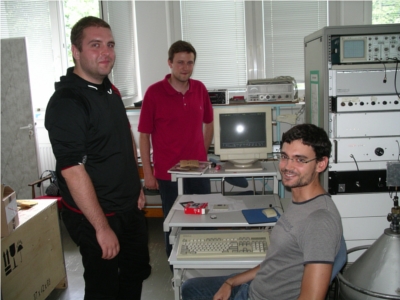
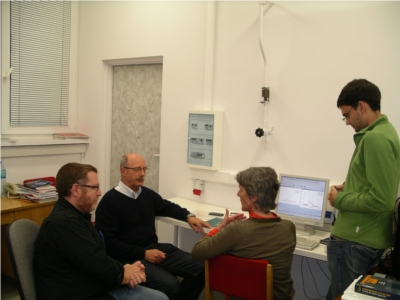
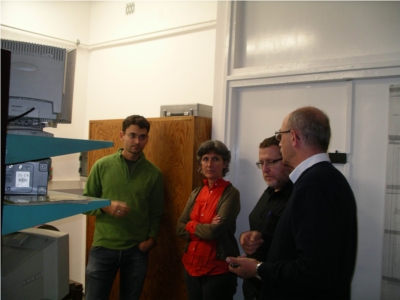








 Fig.1.
Fig.1.





































































